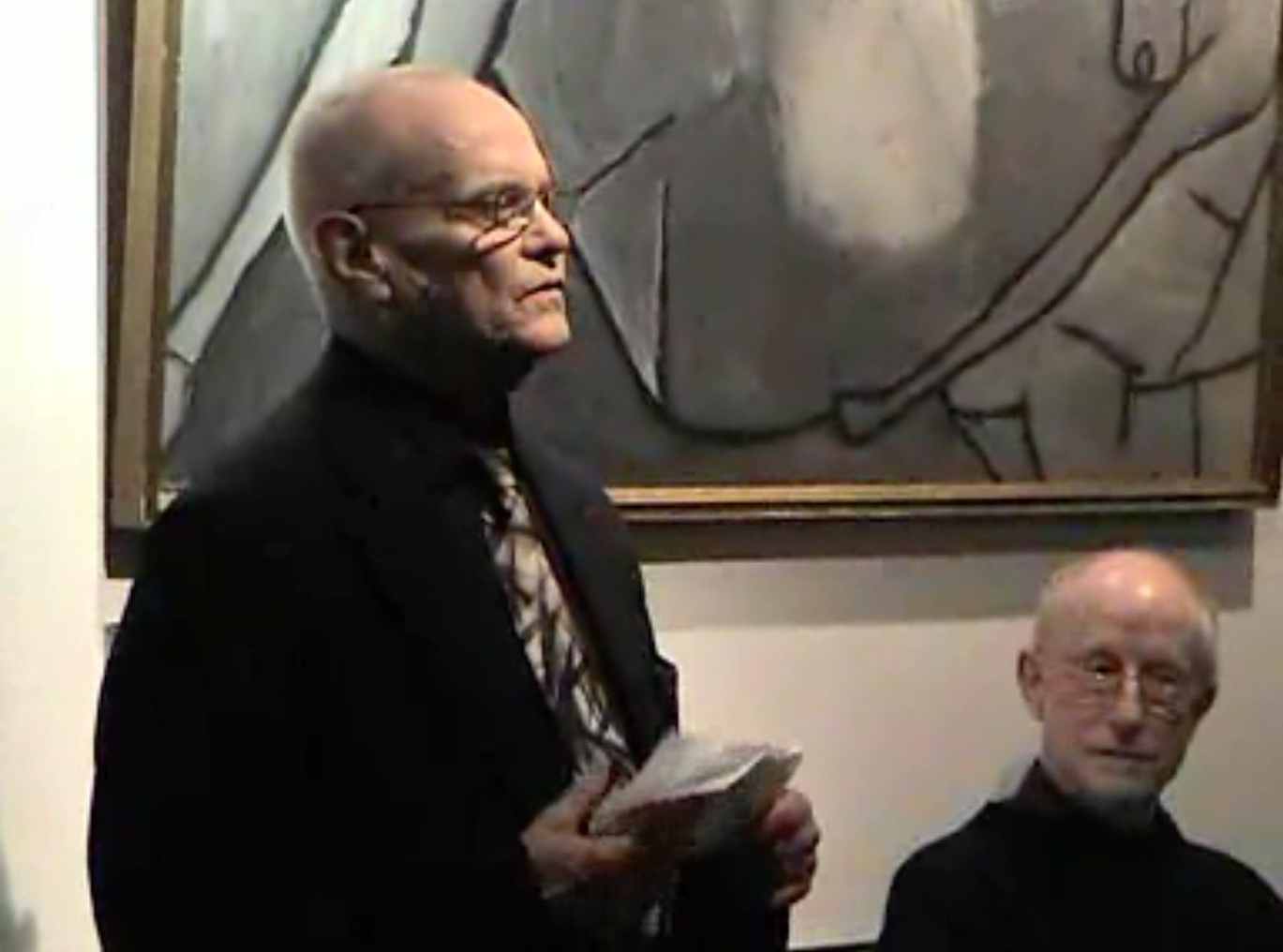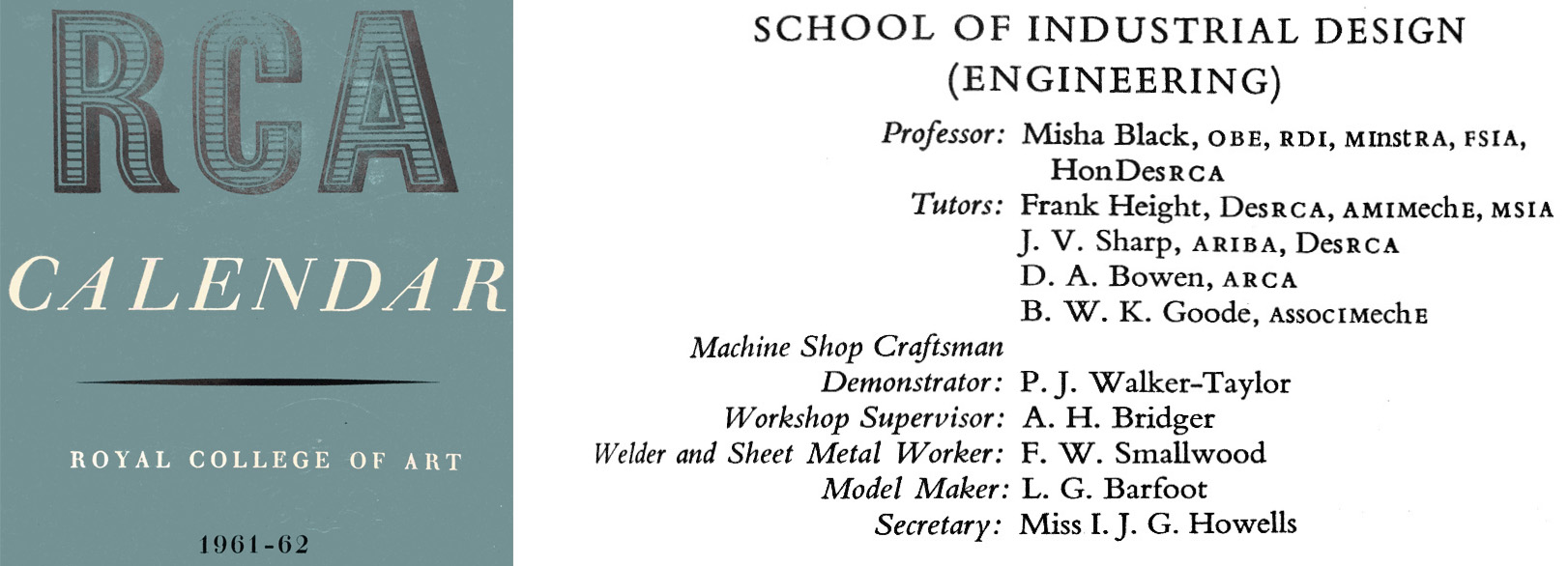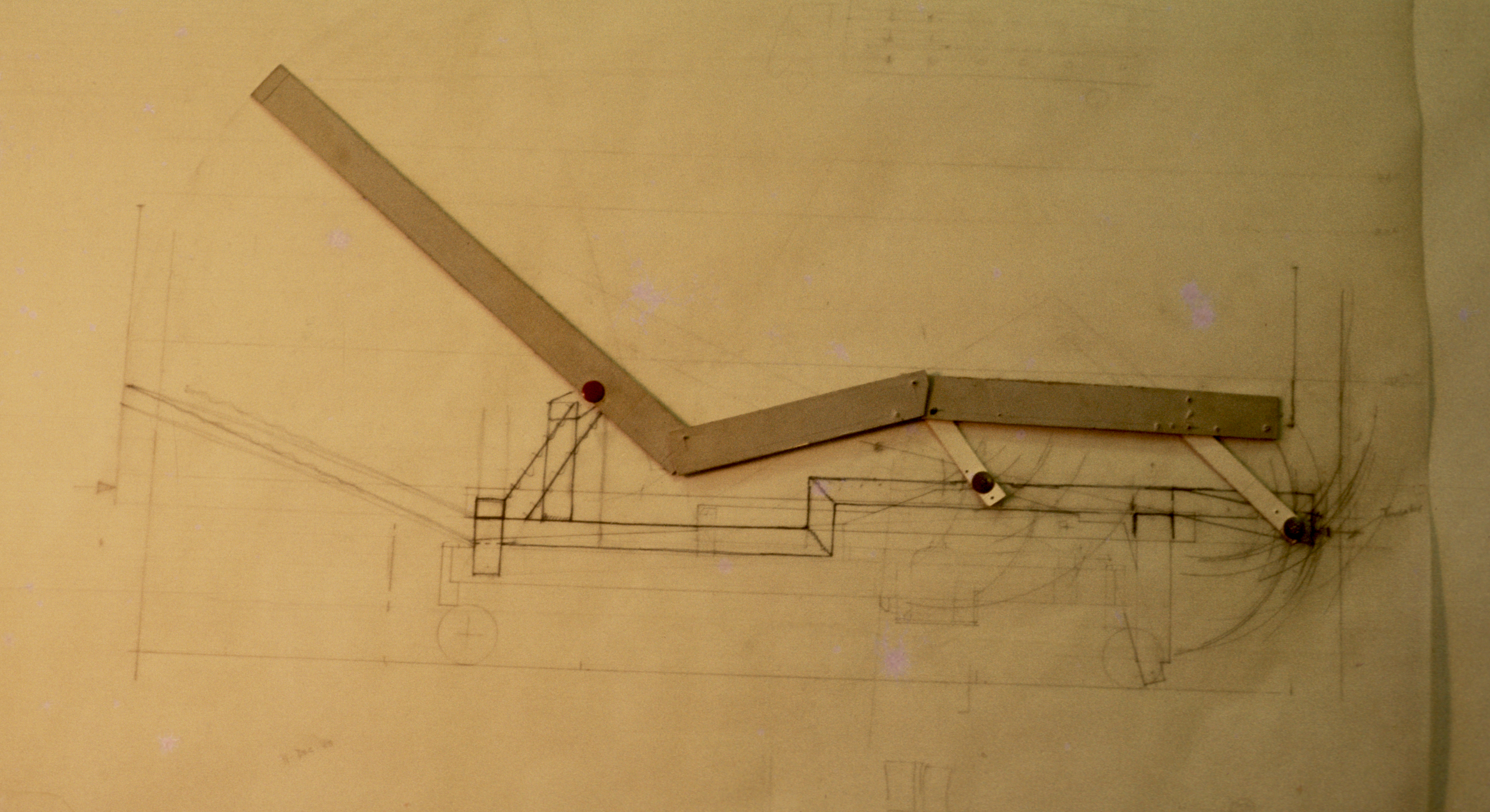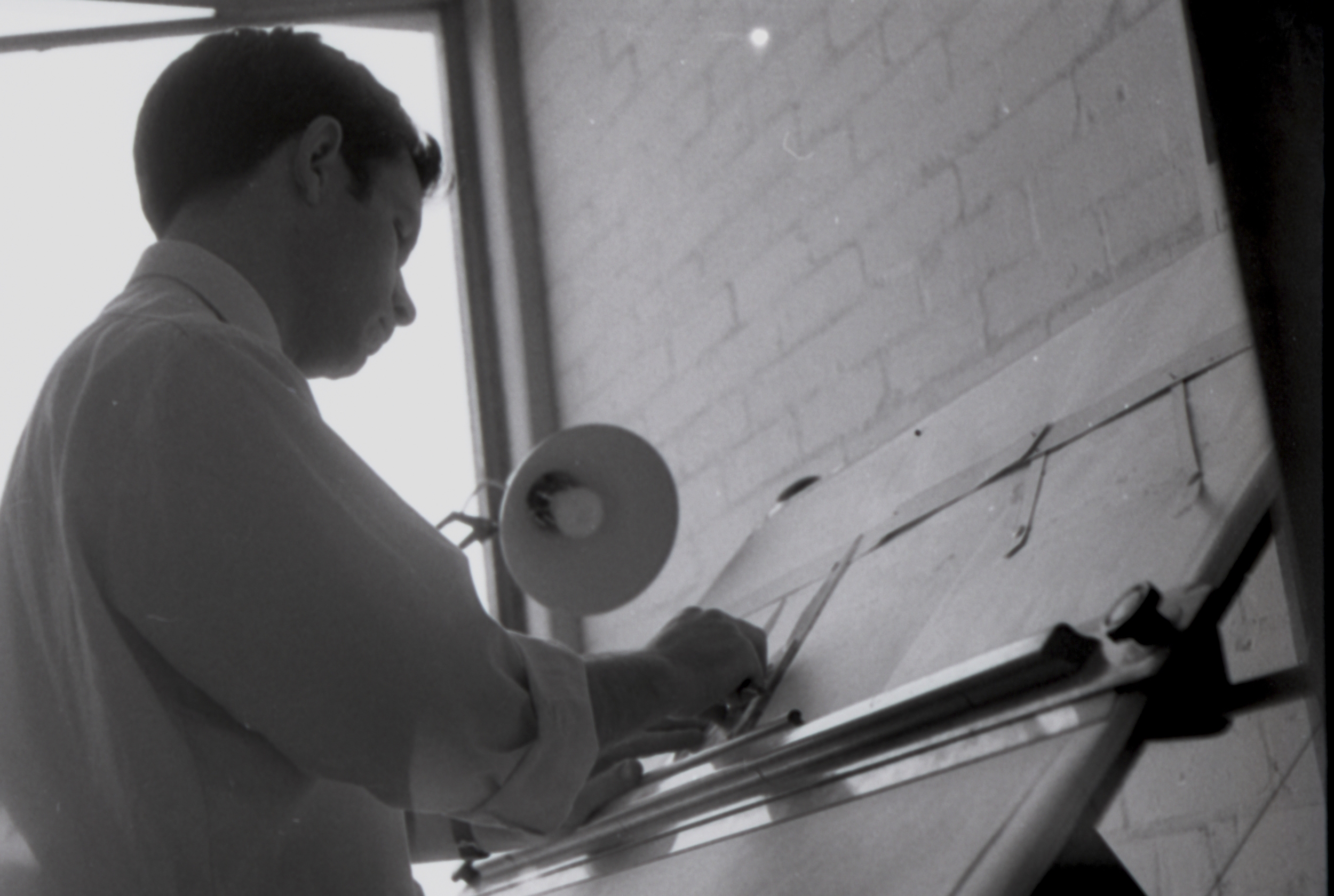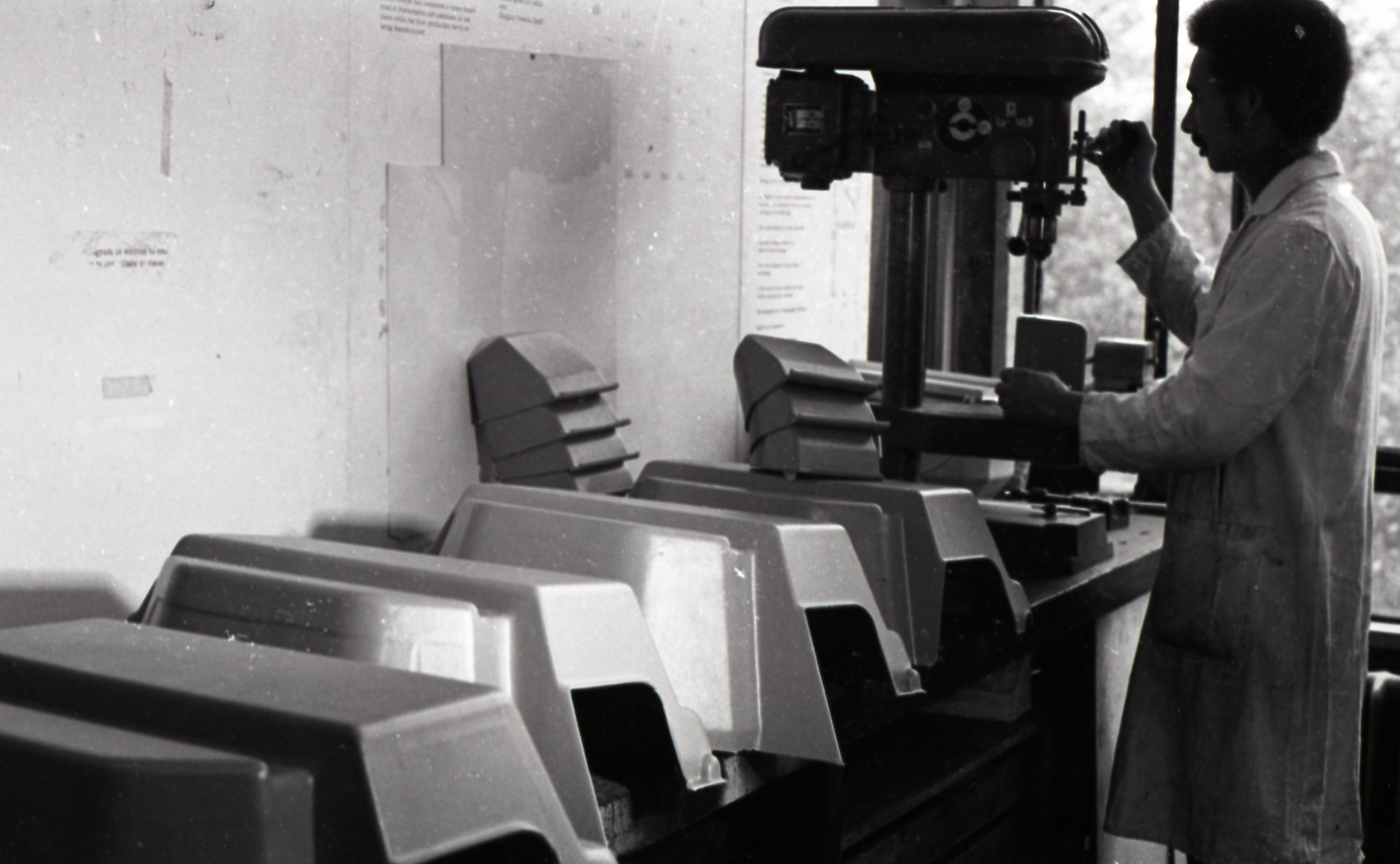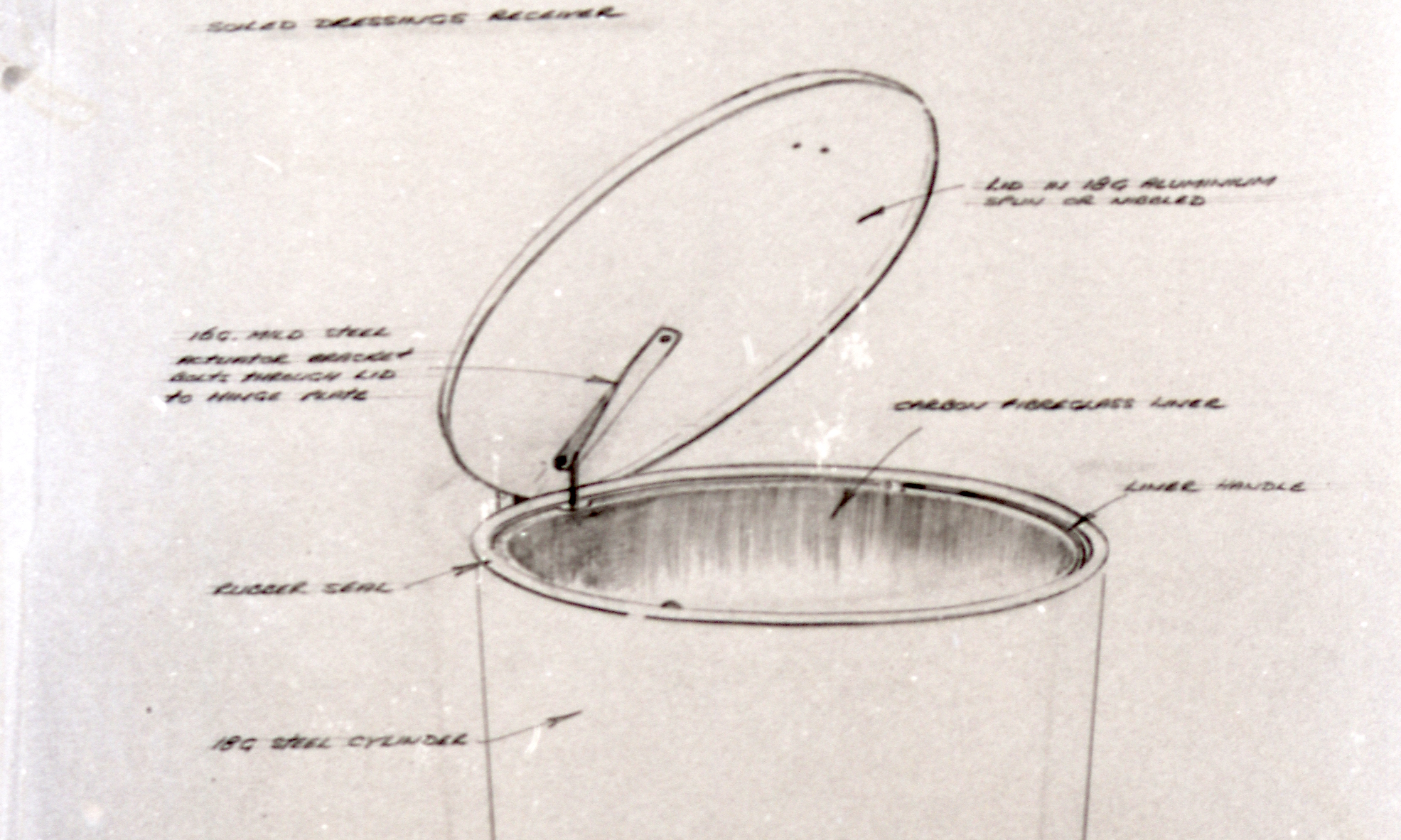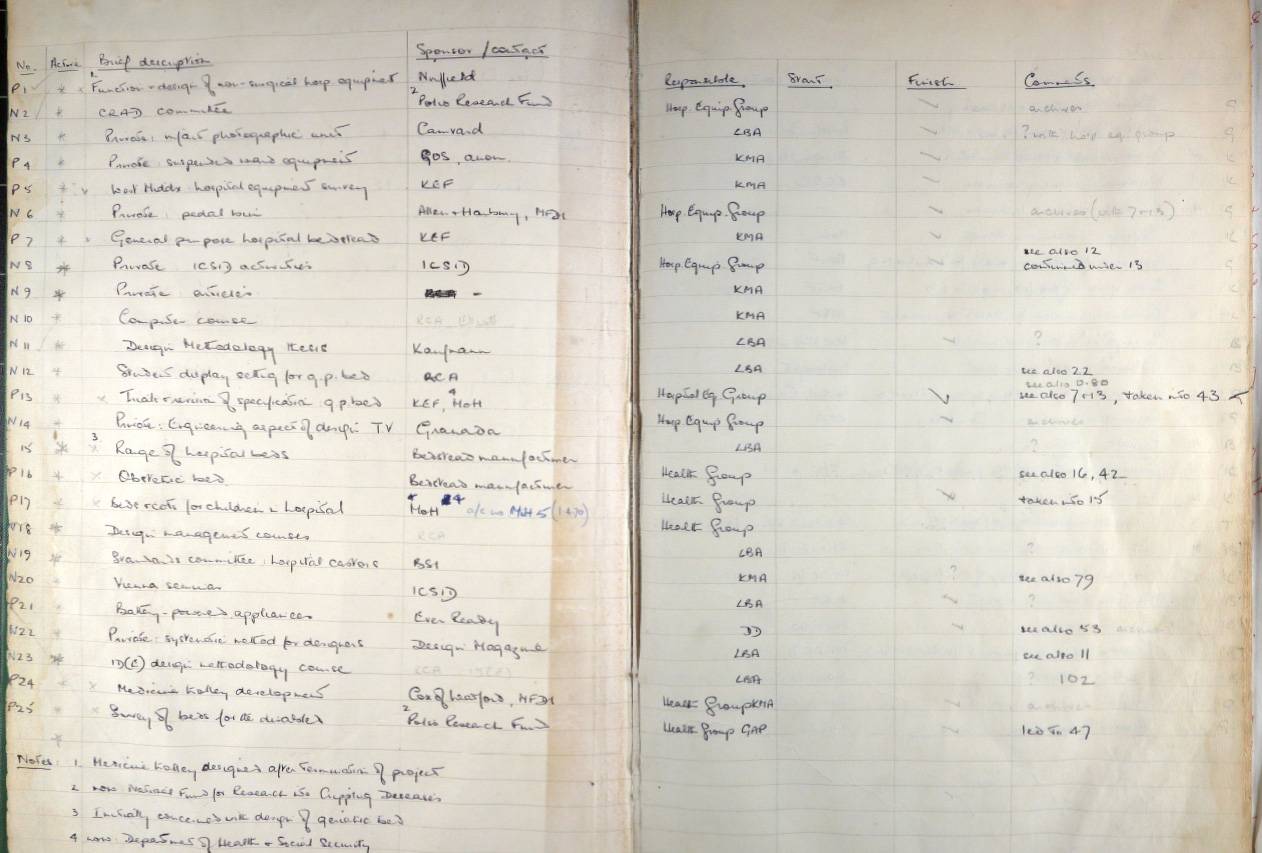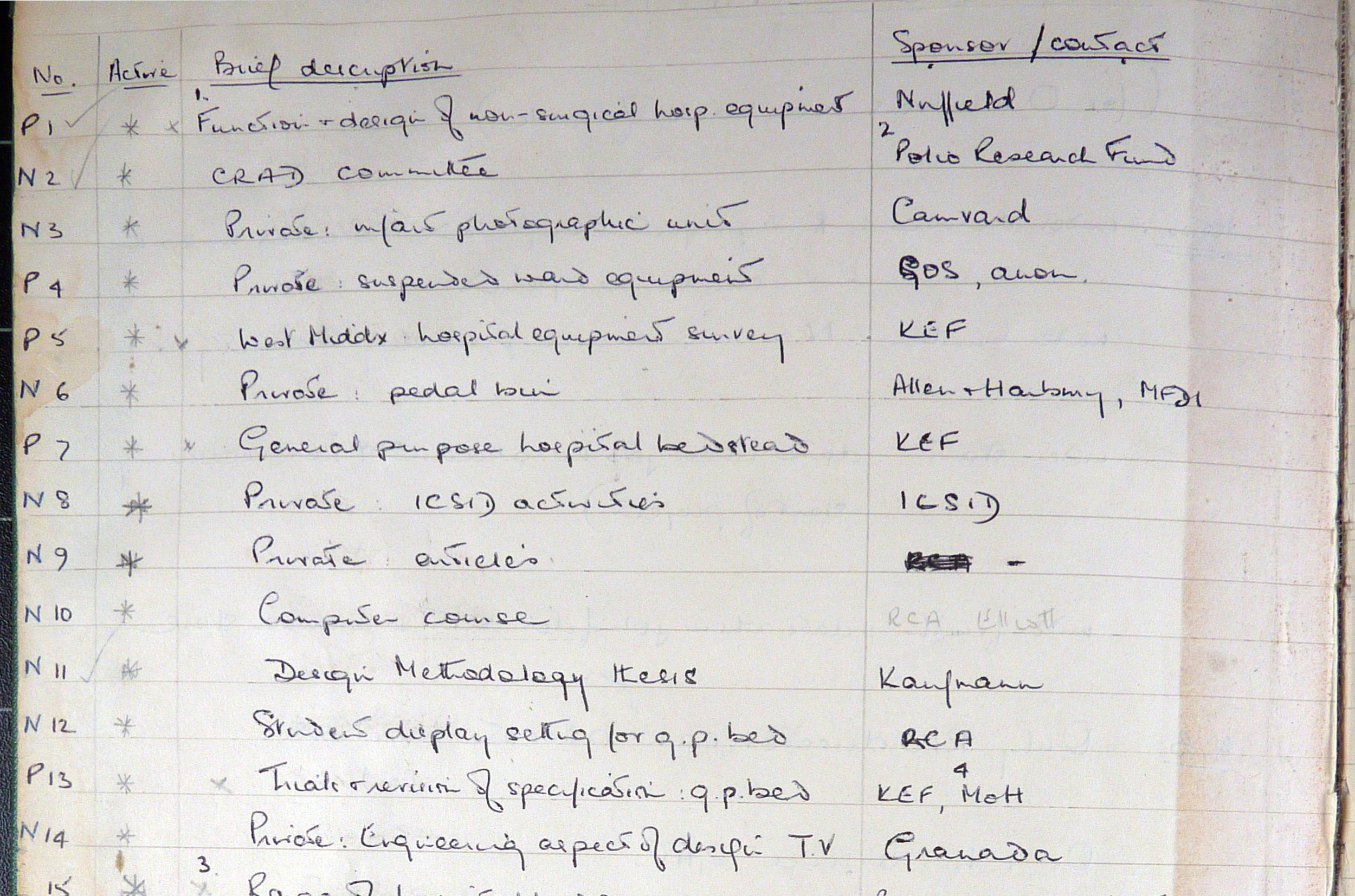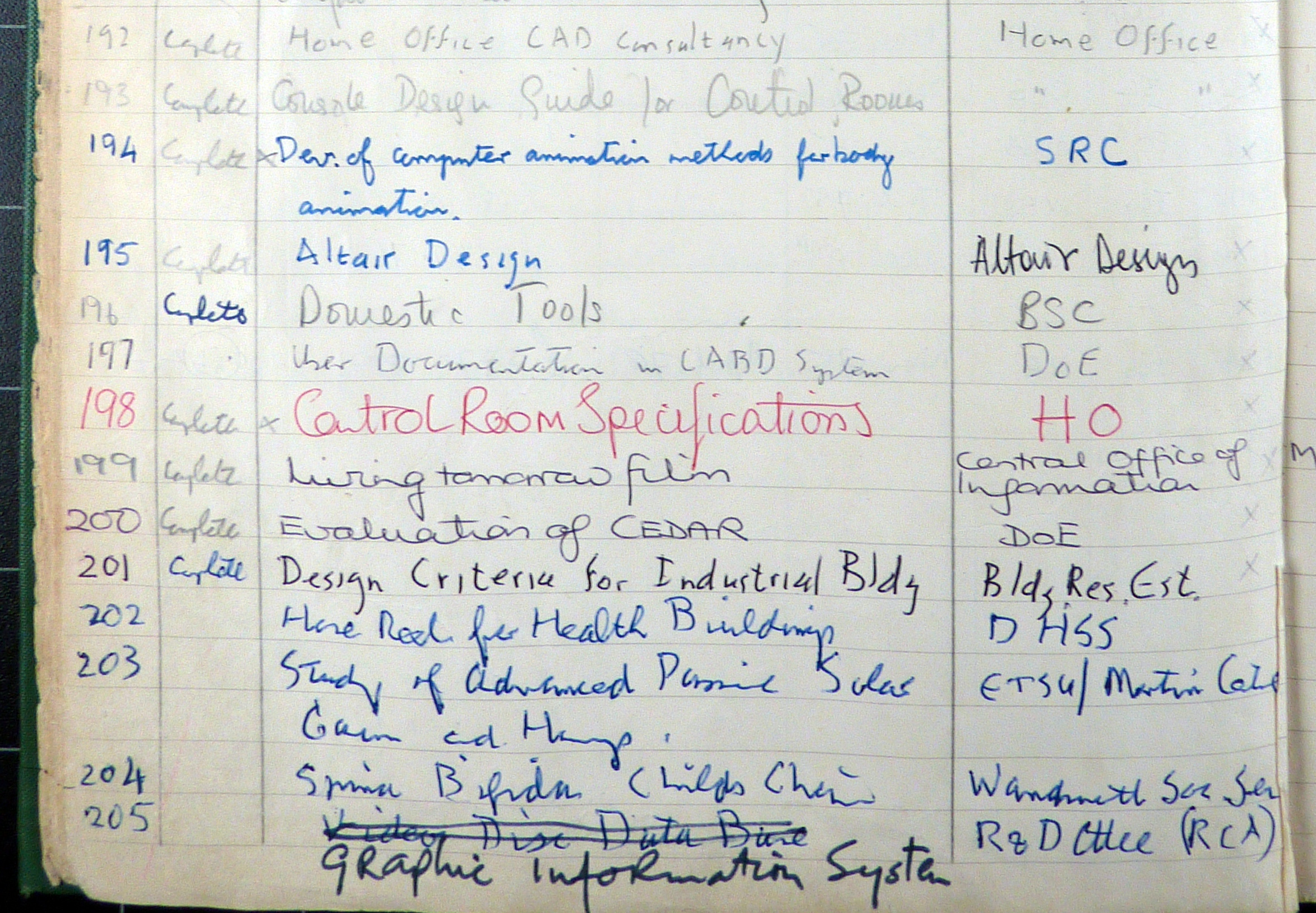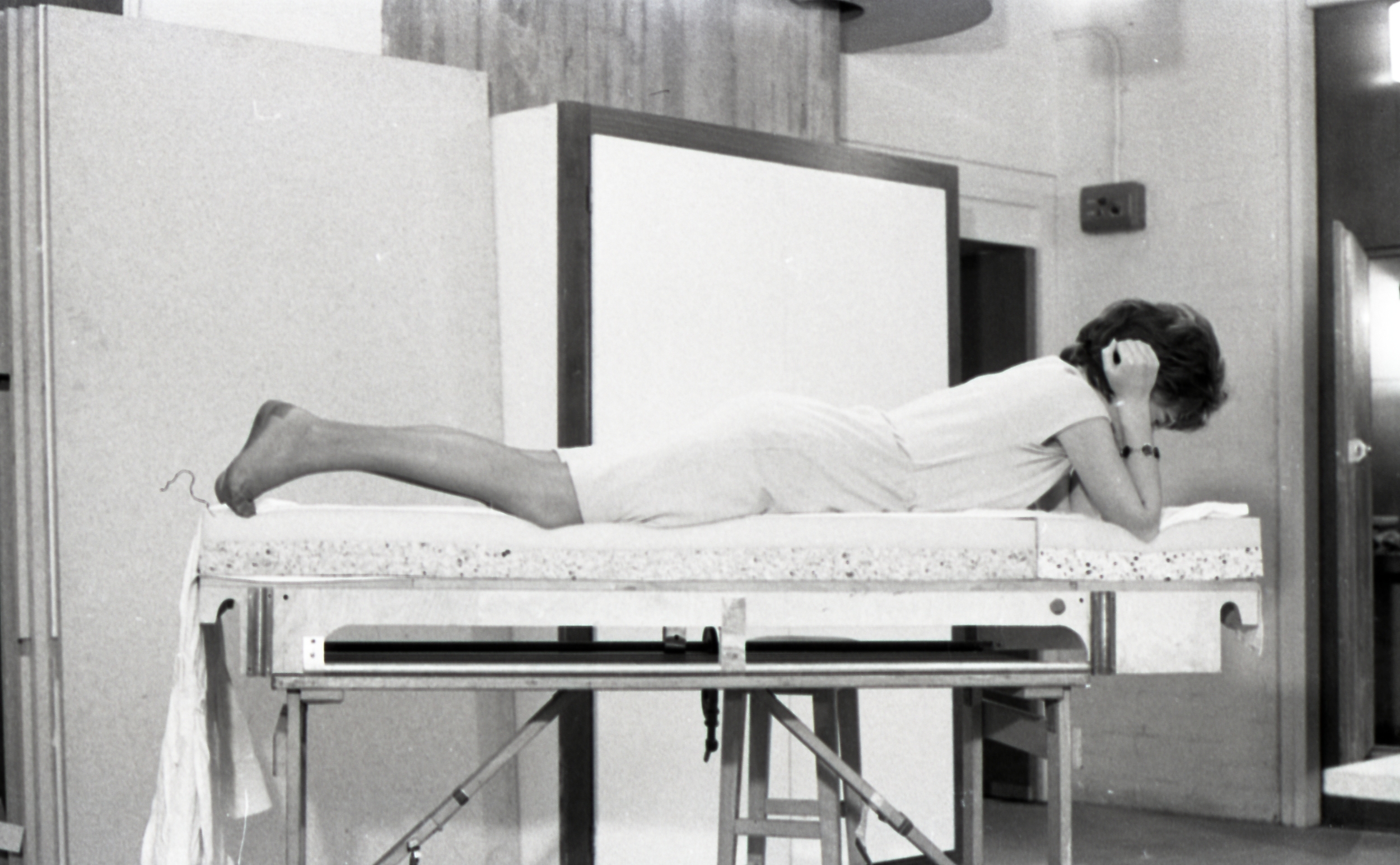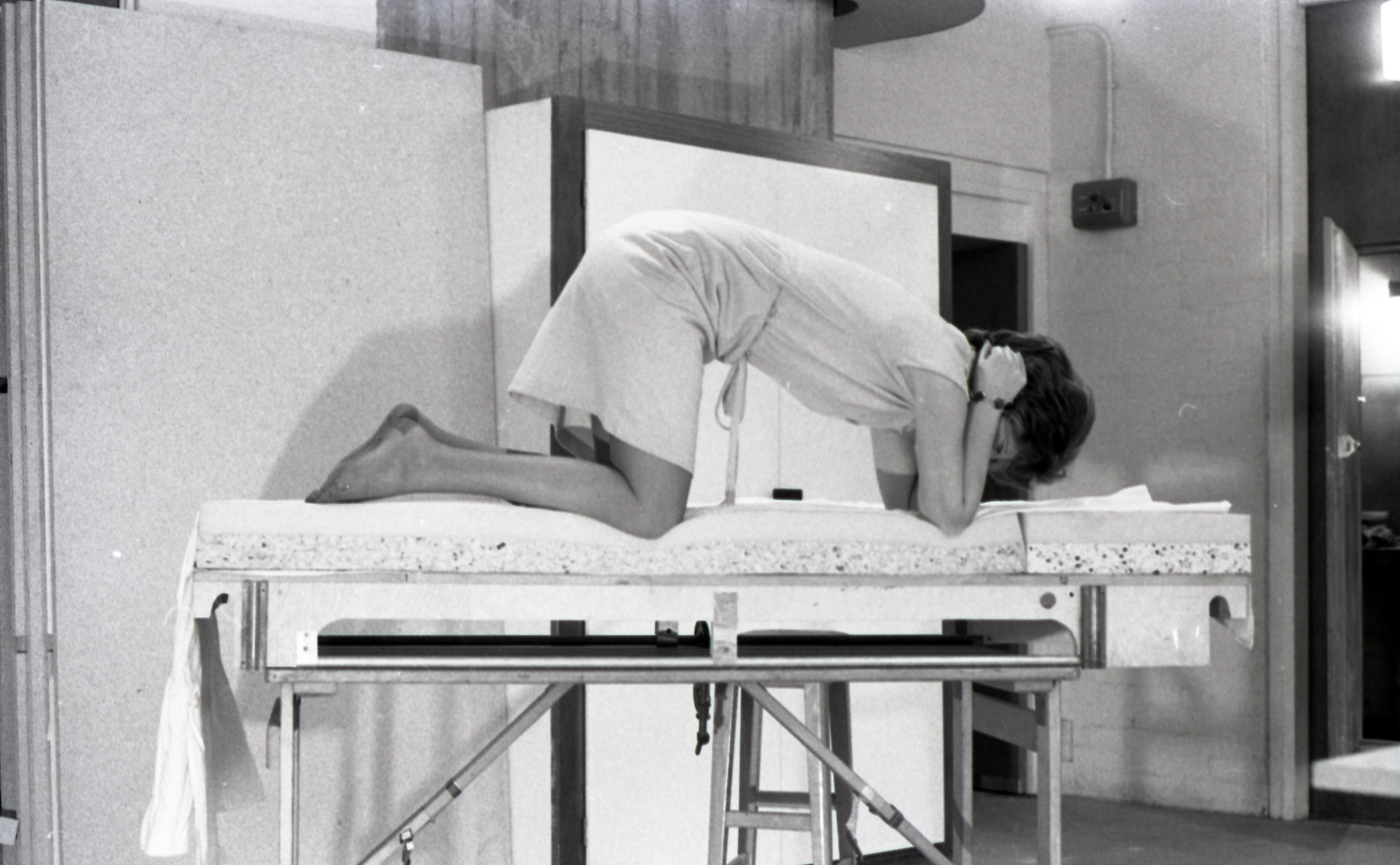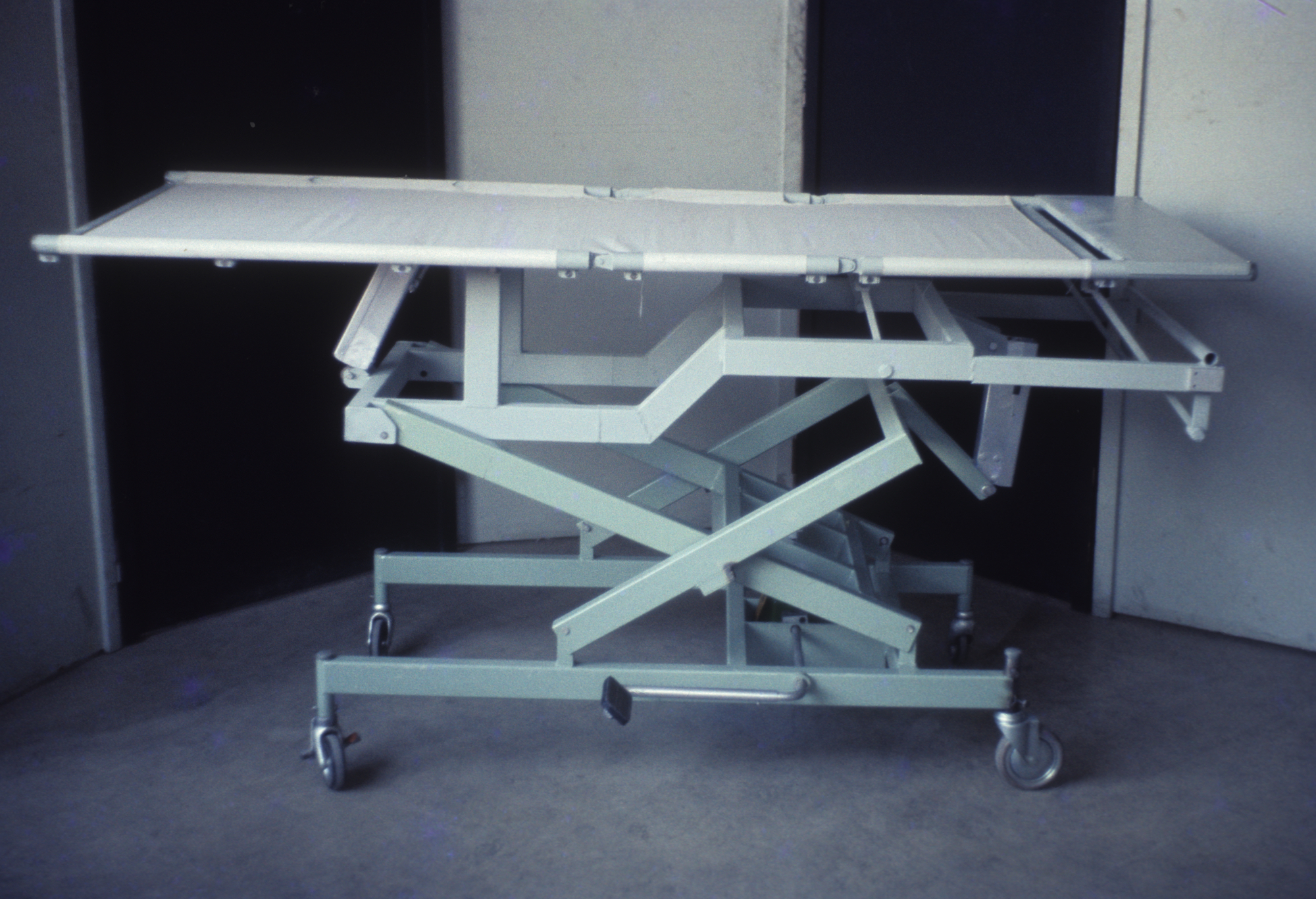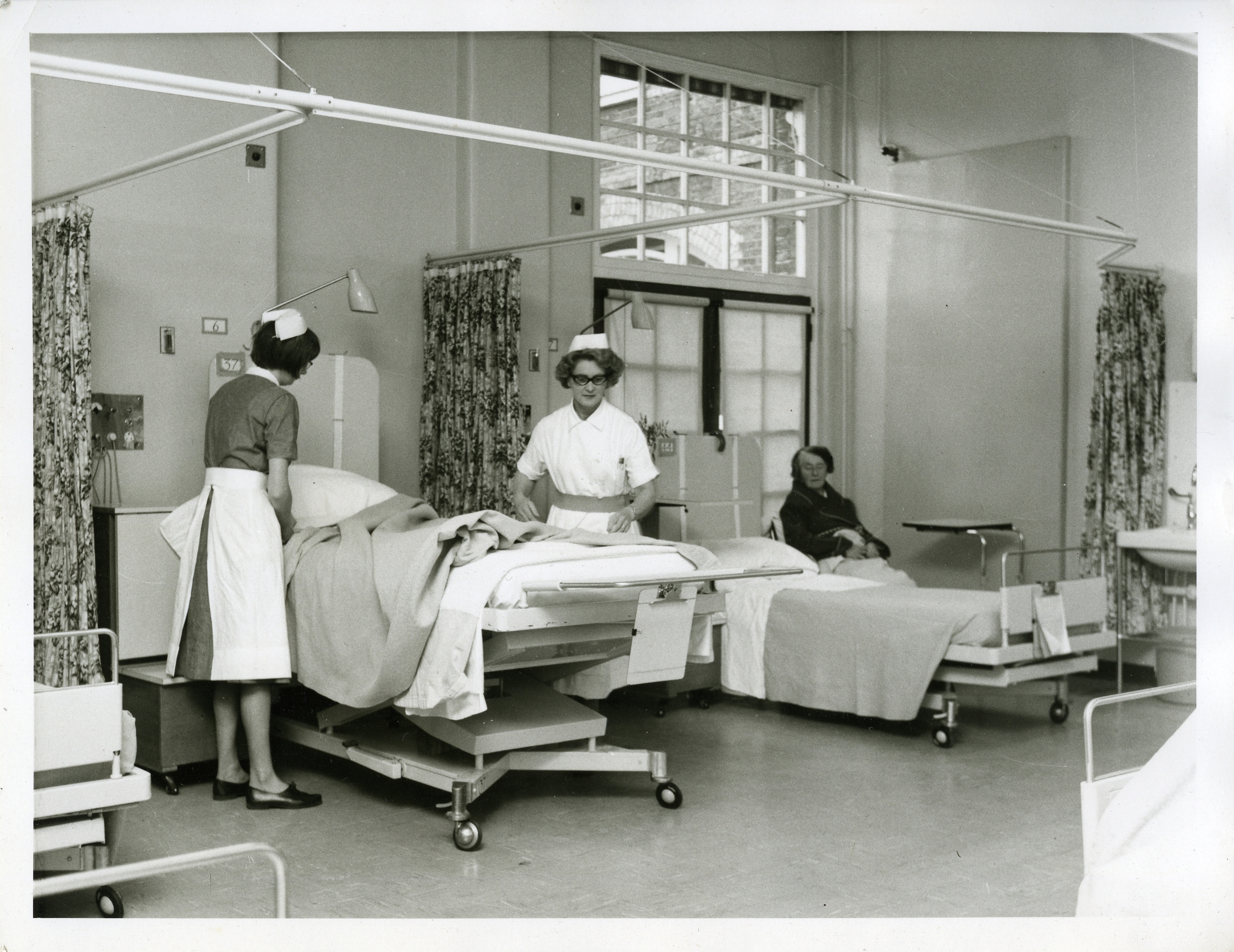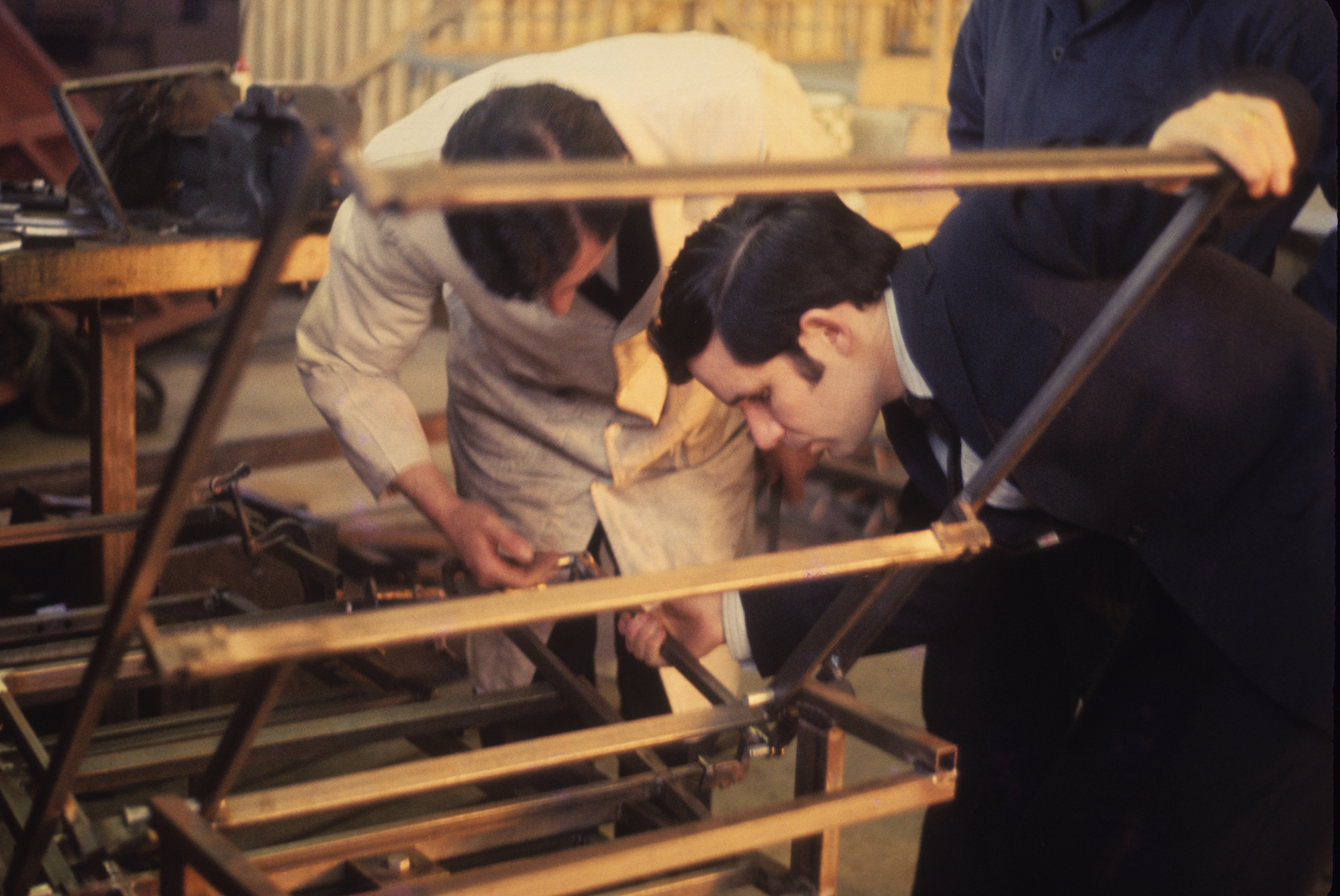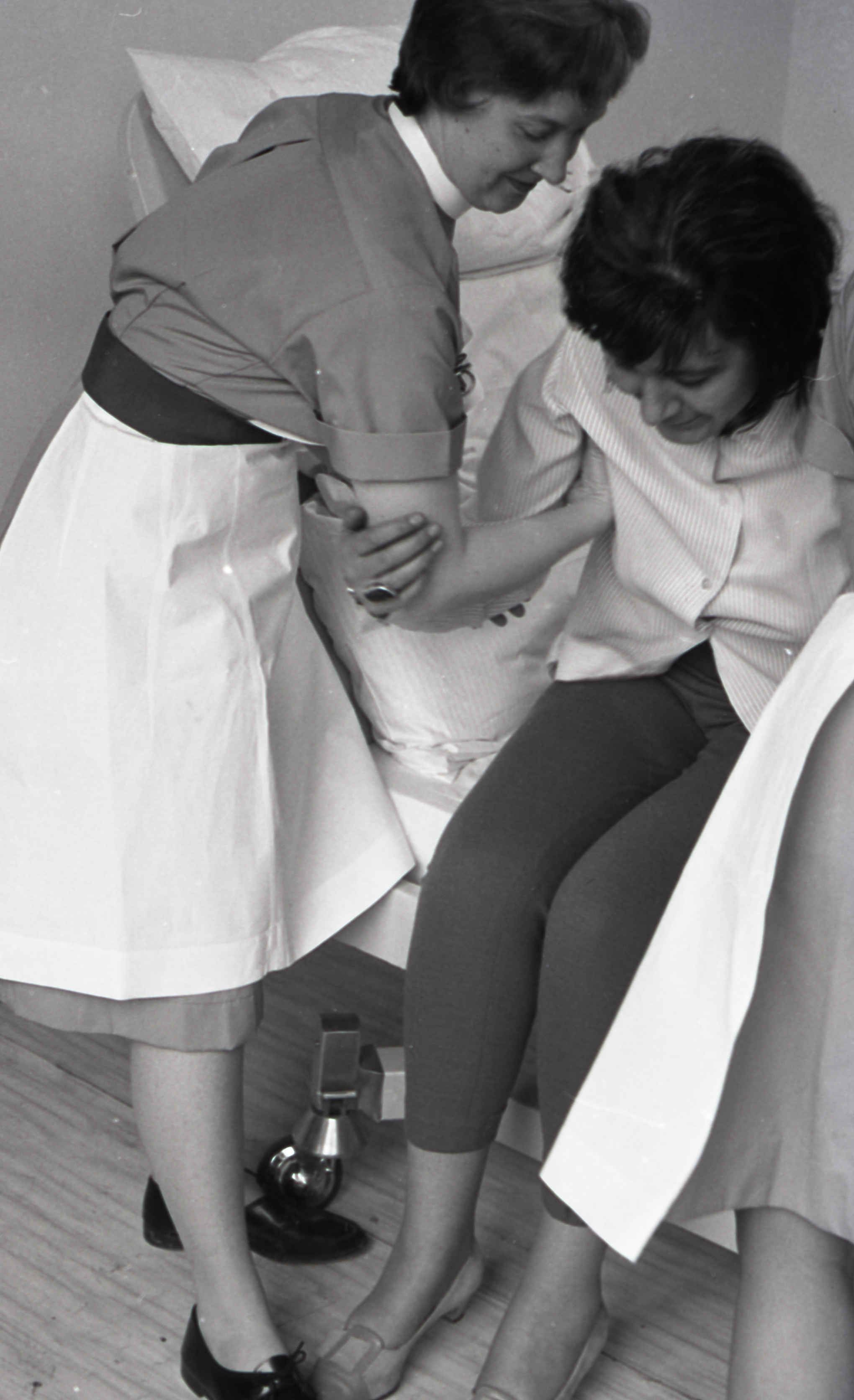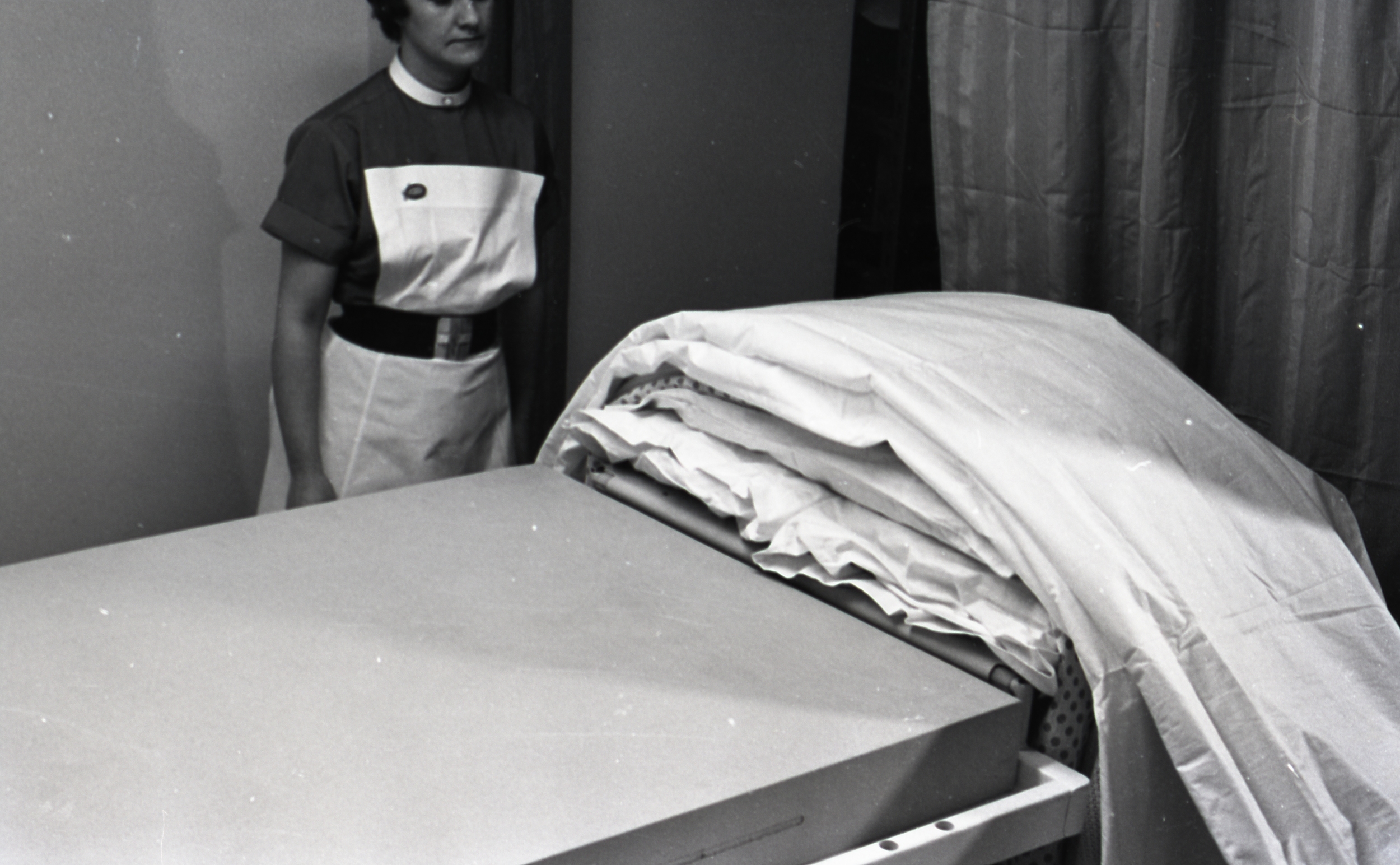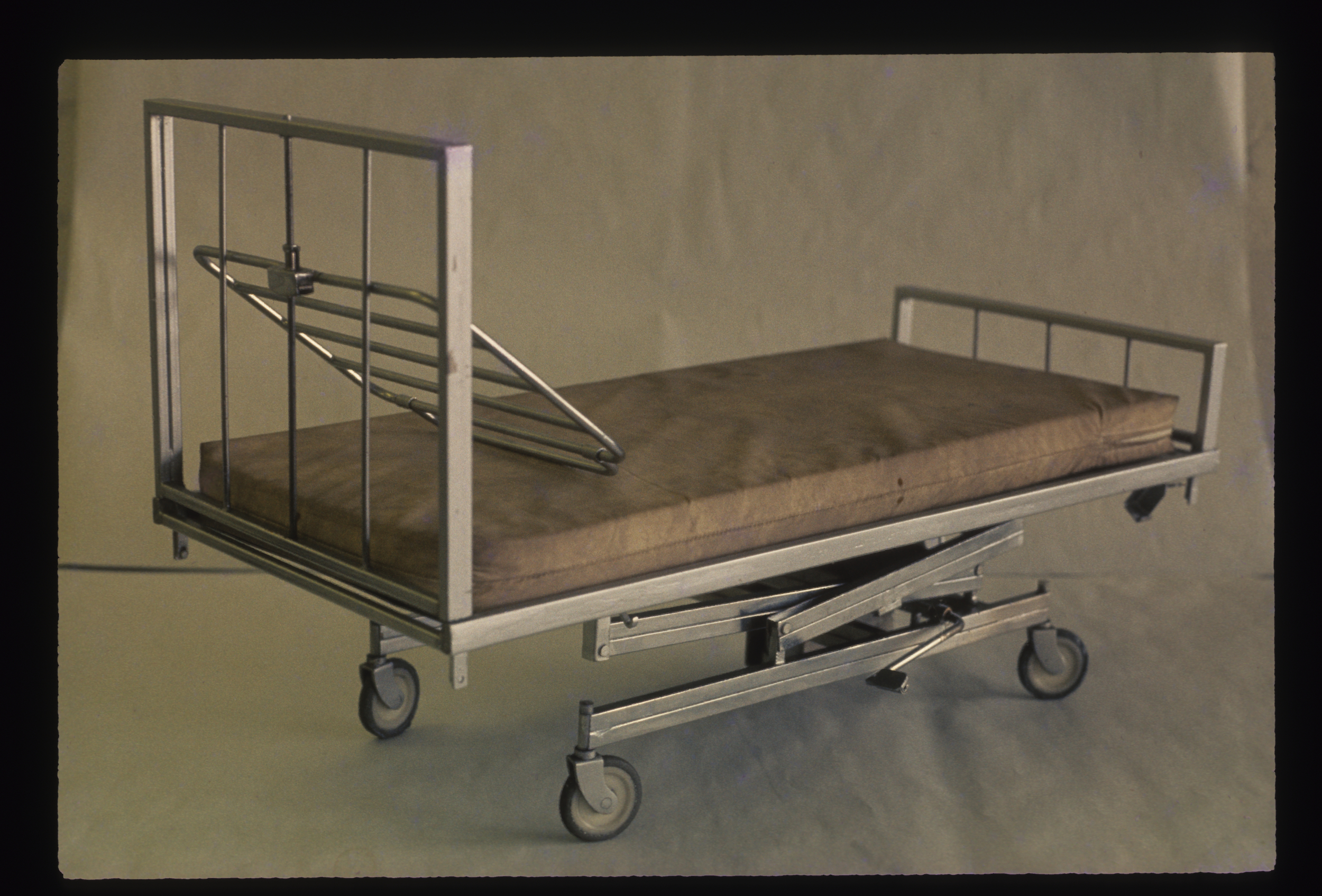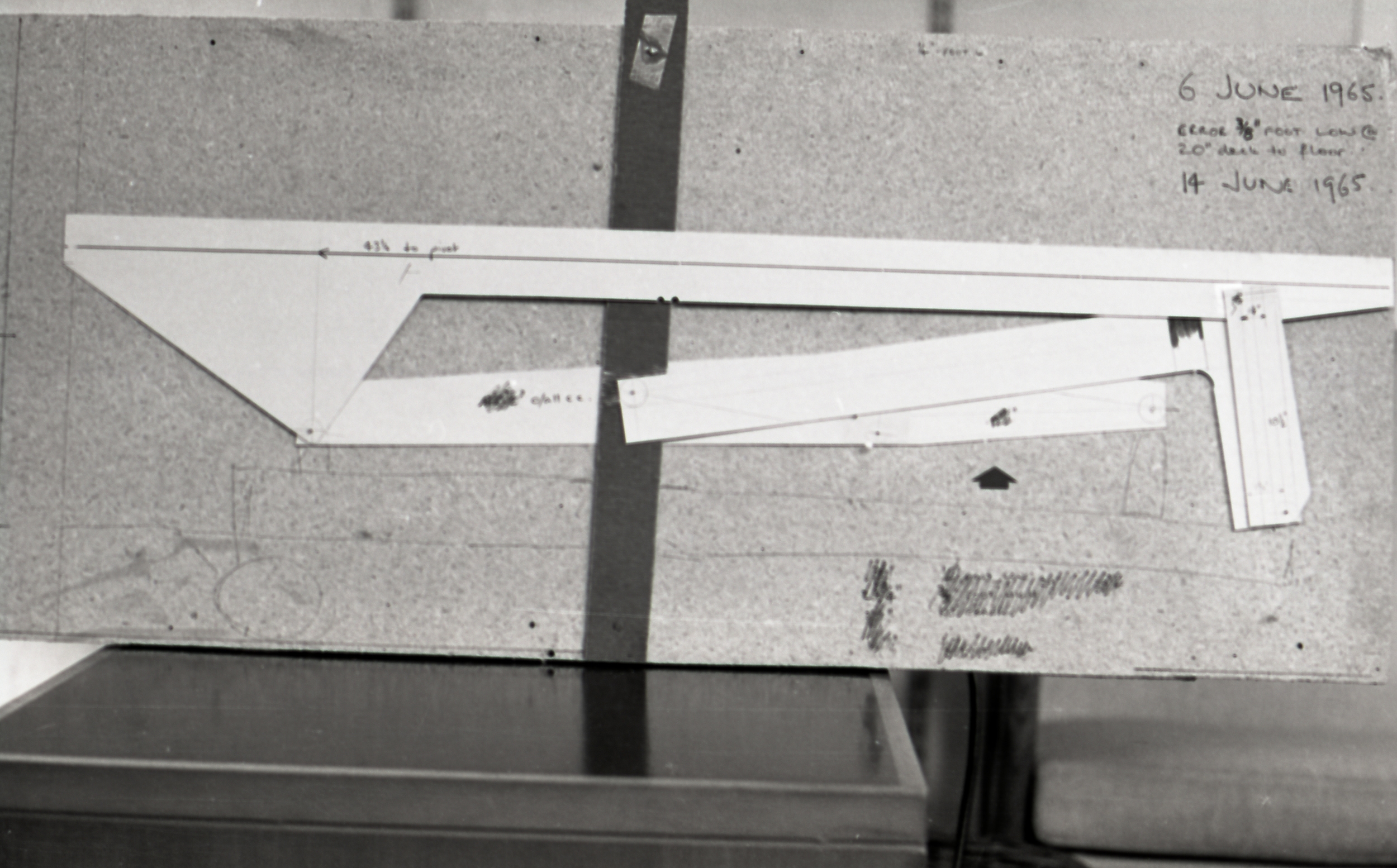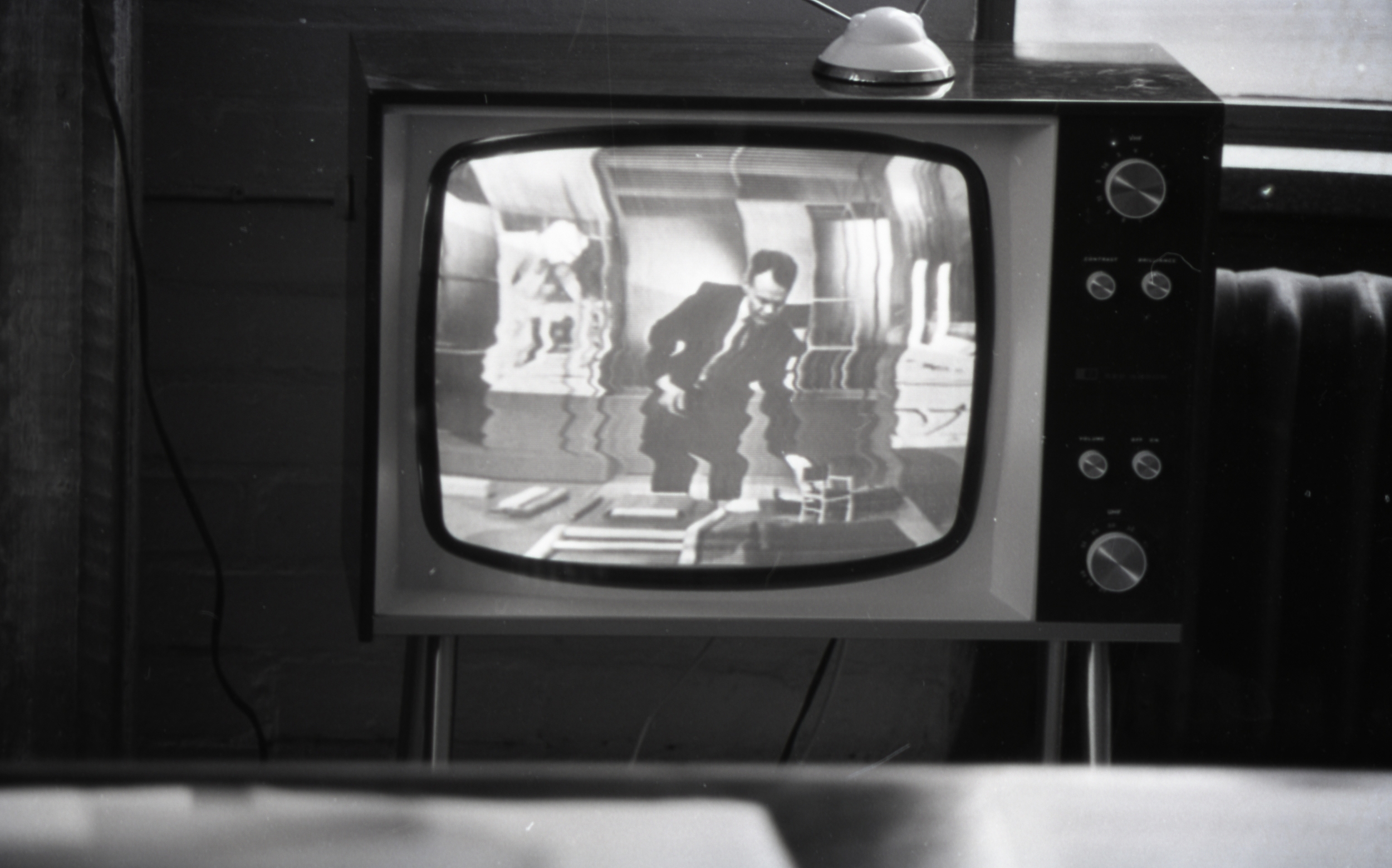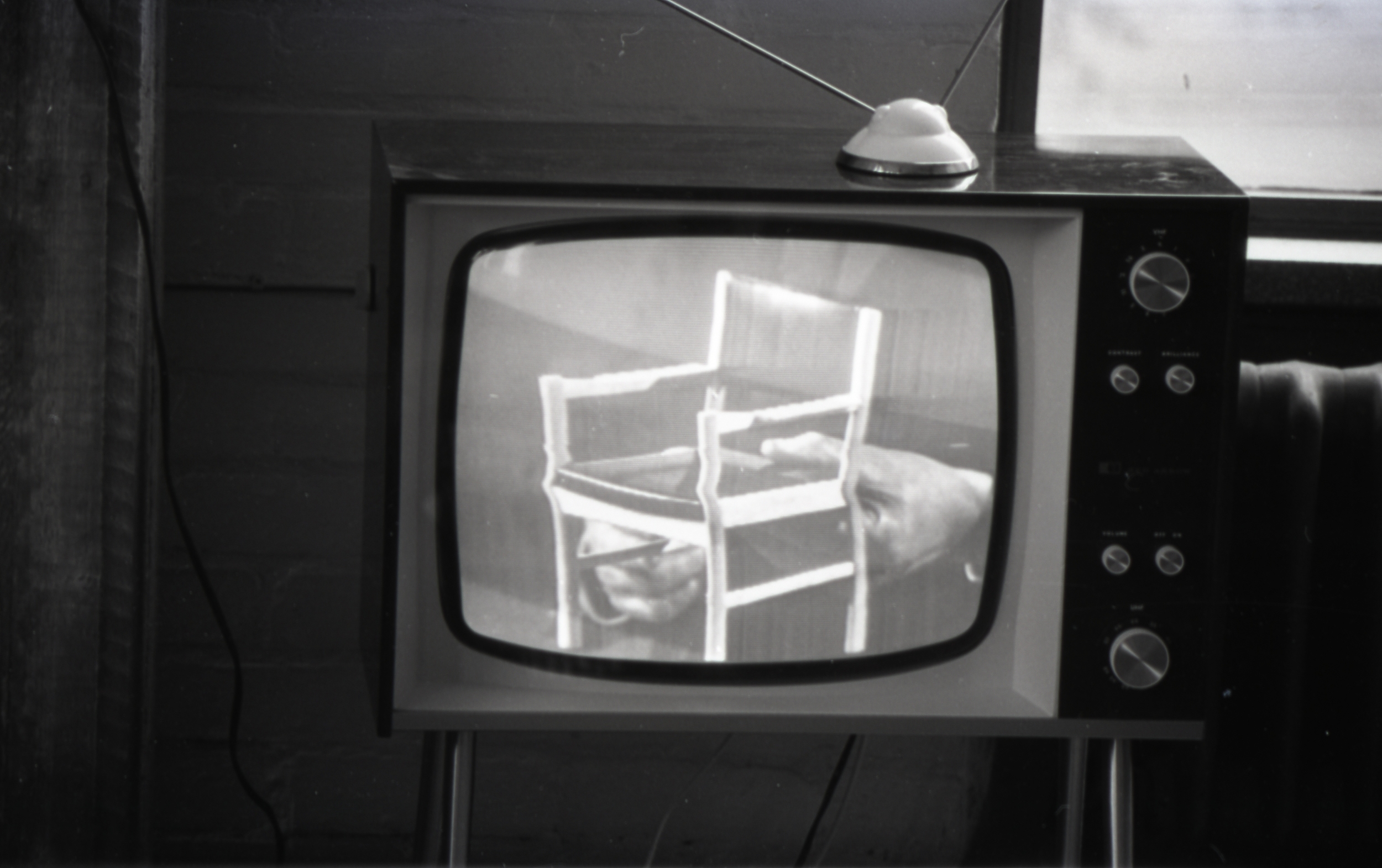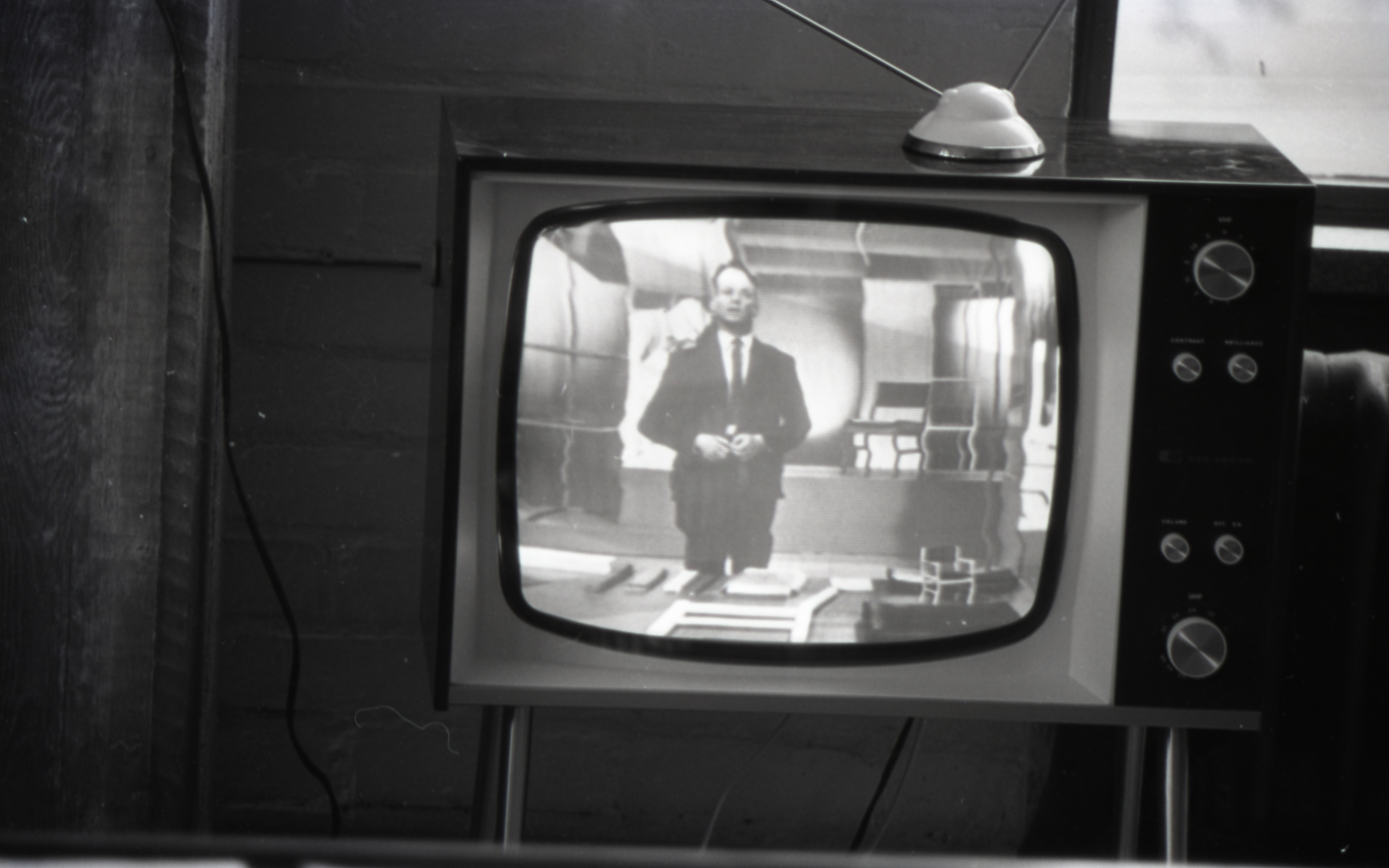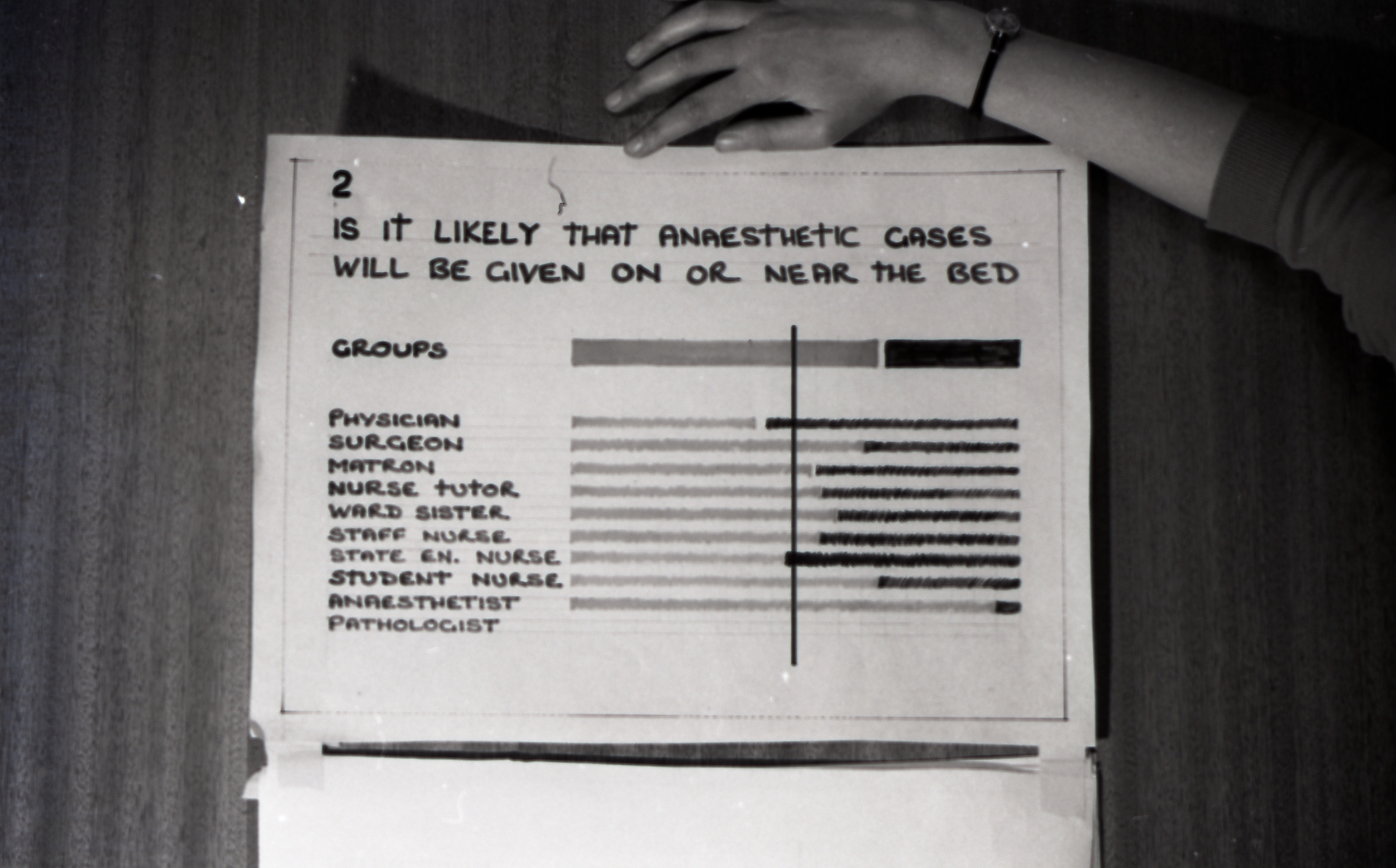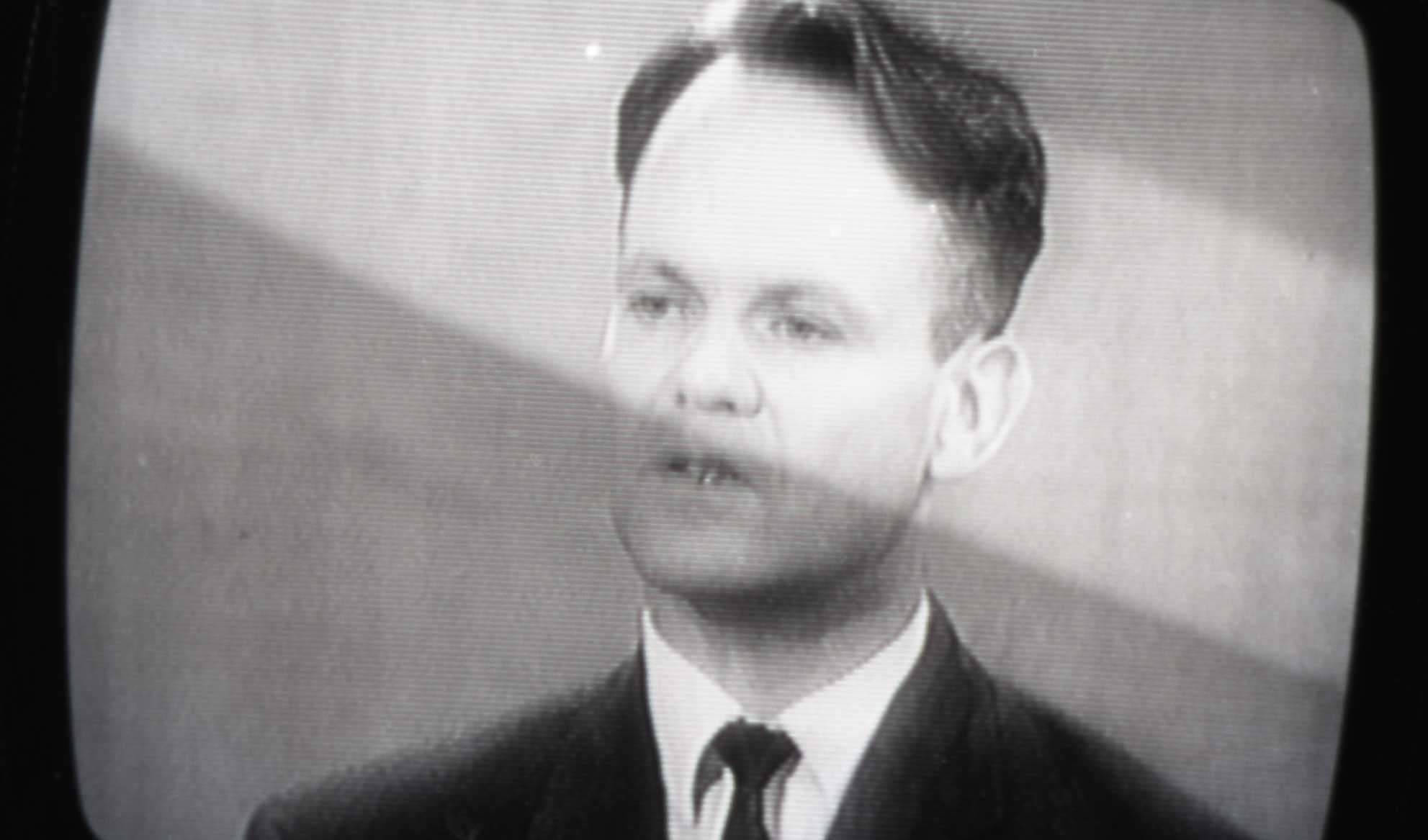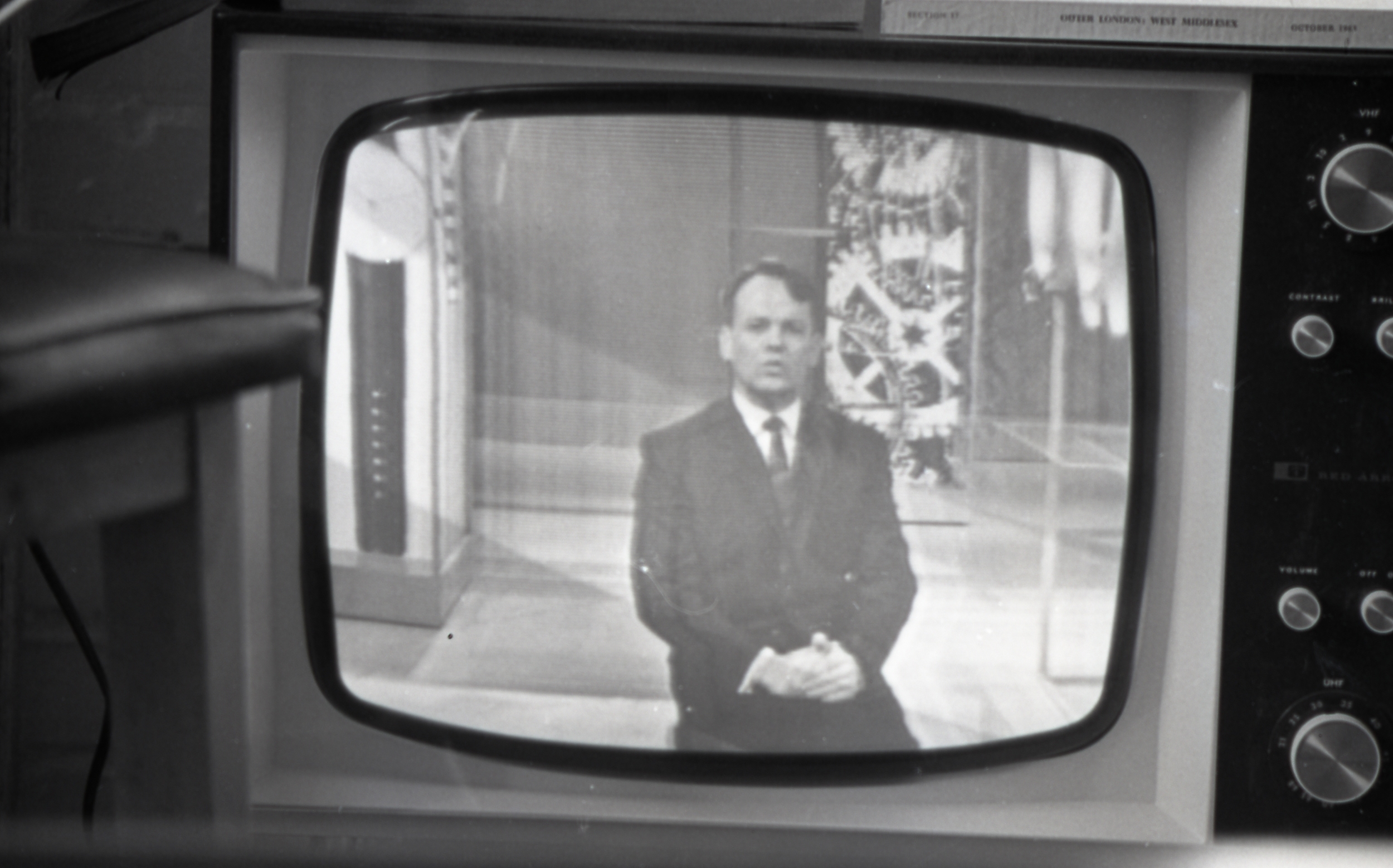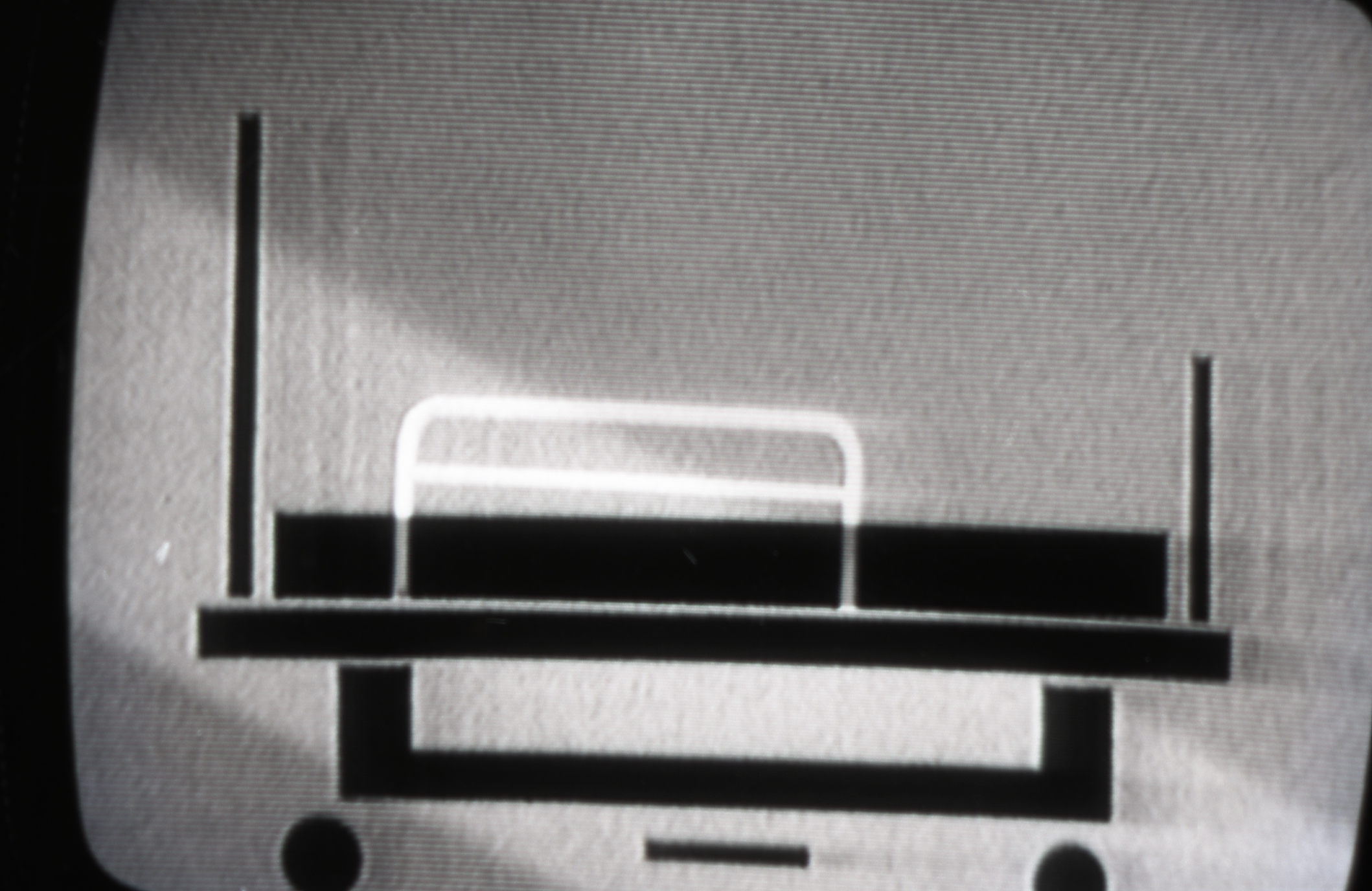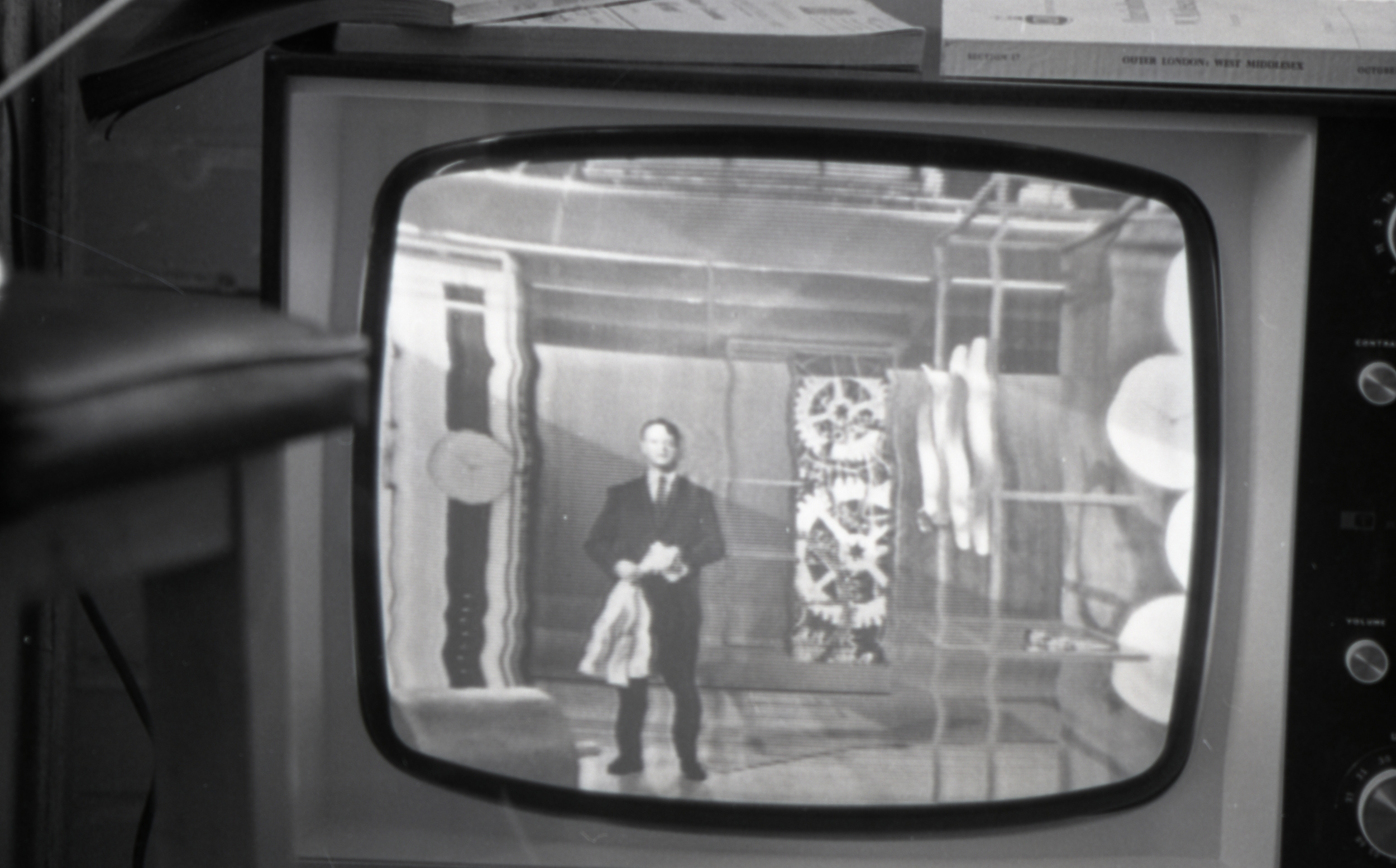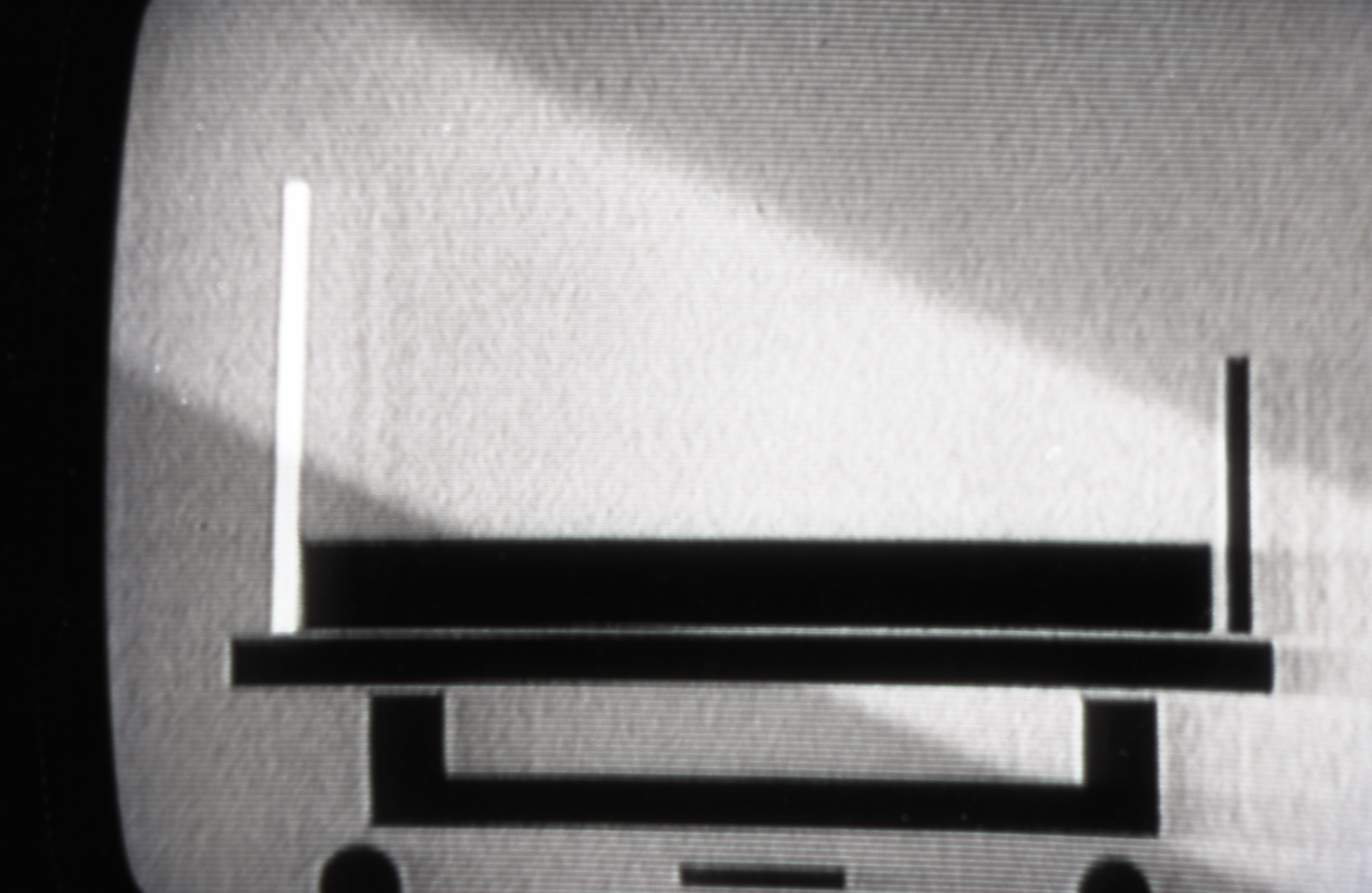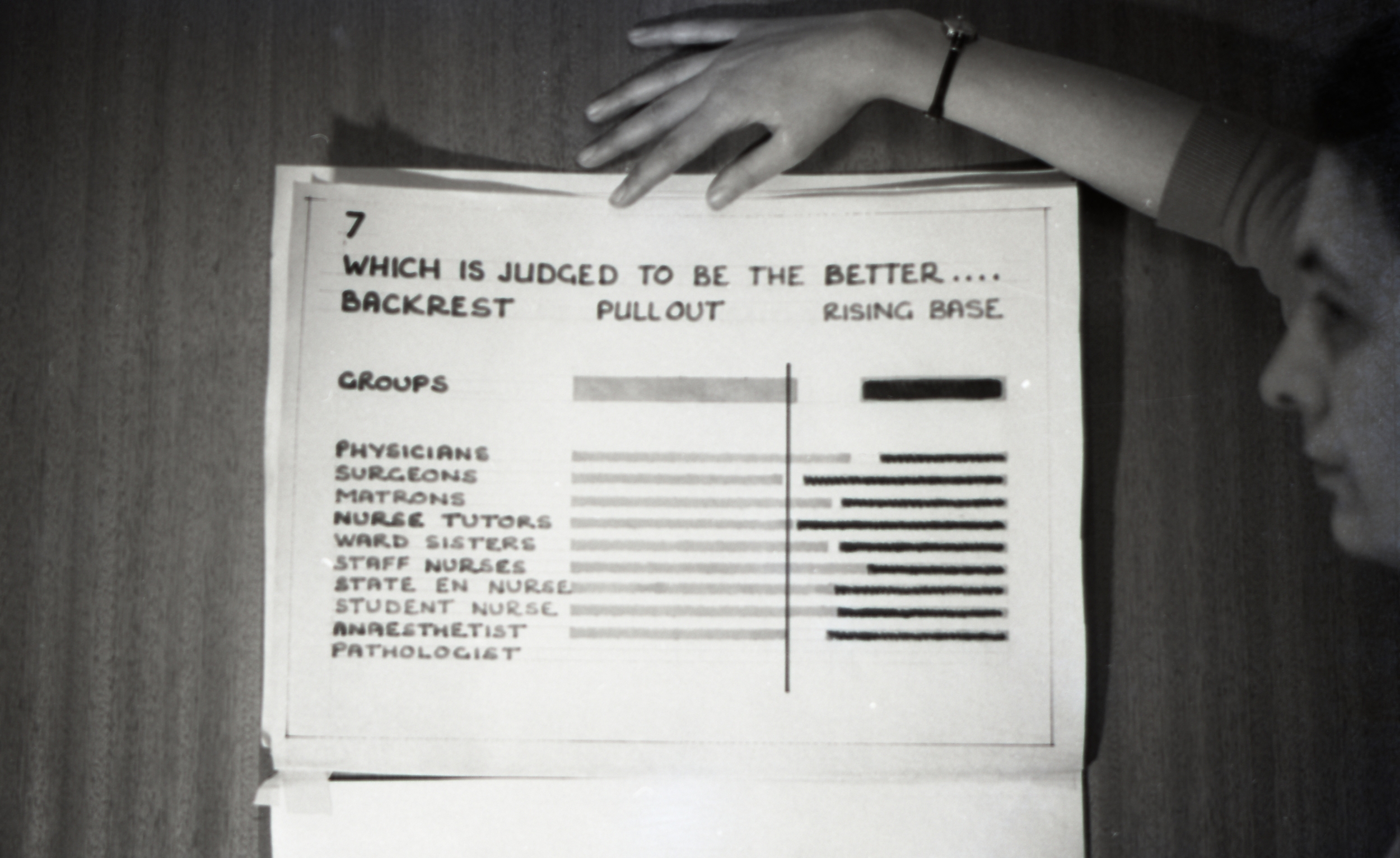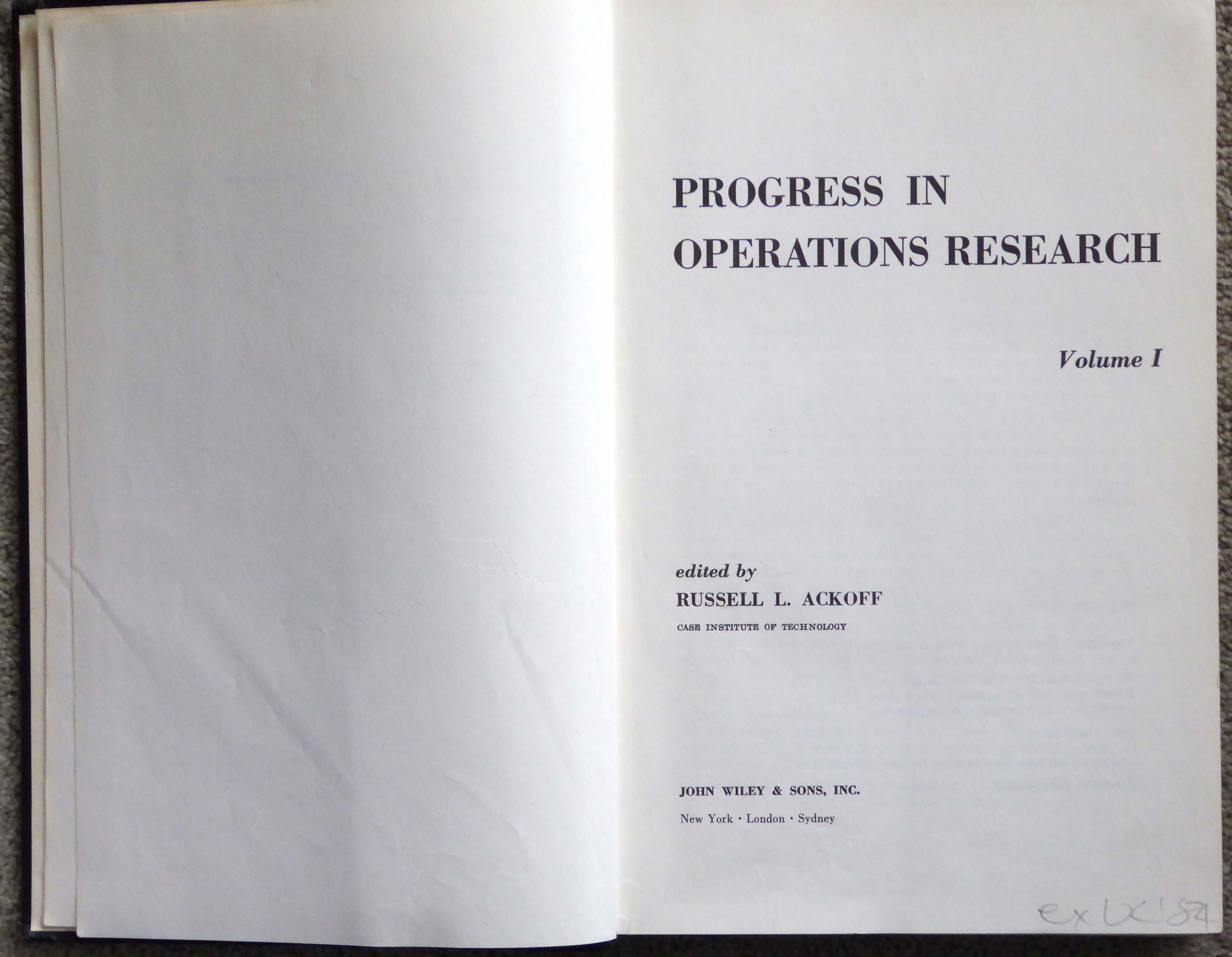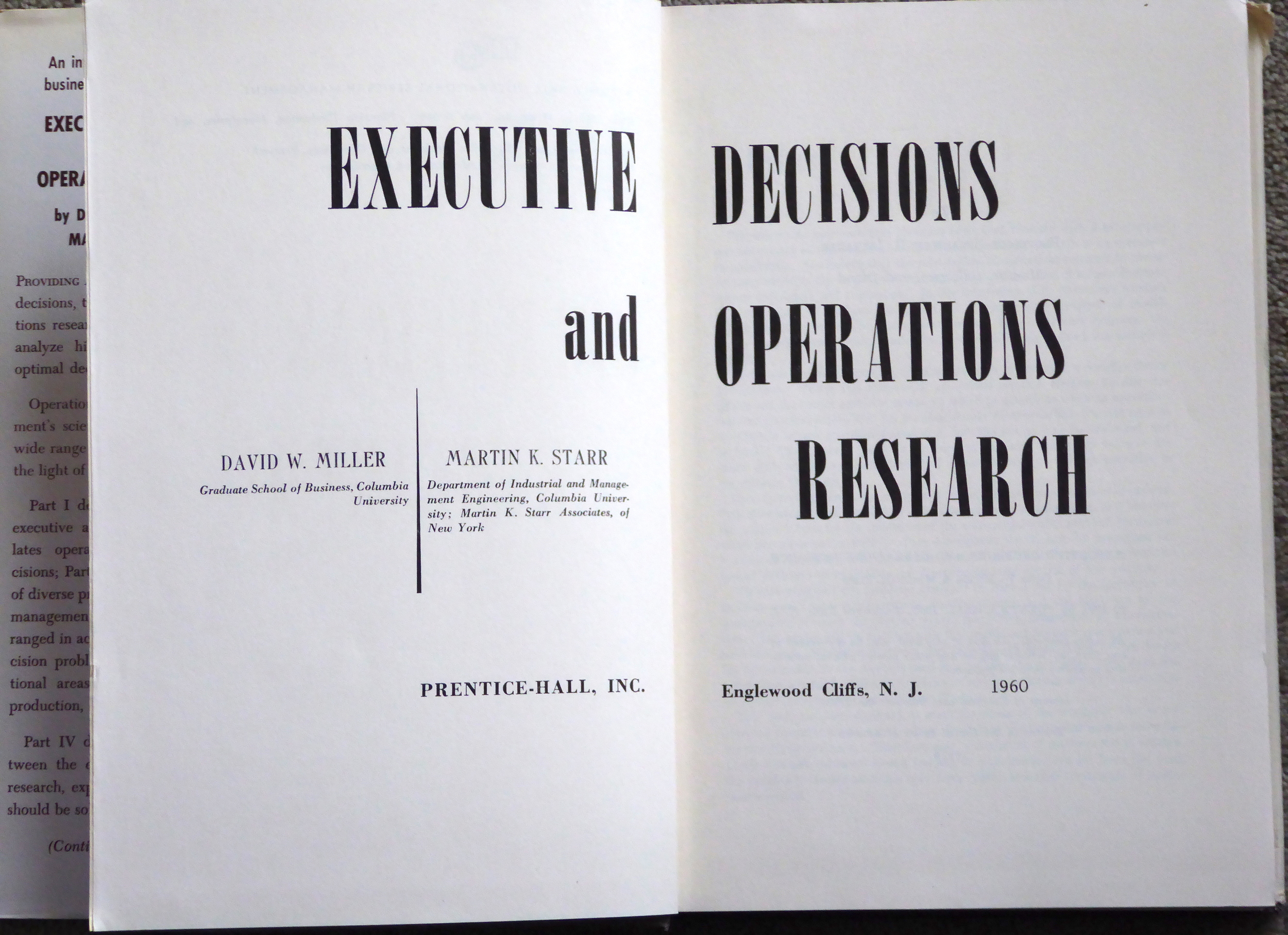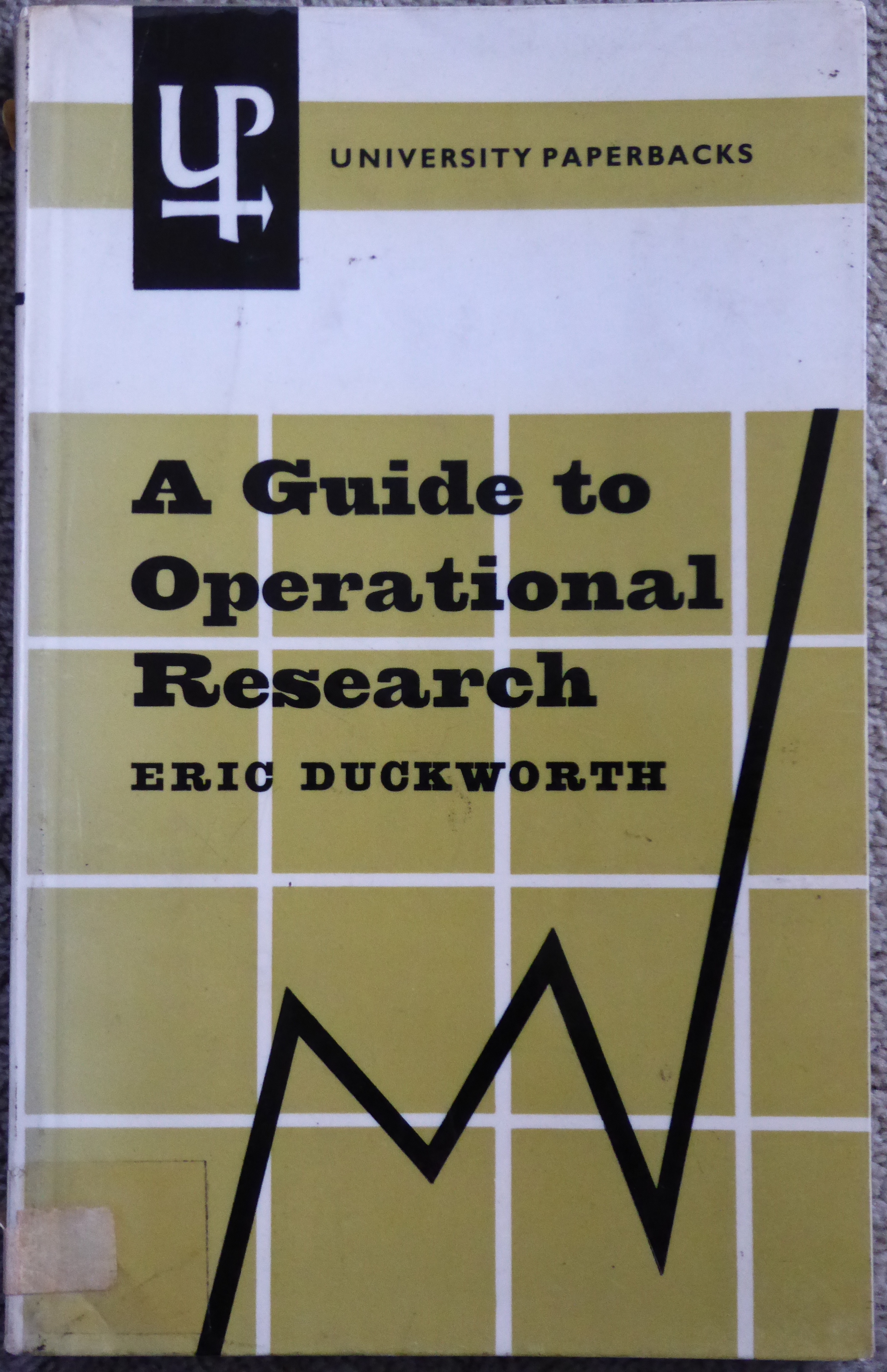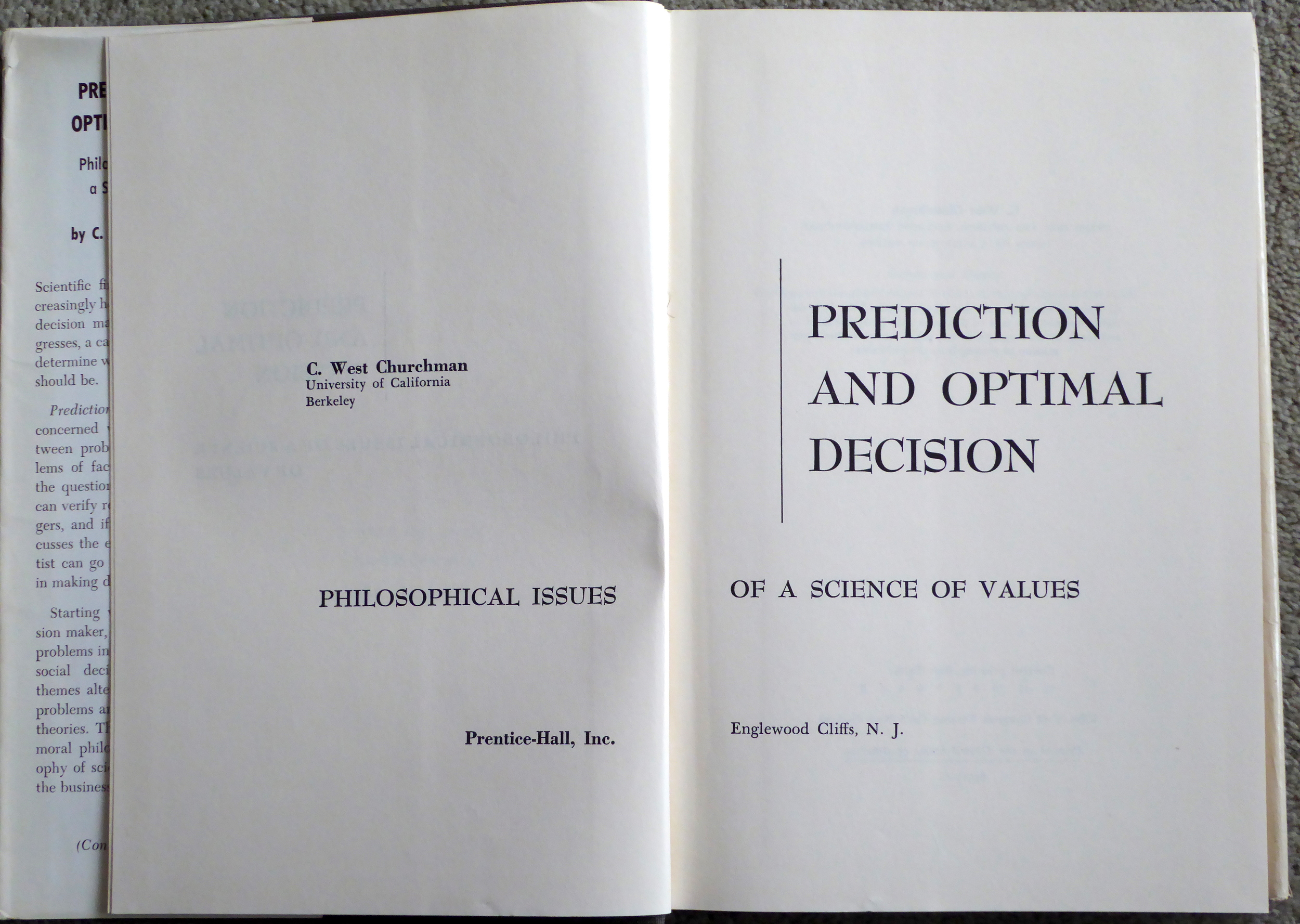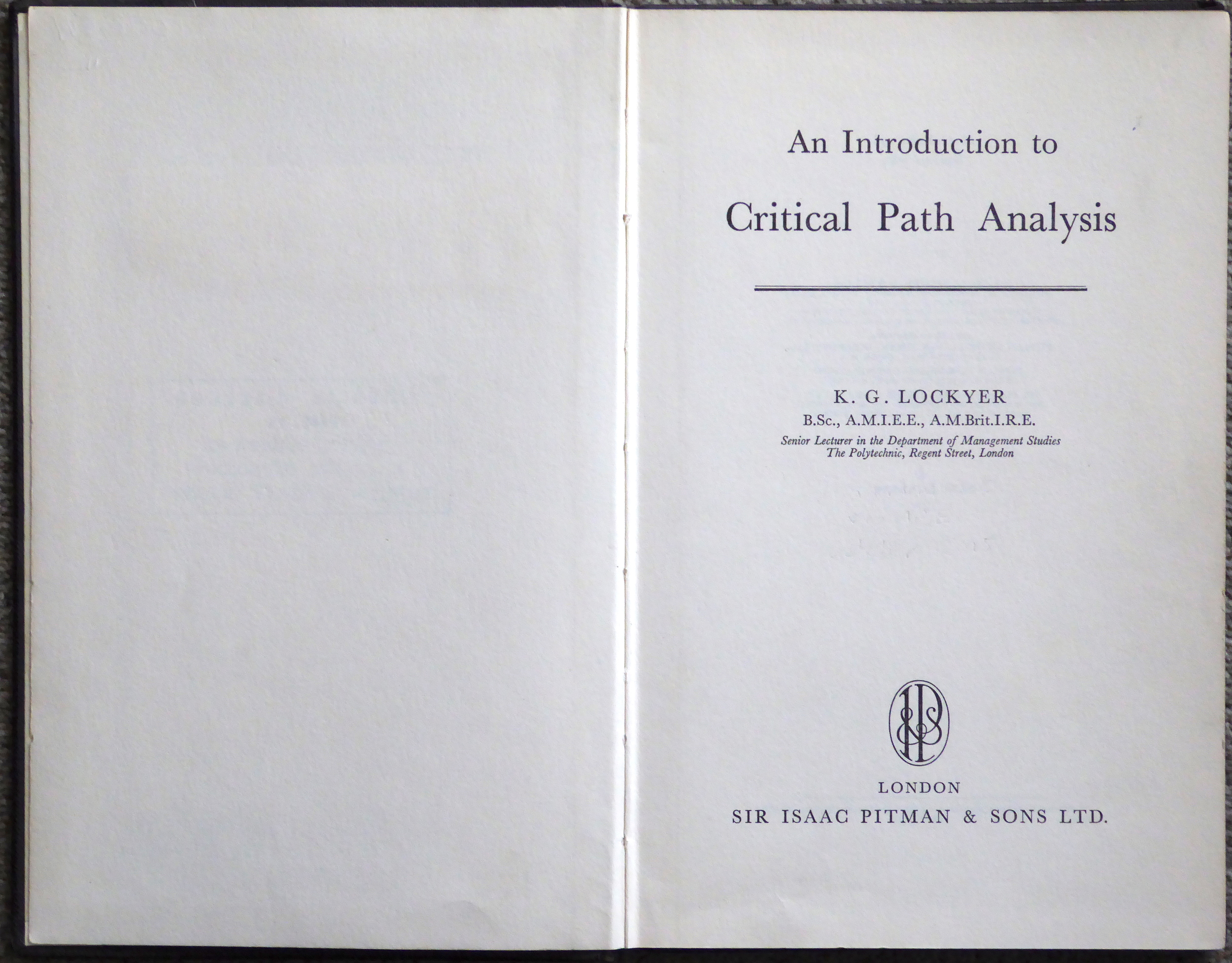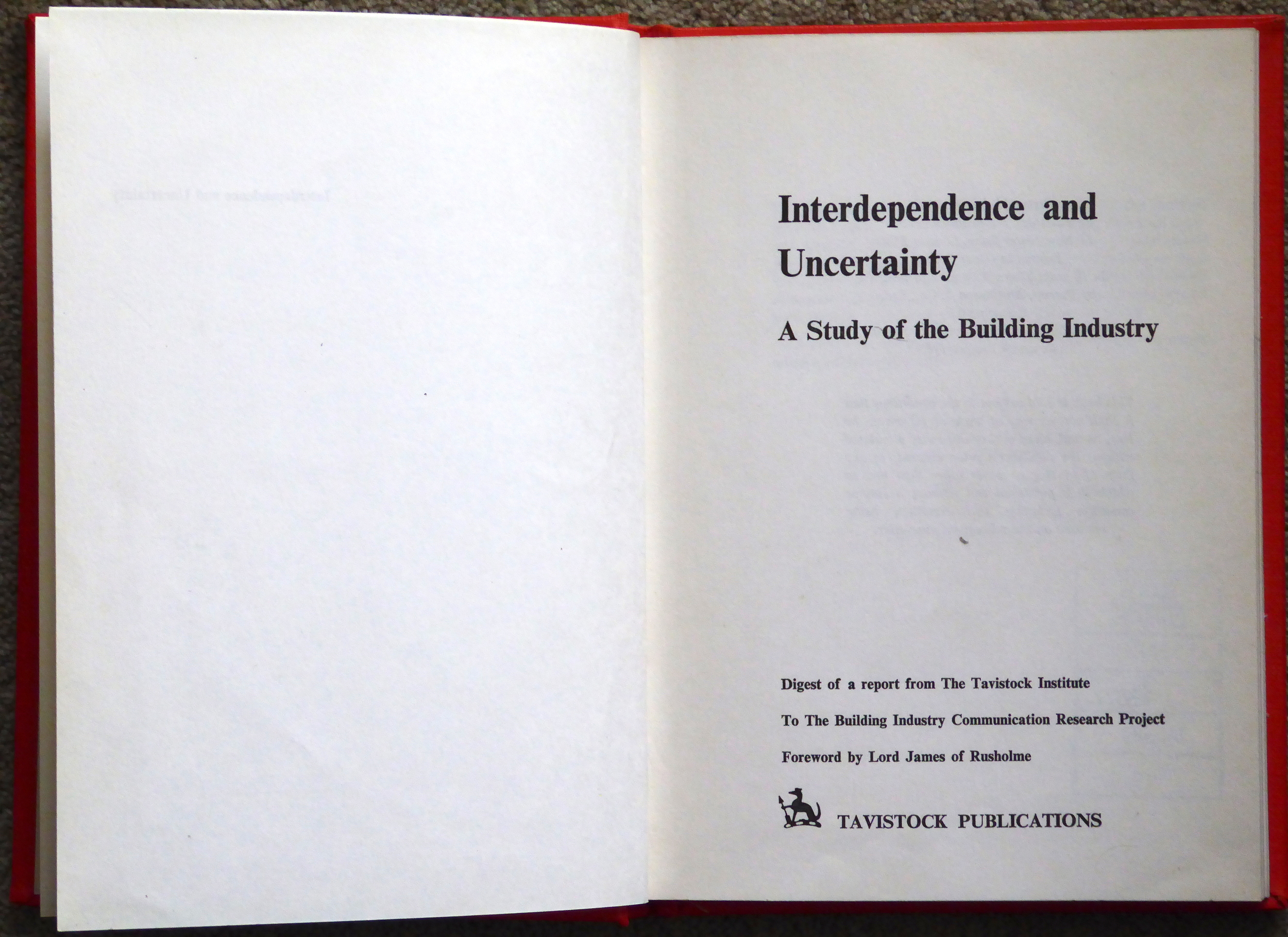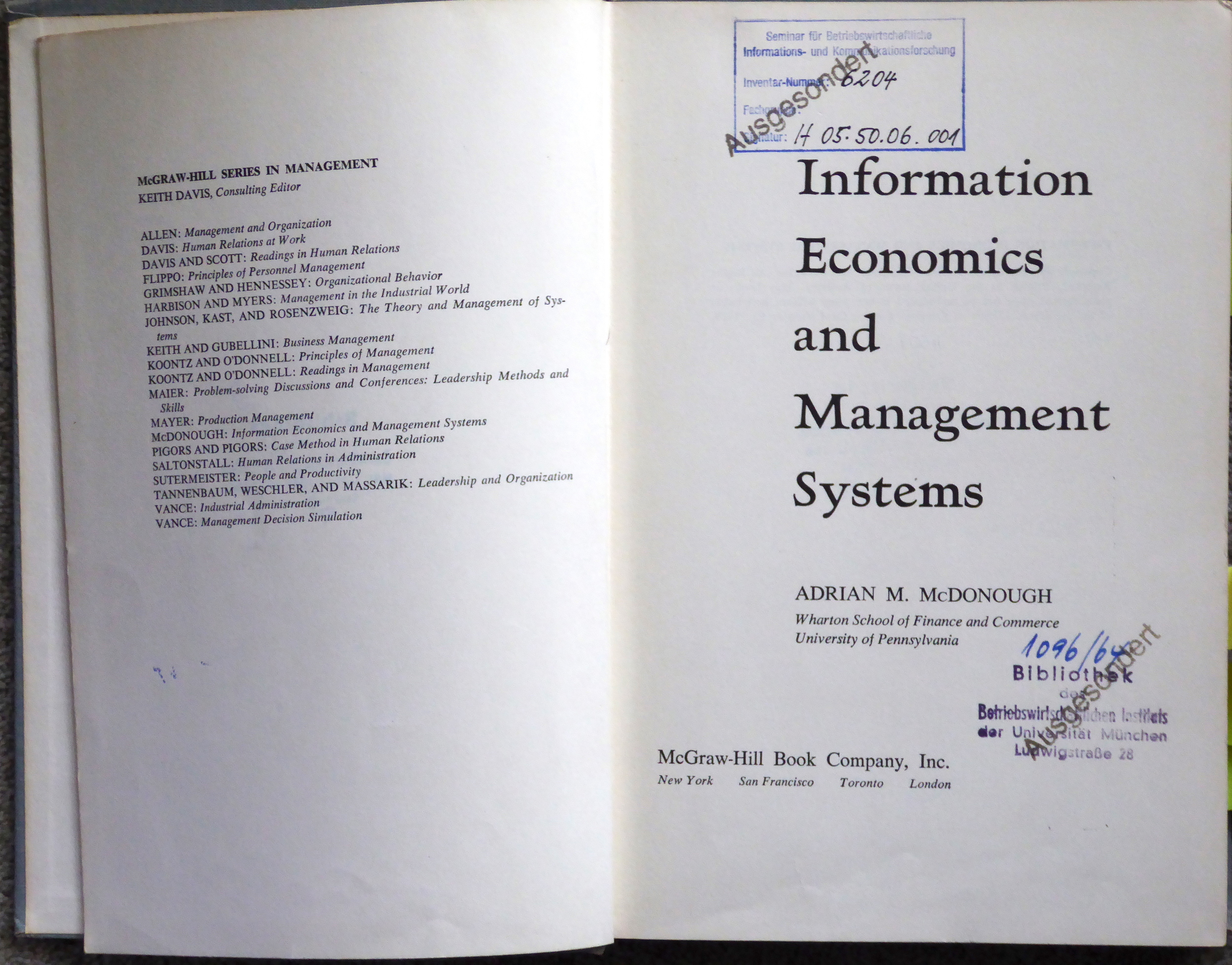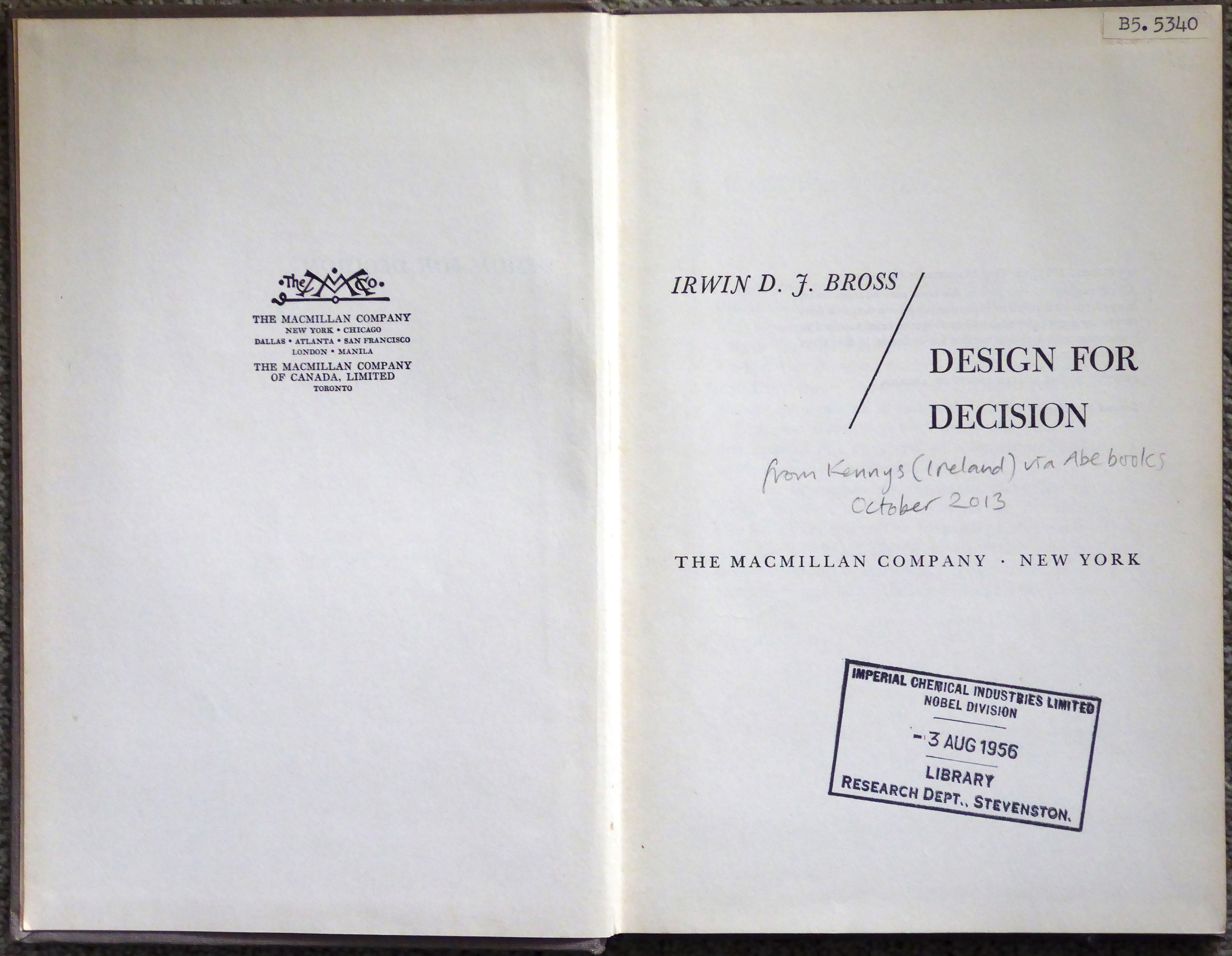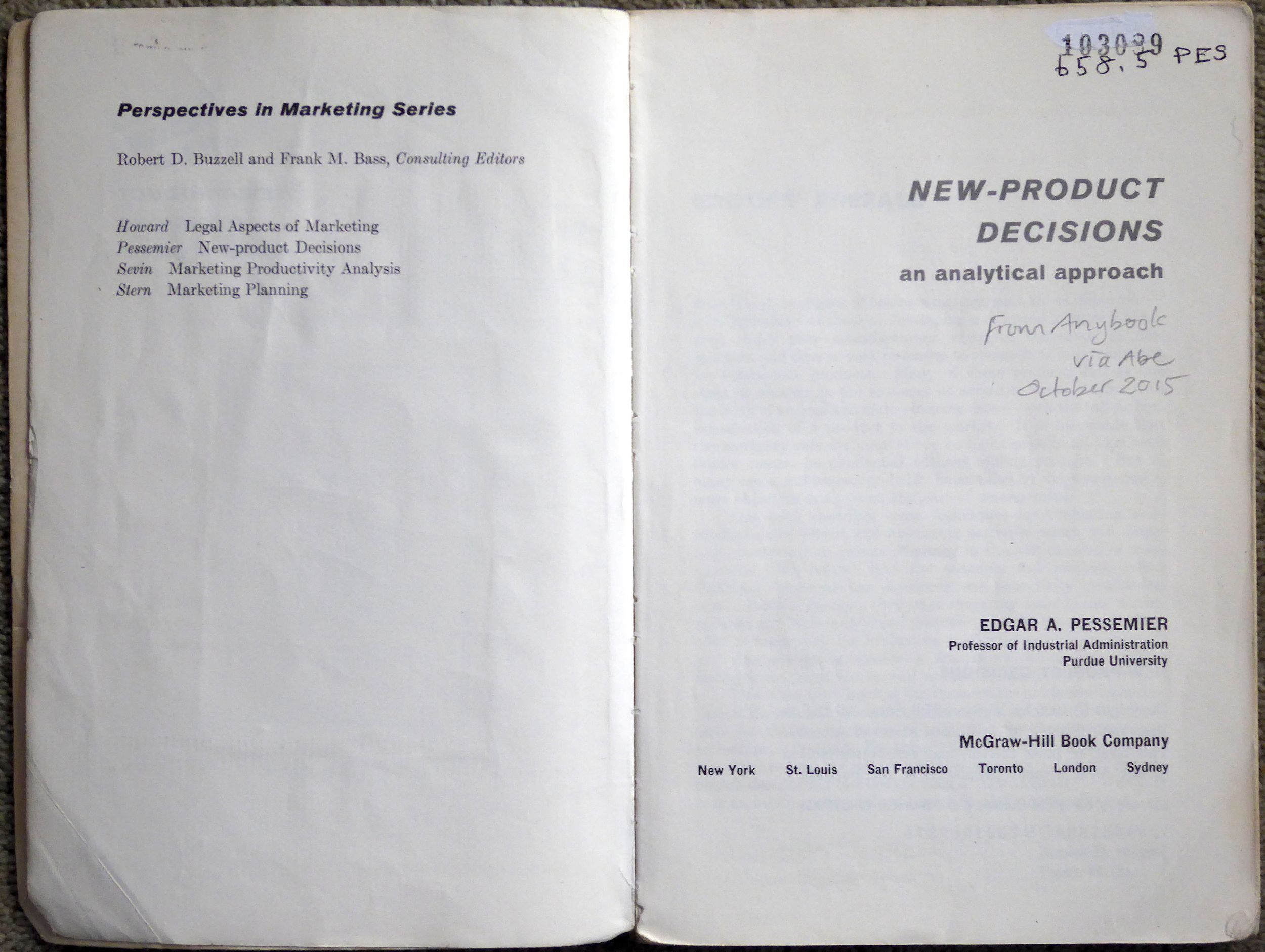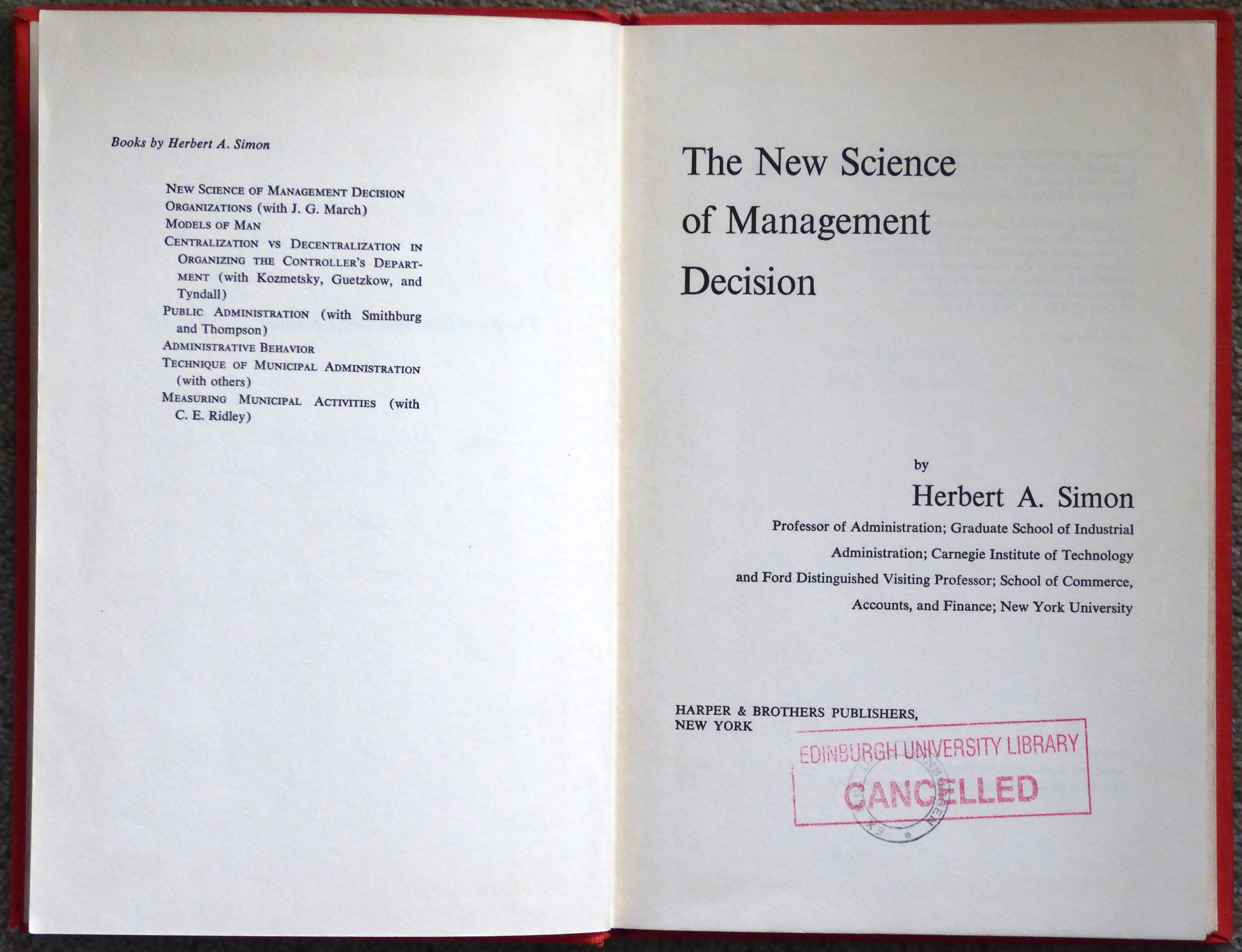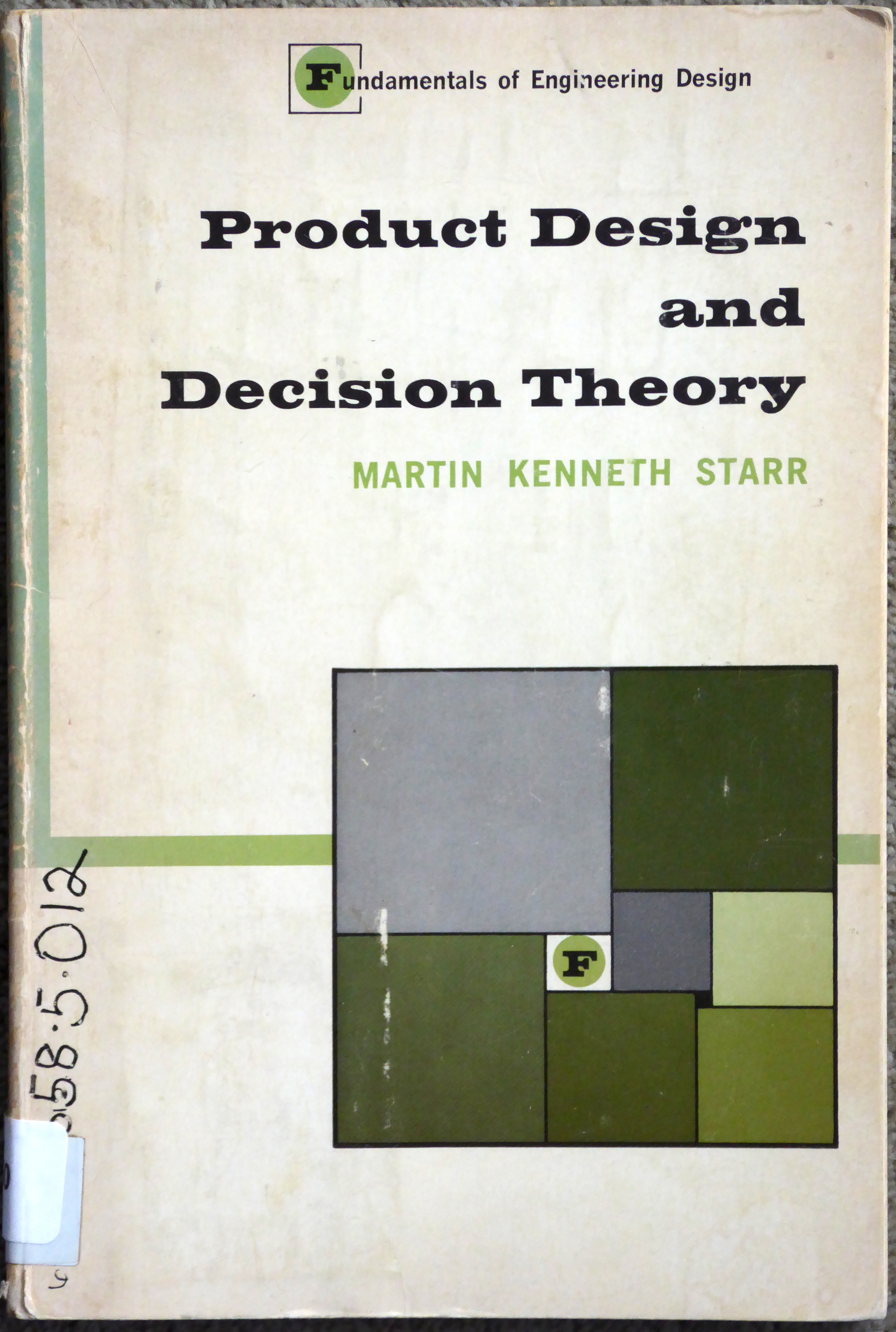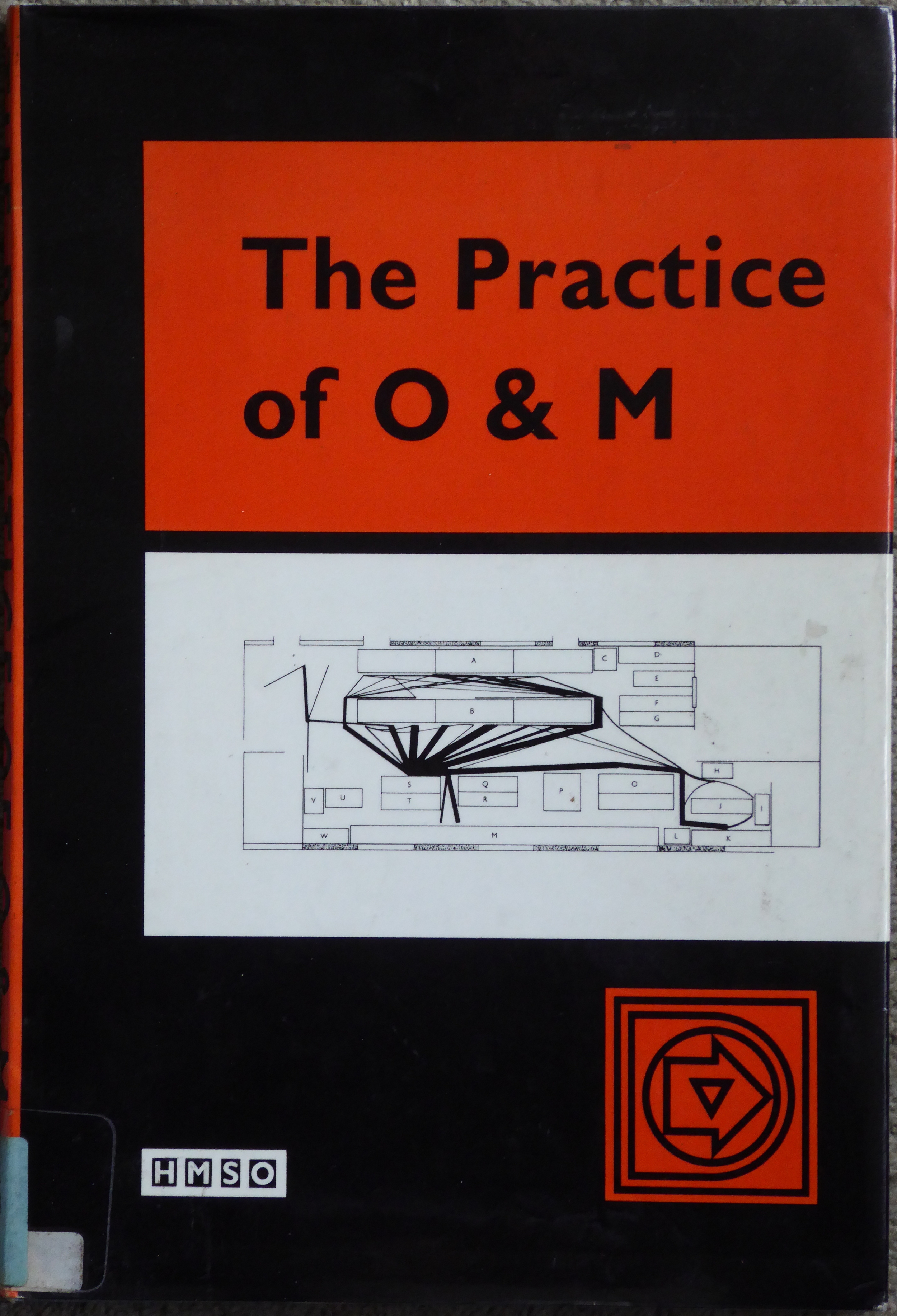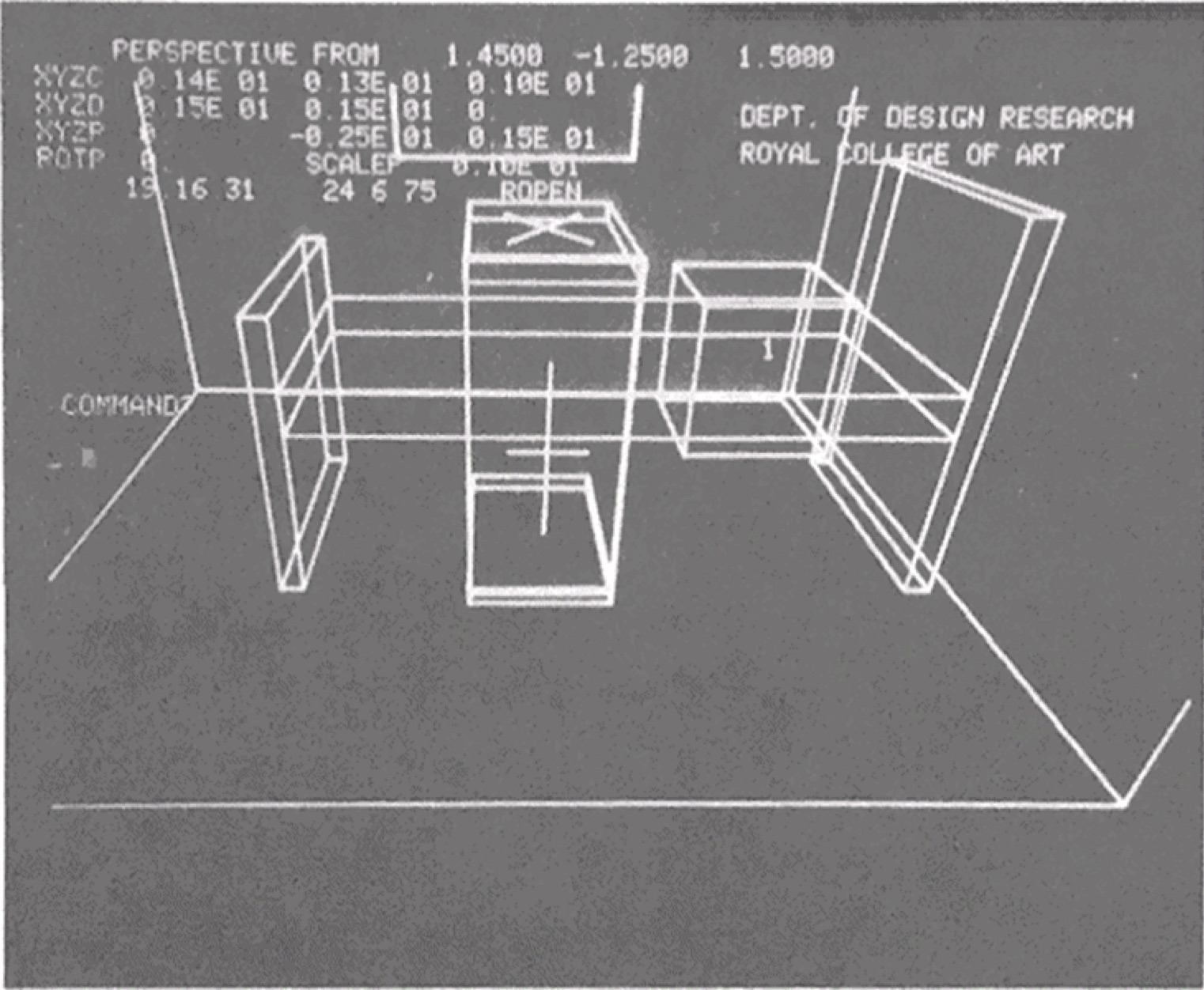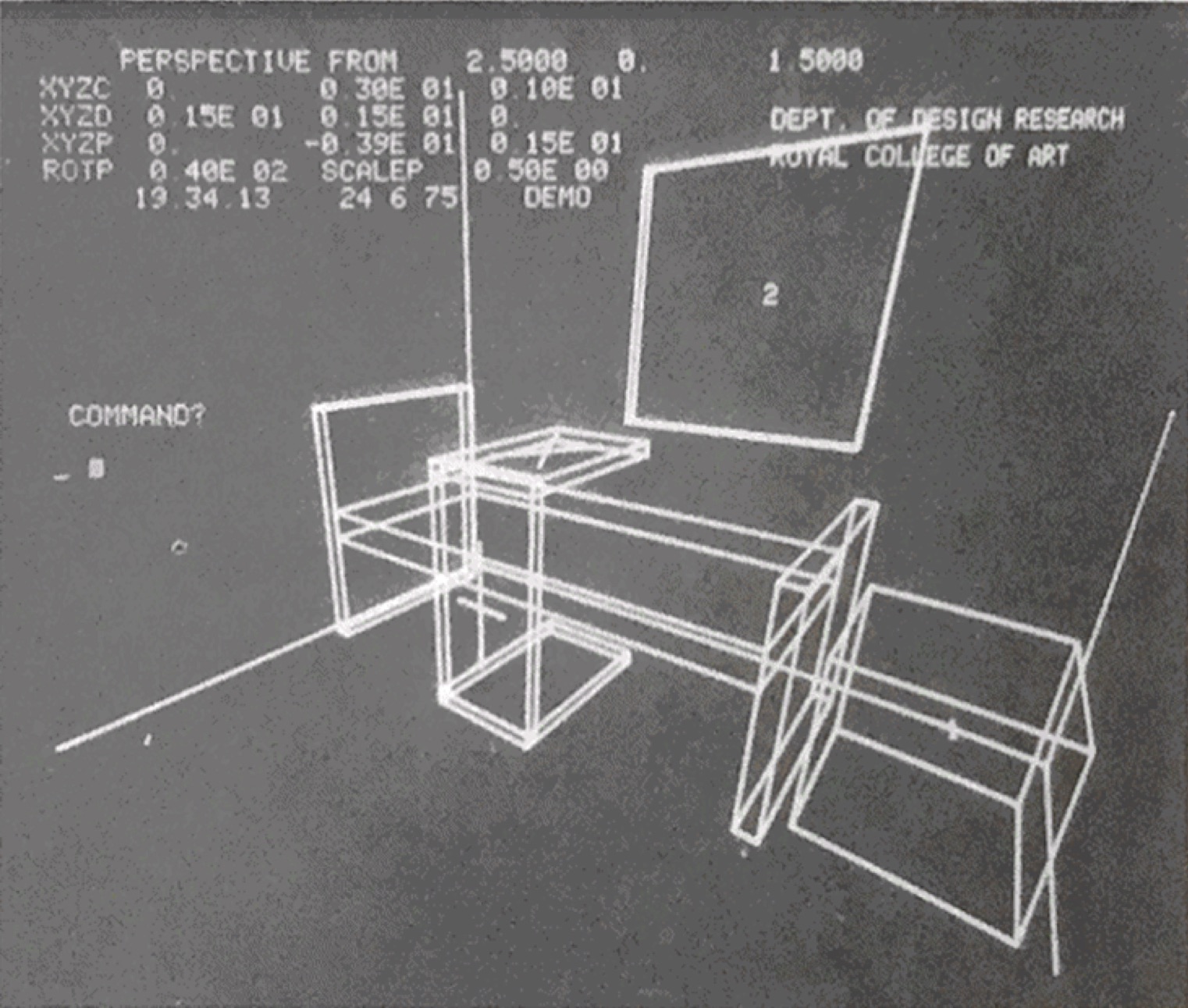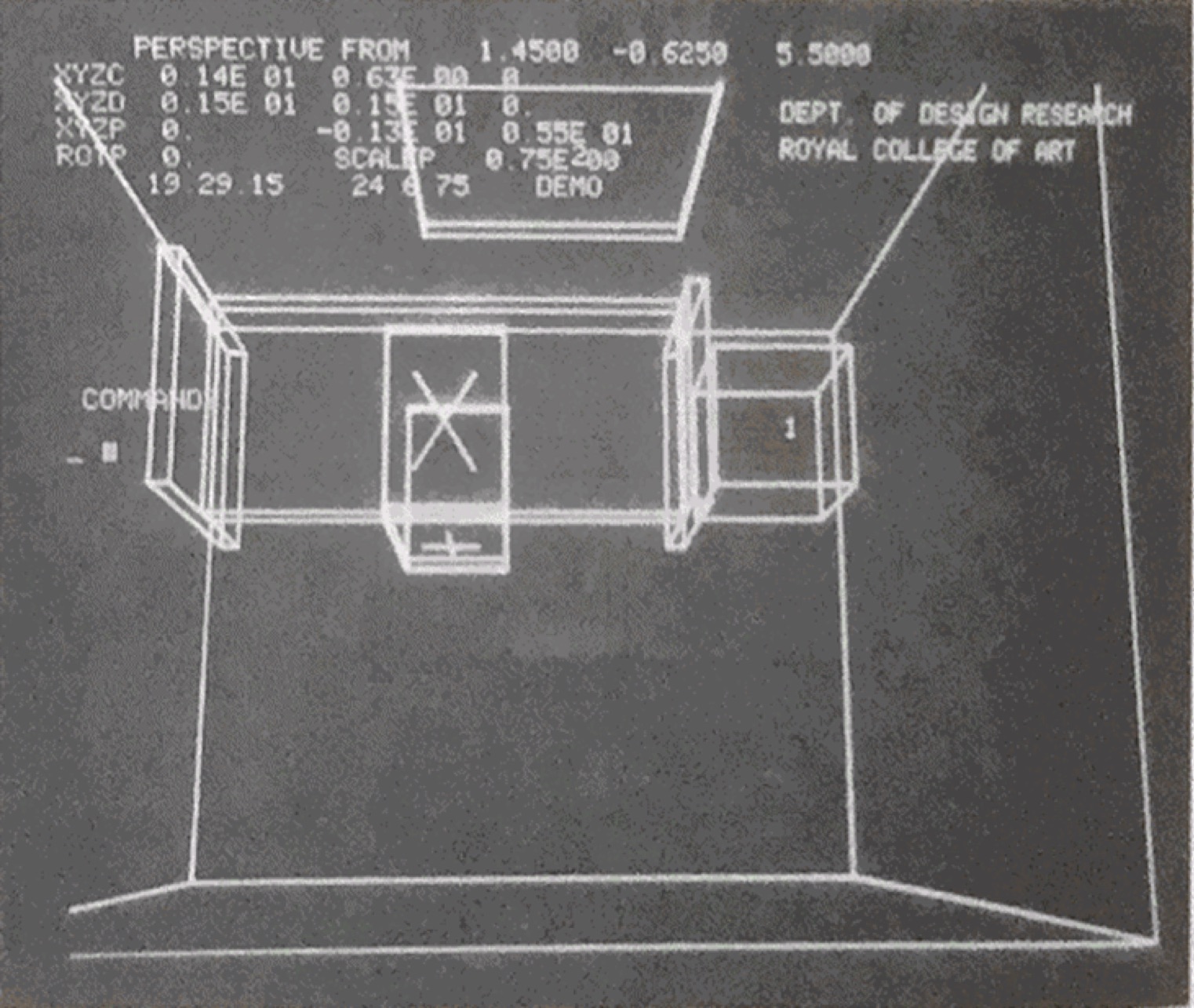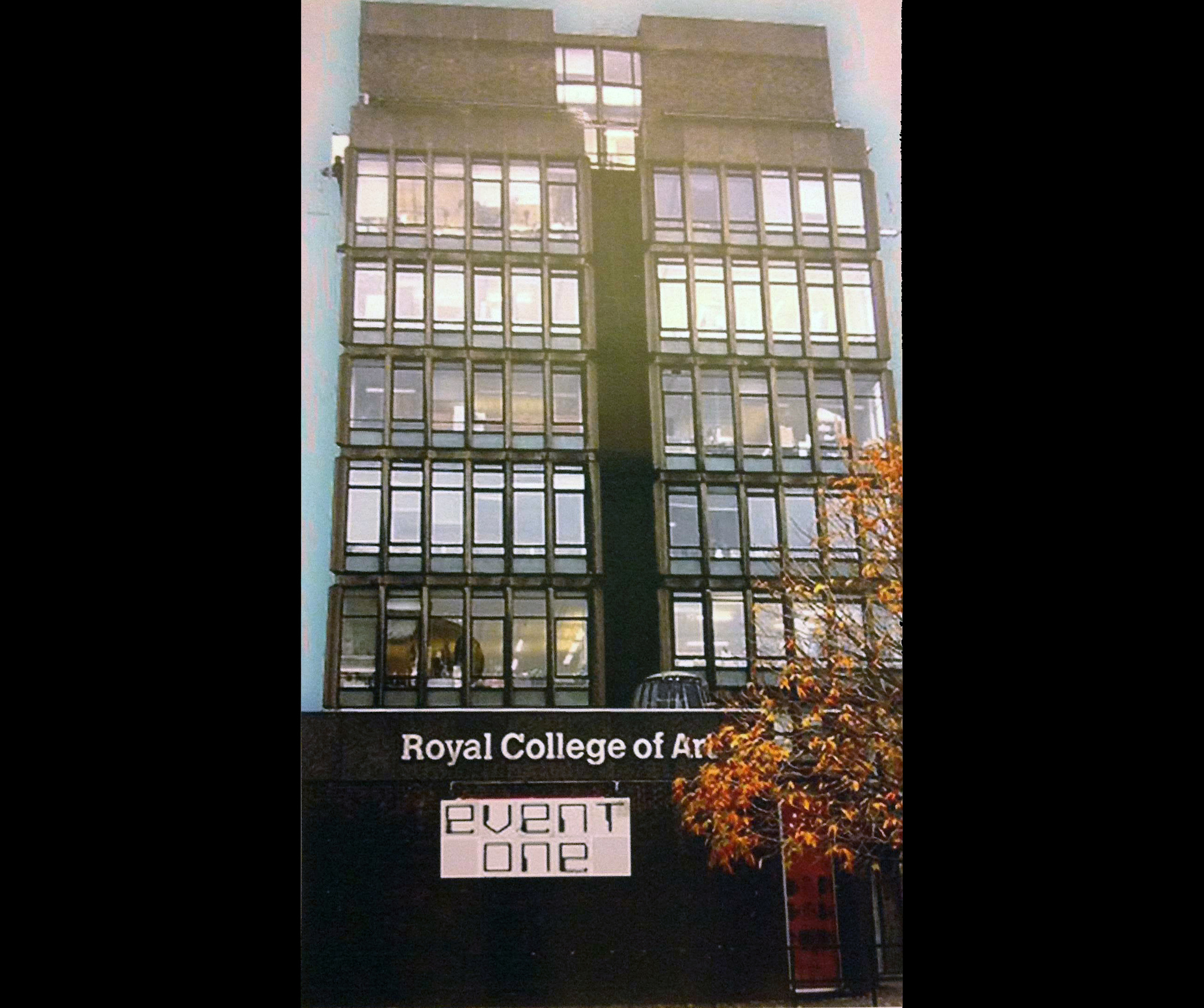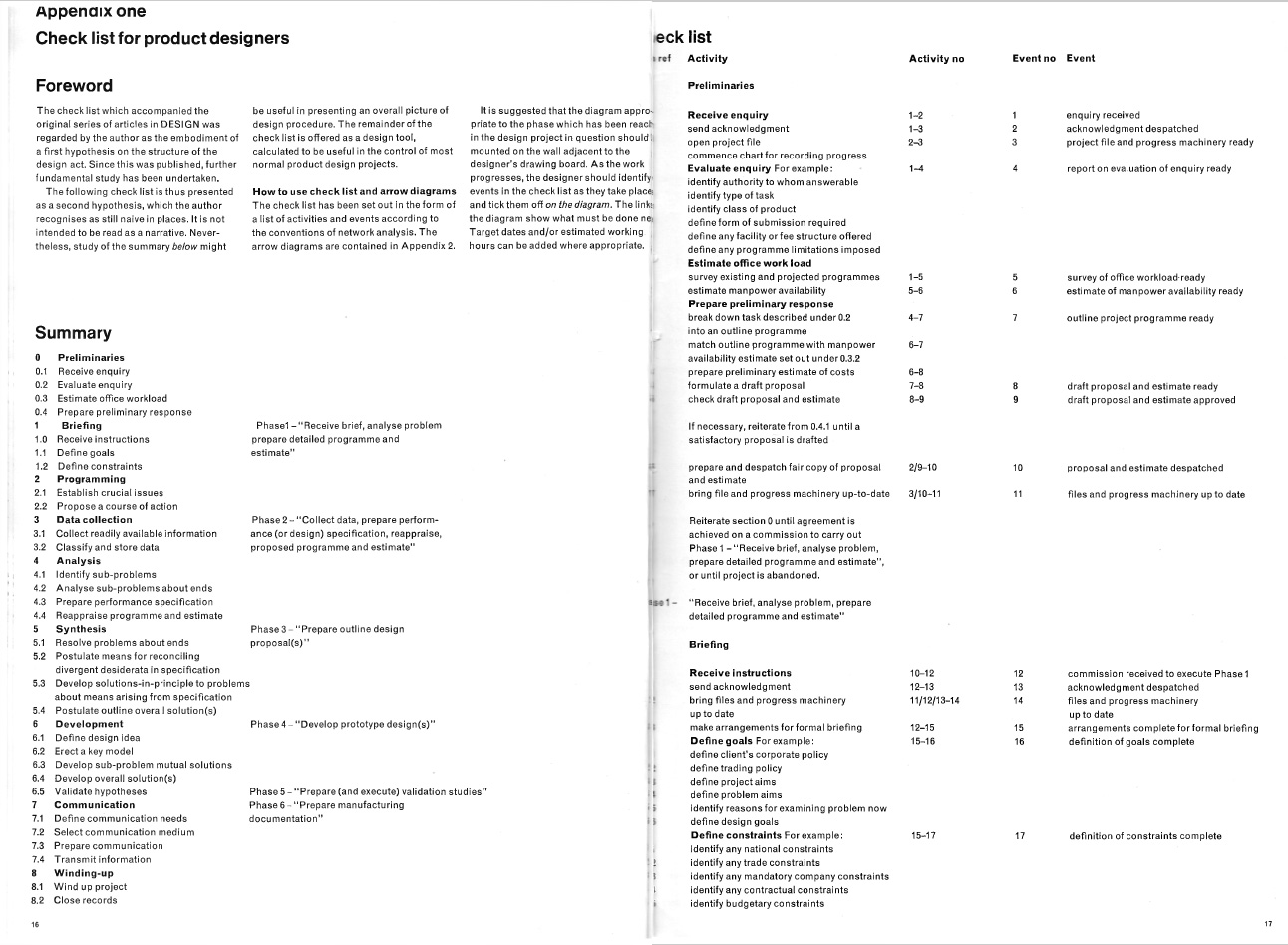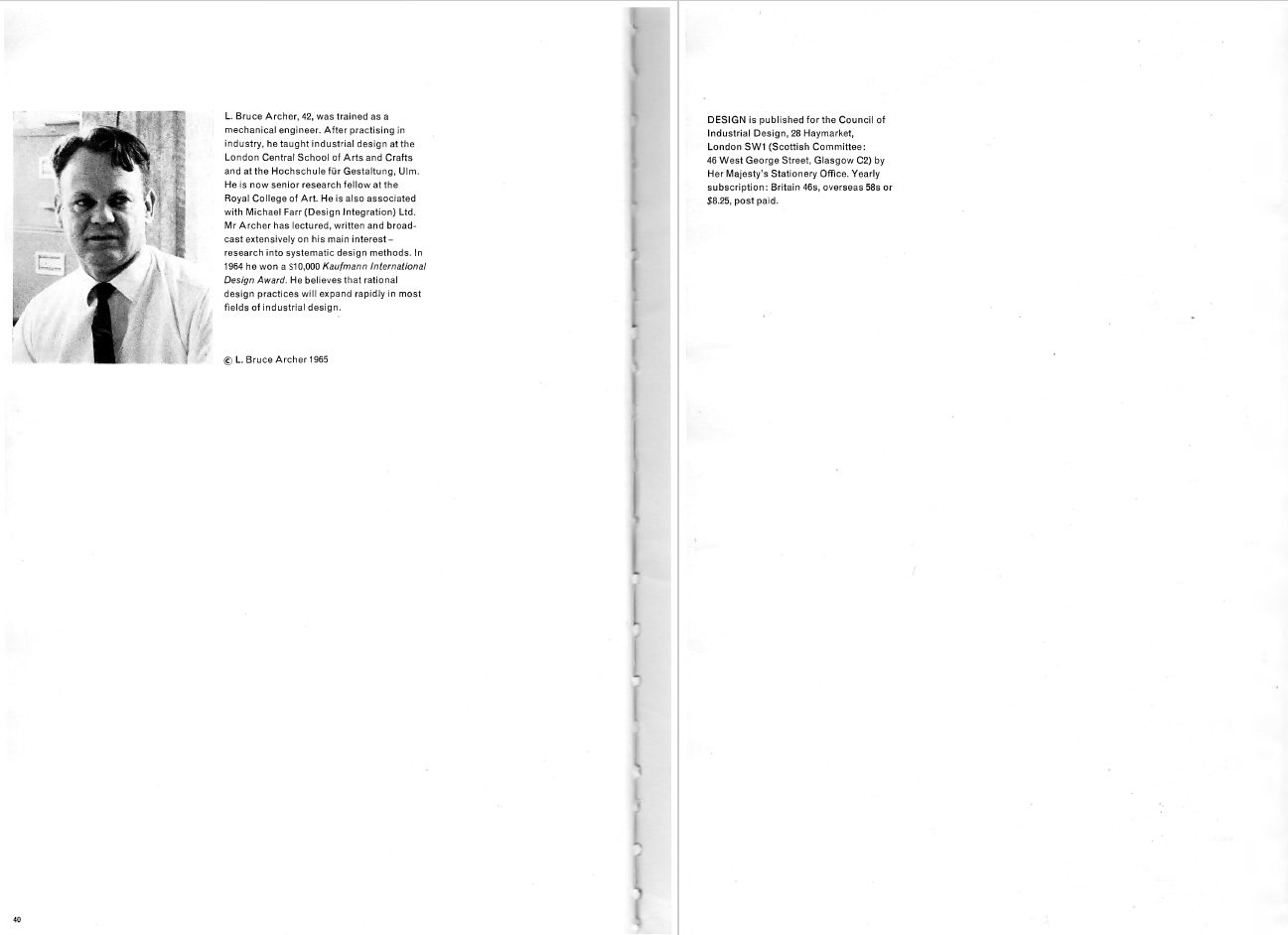
Early Design Research at the RCA
The Royal College of Art in the 1960s and 1970s
Early Design Research at the RCA
The Royal College of Art in the 1960s and 1970s
The photo shows the Department of Design Research (as it was later know) at the Royal College of Art some time prior to 1965. At that time it was known as the School of Industrial Design (Engineering) Research Unit. This photo appeared quite widely, including in the SIA Journal of October-November 1965 which featured ‘Designing a Hospital Bed: Research and Analysis’ and in Ken Baynes’ 1967 book Industrial Design & the Community (London: Lund Humphries).
Photo by WJ Toomey (copyright holder unknown).
About this online exhibition
This online exhibition introduces a project to document and evaluate the early history of Design Research in the UK, focusing on the Department of Design Research and its predecessors at the Royal College of Art, London.
The exhibits illustrate a number of themes, many of them concerned with the varied roles of the leader of the Department, Professor L Bruce Archer. They are organised around a series of images, highlighting important themes, and not necessarily presented in chronological order.
The exhibition has been put together by Stephen Boyd Davis, Professor of Design Research at the RCA, and Dr. Simone Gristwood of Middlesex and Lancaster universities. They are grateful to Neil Parkinson, archivist at the RCA and many other individuals too numerous to name.
Currently in its early stages, the project is seeking funding to develop a deeper research inquiry. Many individuals have been approached to share their insights and evidence and have kindly agreed. If you are knowledgeable about the early days of Design Research, especially at the RCA, or want to offer a perspective on the subject, please get in touch with Stephen.
Who is in the photo?
According to Ken Baynes (1967:52) everyone in the photo is connected with the famous Hospital Bed project:
This photograph, showing the staff of the research unit who worked on the development of the Royal College of Art hospital bedstead, is a graphic demonstration of the fact that many major pieces of design depend on teamwork. It is worth recording just who the people involved are and what they do. On the extreme left is Gillian Patterson, information research assistant, a graduate research librarian. Next to her, at the back, is Reg Talbot, an ergonomist and systems analyst who was responsible for planning the validation studies. Third from the left, right in front, is Kenneth Agnew, industrial designer, research fellow at the Royal College of Art, and Mr Archer’s principal assistant. Fourth from the left, right at the back, is Tony Driver, College staff sheet metal craftsman. Next from the left, in the middle row, is Doreen Norton, a nursing sister with a fine research record behind her, and nursing adviser to the Unit. Right at the back is Pauline Benington, secretary and office manager to the research Unit. Next to her is Ken Ireland, College staff machine shop craftsman. Right in the very middle is Irfon Roberts, secretary of the Working Party to whom the Unit reports and also a deputy director of the Hospital Centre, who are the project’s sponsors. Behind him is Ed Walden, mechanical draughtsman. In front, with arms folded, is Bruce Archer, director of the Unit. Fourth from the right, Peter Slann, aeronautical engineer responsible for structural analysis and advice. Third from the right is Gordon Cork, welder on the staff of the Unit. Second on the right is Eleanor Piclet, Mr Archer’s private secretary, and on the extreme right is Charles Denroche, a builder of experimental metal work, who developed and made some of the mechanisms. Not shown, of course, are the very large number of doctors, nurses and research workers in other establishments who gave information and advice.
See also
For more on the Kings Fund Hospital Bed, see HOW TO MAKE A BED: THE KING'S FUND HOSPITAL BED PROJECT
Baynes, Ken. 1967. Industrial Design & the Community. London: Lund Humphries.
The DRS and the DDR
Collaborations and Connections
The DRS and the DDR
Collaborations and Connections
Archer makes his acceptance speech for the DRS Lifetime Achievement Award at the Royal College of Art, London in 2004, the year before his death.
Seated listening to him is John Chris Jones, fellow recipient of the award.
Taken from a video formerly available on a De Montfort University site. See text of Sebastian Macmillan's speech.
Bruce Archer, the DDR and the DRS
There are multiple connections between the Design Research Society and the RCA's Department of Design Research, many centred on Bruce Archer, the Department's original researcher and later its Professorial head.
Archer was Chair of the DRS from 1988 to 1990 and Honorary President from 1992 to 2000.
Archer gave his view of the sequence of events in the creation of the DRS at a conference in 1995:
The first Design Methods Conference was held in London in 1962, thirty-three years ago. But it was at the Second Design Methods Conference held in Birmingham in 1965, precisely 30 years ago, that the idea of founding a cross-disciplinary society for those interested in Design Methodology was conceived. The Design Research Society was duly brought to birth at an Inaugural Meeting held at the Imperial College of Science and Technology, London, the following Spring.
Archer was part of the organising committee for the 1962 Design Methods Conference, though he did not contribute a chapter to the proceedings.
The Design Research Society often traces its origins to the Conference on Design Methods held at Imperial College London in 1962. Organisers from the RCA were Frank Height (1921-2013, a key figure in Industrial Design (Engineering) and in ICSID, and Bruce Archer, then only in his first year at the College.
Taking stock in the Seventies
For the first issue of the DRS's Design Studies journal in 1979, Archer contributed a short statement and an article. Together they looked back and forwards. The short statement 'Whatever Became of Design Methodology?' began with the words 'Design Methodology is alive and well, and living under the name of Design Research.' It casts an interesting light on the controversies around systematic design. Archer retrospectively accounts for his own early motivation:
I was concerned to find ways of ensuring that the predominantly qualitative considerations such as comfort and convenience, ethics and beauty, should be as carefully taken into account and as doggedly defensible under attack as predominantly quantitative considerations such as strength, cost and durability. Moreover, it is demonstrable that the assumptions upon which even the quantitative considerations are based can never be wholly value-free, and I wanted these assumptions to be at least acknowledged in the design process. The study of methods was thus not an end in itself, and was certainly not motivated by the desire to eliminate or down-grade the qualitative considerations, although a lot of people interpreted it that way.
The second contribution to Design Studies 1(1) is an extract from a lecture delivered by Archer at the Manchester Regional Centre for Science and Technology on 7 May 1976, under the title 'The Three Rs.' It represents a dramatic shift in Archer's thinking. He argues that Design should be regarded as a fundamental aspect of education - in no sense a specialised subject - and that Design is (or should be) on a par with, and distinct from, science and the humanities.
Archer's delineation of Design as a third culture, distinct from the humanities and sciences, based on a lecture given in 1976 (Archer 1979:20).
Archer's activities were often mentioned in the pages of the DRS newsletter, Design Research. In 1986 the front page was devoted to the closure of the Department. In January 1988, the Chairman's Report recalled:
On the 3rd. of July 1986, your chairman and various other members of the DRS were invited to join the Seminar to mark the closure after 25 years of the Department of Design Research at the Royal College of Art. Professor Bruce Archer moved on to become the Director of Research for the RCA as a whole, as part of a major shift in policy to generate design research from within all the departments of the college. Many former members of the Department of Design Research attended, and they were invited to see the Design Research Society as a means of keeping in touch with each other, some of them already being members. (Design Research Issue 32, January 1988, p1)
Design Research, the newsletter of the Design Research Society, in December 1986 reflects on the closure of the RCA Department of Design Research (1961-1986).
DRS Lifetime Achievement Award
In 2004, Professor Bruce Archer received the DRS Lifetime Achievement Award. Sebastian Macmillan summed up Archer's contribution to the field:
Bruce largely invented the discipline of design research, and has made a number of vital contributions to its establishment. He demonstrated that evidence-gathering, systems-level analysis, and field testing were necessary in industrial design, and argued for greater rigour in design practice to ensure decisions are well-founded, recorded and explicable so they can, if necessary be defended. He reflected on his experiences and captured their essence in seminal papers about systematic methods and the design process. ... He trained a generation of design researchers, introducing us to the principles and practice of scholarly enquiry. He foresaw the need for us to become a community to share our knowledge and experience - and helped to found the Design Research Society.
Archer said in reply:
Anything that can be said of me, and any contribution I have made is really down to the students and staff, who I enjoyed in those 25 years. There are more than a 100 of them and some have made it to senior positions in the academic world, and in the practitioner world. I salute you all. You are what have made design research what it is, and it is you, if you are able to seize the opportunity, who will make it into something more.
See also
For a discussion of Archer's changing views leading to the triad see SYSTEMATIC METHOD: DESIGN MAGAZINE AND A DOCTORATE.
For attitudes to early Design Methods see SCIENTISING DESIGN: OR, O&M AND THE COMPUTER
Archer, L. Bruce. 1979. Design as a discipline. Design Studies 1(1), July 1979. 17–20.
Origins of the DDR
Industrial Design (Engineering): Research
Origins of the DDR
Industrial Design (Engineering): Research
Details of the cover and inside pages of the RCA Calendar for 1961-62.
The Department of Design Research traced its origins to 1961 when Professor Misha Black invited Bruce Archer to the RCA as a Research Fellow.
Origins
The Department of Design Research traced its origins back to 1961 when Professor Misha Black, head of the School of Industrial Design (Engineering), invited Bruce Archer to the RCA to lead a research project that Black had created under the title Studies in the function and design of non-surgical hospital equipment, to be funded by the Nuffield Foundation.
Practice and Theory
DESIGN AT THE HEART OF DESIGN RESEARCH
Practice and Theory
DESIGN AT THE HEART OF DESIGN RESEARCH
Some examples to emphasise the practical design projects of the Department.
Design activities included fact-finding and needs-analysis, drawing and low-fidelity prototyping, building prototypes in a range of materials in the RCA workshops, manufacturers constructing advanced prototypes, and extensive user-testing within the DDR and externally on site.
Design and Design Research
Sometimes seen as a theoretically-oriented enterprise, the Department of Design Research always engaged in practical design projects as well as theoretical development. Practical research activities brought in much of the essential funding of the Department. More importantly, they acted as a test bed for ideas: theory fed into practice and vice versa. In our paper for DRS 2016 (Boyd Davis and Gristwood 2016), we argue that Bruce Archer's theoretical model of designing was fundamentally altered by his experience of large multi-disciplinary projects such as the King's Fund hospital bed.
A key figure in the practical design work was Kenneth Agnew, who graduated in Engineering Design at the RCA having originally trained as an architect. A Research Fellow from 1965, he become a central figure in the DDR through to 1978, designing the Hospital Bed and working on many other projects. He was later Professor of Design at the University of Ulster. Kenneth has been one of our key sources of information for this project. Many of the pictures are taken from his Archive recently acquired by the RCA.
Bruce Archer (centre) at the International Council of Societies of Industrial Design in Vienna in 1965. From the Agnew Archive at the Royal College of Art, London.
Archer had something to say about the role of practical projects, in relation to the hospital bed work:
We produced our own design, as well, for three good reasons.
- First of all, it is an excellent discipline on research if one knows that one must produce a design in conformity with it in the end.
- Secondly, it is an excellent discipline upon the existing manufacturers, who would be less inclined to say that the specification could not be met if they knew we were going to meet it ourselves.
- Thirdly, it was necessary to have at least one bed design exactly meeting the specification in order to carry out field tests in hospitals to prove whether our specification was any good or not.
There was a fourth reason. There would be no justification for such research to be carried out in a design school if no design was going to result.
(Archer address at The International Council of Societies of Industrial Design (ICSID), Vienna, 1965, quoted in Baynes 1967:48).
See also
For more on the Hospital Bed project, see HOW TO MAKE A BED: THE KING'S FUND HOSPITAL BED PROJECT
Baynes, Ken. 1967. Industrial Design & the Community. London: Lund Humphries.
Boyd Davis, Stephen and Gristwood, Simone. 2016. The Structure of Design Processes: Ideal and Reality in Bruce Archer’s 1968 Doctoral Thesis. Proceedings of DRS 2016, Design Research Society 50th Anniversary Conference. Brighton, UK, 27-30 June 2016.
History in the Archives
THE JOB NUMBER BOOK
History in the Archives
THE JOB NUMBER BOOK
The Department of Design Research Job Number Book is part of the DDR archive at the Victoria and Albert Museum. Currently at the museum's store at Blythe House in Blythe Road, West Kensington, London, its future location is uncertain as the store is due to close. The V&A, Science Museum Group and British Museum all store artefacts at Blythe House.
A VALUABLE RECORD
An important document going back to the early days of the DDR is the Job Number Book. It lists jobs sequentially whether they were undertaken by the department as such or privately by individuals within the department.
The opening page notes that only the R/U (presumably Research Unit) director can allocate numbers, or in his absence 'GAP' (Gillian Patterson, a graduate research librarian). Patterson 'was mathematically adept and took on special responsibility for information handling. Subsequently she ran entire projects when they inclined more to this field than to actual design and engineering, and became a Research Fellow in the Unit' (Lawrence 2001). Patterson worked for the Department throughout its existence. She was also the partner of Patrick Purcell. Patrick was a key figure at the RCA, at Imperial and at the MIT Media Lab, and a pioneer of computing in design.
The research project on Archer and the DDR will use the Job Number Book as an important source to establish the chronology of the projects and external relationships of the Department. It requires extensive correlation with other evidence published and unpublished.
Lawrence, Ghislaine. (2001) Hospital beds by design: a socio-historical account of the 'King’s Fund Bed', 1960-1975. PhD thesis of the University of London. Available on the British Library Ethos service, ID: uk.bl.ethos.271734. Available online at Archive.org.
How to Make a Bed
THE King's Fund Hospital Bed Project
How to Make a Bed
THE King's Fund Hospital Bed Project
The planned hospital beds needed to be high to minimise injury to nurses, but low for the patients to get in and out: the solution was an adjustable-height bed. However, straightforward resolutions like this were unusual. During the project, the team had to deal with intersecting issues of manufacturing, materials, healthcare, hands-on nursing, standards, safety, hospital management, patient satisfaction, industrial commerce, external relations, and institutional culture and politics at a number of levels.
The archives at the V&A and RCA contain extensive documentation of all aspects of the Kings Fund bed and related projects, much of it photographic.
The DDR's Most Famous Project
Misha Black had invited Bruce Archer to lead a research project on non-surgical hospital equipment funded by the Nuffield Foundation (Archer 2004). Archer saw the initial task as 'the development of an organised body of knowledge that will assist manufacturers to design and hospital planners to select fixed and moveable equipment' (p.1). Four problems were chosen as the focus of the 'organised body of knowledge', including the need for a standard design of hospital beds. There were over three hundred bed types in use, made in petty numbers by many companies. The Royal College of Nursing had reported the high incidence of permanent back injury among nurses due to the poor design of beds (p.2).
Lawrence (2001:47) remarks that the notes of Archer’s and his assistant Butter’s deliberations 'were couched in abstract terms and exhibited a preoccupation with methodology, with rigorous, often self-referential, definition and with stepwise progression.' Probably because the outputs of the 'organised body of knowledge' project appeared too theoretical and produced no prototype products, the first year’s report to Nuffield was rejected and the follow-on three years of funding were denied.
After the failure of Nuffield funding, Black found ways of keeping the rest of the team together, and recruited one of his star graduates, Kenneth Agnew. Each of the four hospital projects was addressed, including the hospital bed which 'turned out to be a very big exercise' (Archer 2004). In August 1962 Black approached the King's Fund in the hope that they would take over financing the project. As Lawrence explains, The King's Fund (founded in 1897 as the Prince of Wales Hospital Fund for London) had lost its original purpose with the coming of the National Health Service. They turned to such areas as hospital catering, equipment and, in particular, the training of hospital administrators and other non-medical staff (Lawrence 2001:53).
A double-page from Industrial Design and the Community (Baynes 1967).
Initially prevented by official policy from creating a single design, the team had to create a specification that manufacturers could respond to with their own solutions. Nevertheless, it was clear that the team would need to build real prototype beds and evaluate them against many criteria.
Baynes wrote that 'It is important finally to record that the Research Unit has itself produced a second design of bedstead to the revised specification and this is now being manufactured as a commercial proposition' (Baynes 1967:54). A caption in his chapter on the bed notes: 'The second bedstead shown here [66 above] is now in production by J Nesbit Evans & Co Ltd and has aroused a great deal of interest in Britain and abroad' (p.54). In the end, many King's Fund beds were made and many are thought to be still in use.
Ken Baynes was himself a key figure in the later life of the Department, leading the pioneering Design Education Unit from 1977.
A six-page article about the Hospital Bed by James Cousins appeared in Design magazine (Cousins 1965).
Archer, L. Bruce. 2004. ‘Autobiography of research at the Royal College of Art 1961-1986’, notes written for the Rector, Professor Sir Christopher Frayling, at his request in March 2004. L Bruce Archer Archive, Royal College of Art. Download the notes (PDF scan of typewritten document, 9 pages, 4.1 MB)
Baynes, Ken. 1967. Industrial Design & the Community. London: Lund Humphries.
Cousins, James. 1965. A general purpose bedstead for hospitals. Design 195, March 1965. 52-57. The article can be viewed online on the website of the Visual Arts and Data Service.
Lawrence, Ghislaine. 2001. Hospital beds by design: a socio-historical account of the 'King’s Fund Bed', 1960-1975. PhD thesis of the University of London. Available on the British Library Ethos service, ID: uk.bl.ethos.271734. Available online at Archive.org.
New Forms of Research
Trial by Television
New Forms of Research
Trial by Television
It is not known whether any recordings still exist of Archer's six-part schools TV series for Granada, or of the notorious Panorama 'televisual research'.
The L Bruce Archive at the RCA contains a few photographs of a television set during the Granada broadcasts.
The DDR Archive at the V&A has the script for the Panorama programme, and some acrimonious correspondence with Paul Fox of the BBC about the truncation of the planned broadcast and a copy of a letter to the Times on the subject. In both archives are material used for planning and presenting the Panorama programme, including at the V&A a large number of glass-mounted slides for the explanatory graphics.
A bad experience with the Box
The DDR made pioneering use of television, not only to communicate its messages about design, but also as a research tool.
In 1964, Bruce Archer wrote and presented a set of six half-hour programmes for the commercial UK television company Granada's schools programmes, broadcast from 27 April to 15 June. The topics were How the Designer Thinks, The Human Factor, Aesthetics and Fashion, The Means and the Ends, Caveat emptor, and Computers in design.
The same year's BBC Panorama segment was pioneering work. Lawrence (2001:97) has written: 'The idea was certainly novel. Since the advent of regular television broadcasting in Britain in 1953, no such attempt appears to have been made, possibly because researchers doubted their effective autonomy in such an undertaking.' In the event, this lack of autonomy was certainly a problem. Opinions on a number of questions, demonstrated in the programme, were sought from a large sample of people in the hospital service who had been invited to watch. Some 20,000 people in 1,000 hospitals were involved (Cousins 1965:54). According to Lawrence:
Preparation for the programme by the RCA team was meticulous. Cardboard cut-outs of the bed parts to be demonstrated were made, painted grey overall, but with the parts to which attention was being drawn during any particular question picked out in brighter colours. The format of the broadcast was to consist of the questionnaire being read out by Archer, while the relevant part or operation of the bed was demonstrated with the cardboard models. The script was timed to the last second.
The RCA team's hopes were high on the evening of 3rd February 1964 as, throughout the country, nursing, medical and administrative staff gathered around hospital television sets. At the last moment, however, disaster struck in the form of the Soviet Foreign Minister, visiting Britain to celebrate the 40th anniversary of British recognition of the Soviet Union. Panorama secured an interview with the Minister which took half of the time allocated to the bed feature.
Even the truncated programme segment was presented quite differently from anything Archer had intended with 'an initial sequence of a scantily clad model rolling about on a bed.'
A 'Comment' page appeared in the next issue of Design magazine, written by its editor, John Blake:
...television can create a two-way traffic in ideas - can be used, in fact, to collect as well as to transmit information. The possibilities were demonstrated (unsuccessfully in the event) in a recent Panorama programme designed to collect information on basic requirements for hospital beds. The sad outcome of this experiment is now past history...
What is important at this stage is to ensure that the failure of the experiment, due to last minute cuts by BBC staff, should not be used as an excuse for avoiding anything on similar lines in the future. It may be difficult to win back the co-operation of angered doctors and nurses, but the scope for research by television is enormous and is clearly a most valuable method of collecting information on a hitherto impossible scale.
Despite this setback, the RCA did produce a report from the data they had managed to gather: Report No.10, Results of a Television Enquiry on Certain Features of the Hospital Bedstead (Royal College of Art, June 1964). It is not certain what copies remain of this document, which is probably in the partly catalogued archive at the V&A.
Blake, John E. (1964) 'Comment' Design 184 (April 1964) p.25
Cousins, James (1965) 'Research: A general purpose bedstead for hospitals.' Design 195 (March 1965). 52-57. It can be viewed online on the website of the Visual Arts and Data Service.
Lawrence, Ghislaine. (2001) Hospital beds by design: a socio-historical account of the 'King’s Fund Bed', 1960-1975. PhD thesis of the University of London. Available on the British Library Ethos service, ID: uk.bl.ethos.271734. Available online at Archive.org.

Scientising Design
OR, O&M and the Computer
Scientising Design
OR, O&M and the Computer
Almost all the books shown here were listed in the bibliography to Bruce Archer's 1968 doctoral dissertation. They represent a widespread interest of that time in making design rigorous and systematic - and in perhaps making it a science.
Operational Research and Organisation and Methods were seen as transforming industry and government - why could not the same be done for design?
Rational Methods
The early days of Design Research - at the RCA and elsewhere - were inspired by aspirations to rational methods, systematic thinking, and calculation. Operational Research (OR) and Organisation and Methods (O&M) were seen to have yielded significant benefits in war (Kirby 2003) and administration (Agar 2003). Optimism about systematisation was closely allied to the adoption of computing. At the 1962 Conference on Design Methods, John Chris Jones opened his paper with the words:
A trend towards more logical and systematic methods of design has been evident throughout the 1950s. In many cases they have appeared as the result of new technical developments such as computers, automatic controls and systems (Jones 1963:53).
Archer was unequivocal about his own objectives in the 1960s, expressed in the foreword to his doctoral thesis of 1968, a summation of a decade's thought and experience:
A logical model of the design process is developed, and a terminology and notation is adopted, which is intended to be compatible with the neighbouring disciplines of management science and operational research. Many of the concepts and techniques presented are, indeed, derived from those disciplines (Archer 1968: foreword).
Some titles cited in the bibliography of Archer's thesis illuminate key influences of the time. Many emphasise system, rigour, logic and measurement:
Ackoff, Russell L. (editor) (1961) Progress in operations research, Vol 1. Wiley.
Ackoff, Russell L. (1962) Scientific Method; optimising applied research decisions. Wiley.
Baines, A., and Haley, K. B. (1963) 'Linear programming' In: Operational research in management, R. T. Eddison, K. Pennycuick and B.H.P. Rivett (editors), English Universities Press.
Boulding, Kenneth E. (1956) 'General systems theory, skeleton of a science.' Management Science. April 1956.
Churchman, C. West (1961) Prediction and optimal decision. Prentice Hall.
Duckworth, Eric. (1962) A Guide to Operational Research. Methuen.
Jones, J. Christopher (1963) 'A method of systematic design', Conference on design methods, (J. Christopher Jones, editor), Pergamon.
Latham, R.L. (1965) Problem analysis by logical approach. Atomic Weapons Research Establishment.
Lockyer, K. (1964) Critical path analysis, Pitman.
McCrory, R.J. (1963) The design method: a scientific approach to valid design, American Society of Mechanical Engineers, 20 May 1963.
McDonough, A. M. (1963) Information economics and management systems, McGraw Hill.
Miller, David W,, and Starr, Martin K. (1960) Executive decisions and operations research, Prentice Hall.
Osgood, Charles E., Suci, George J., and Tannenhaum, Percy H. (1957) The measurement of meaning, University of Illinois Press.
Pessemier, Edgar A. (1966) New product decisions: an analytical approach. McGraw Hill.
Schlaifer, R. (1959) Probability and statistics for business decisions, McGraw Hill.
Simon, H. A. (1960) The new science of management decision. Harper.
Starr, Martin K. (1963) Product design and decision theory, Prentice Hall.
An ambition to 'scientise' design is clearly detectable. Archer's own thinking shifted during the 1950s and 60s, from a need to bring design into engineering (in order to improve engineering), to a need to bring design within science (to improve design). His thesis appeared at the same time as HA Simon's seminal discussion of 'The Science of Design: Creating the Artificial' (Simon 1969:55).
Perhaps surprisingly, Archer was also influenced by cybernetics. Cybernetics offered a rather different approach, one which, while inspired by technology and computation, emphasised the organic, evolving nature of systems, whether biological or mechanical. Key texts from that field appearing in Archer's thesis were:
Ashby, W. Ross, Introduction to cybernetics, Chapman and Hall, 1957.
Beer, Stafford, Cybernetics and management, English Universities Press, 1959.
Pask, Gordon, An approach to cybernetics, Hutchinson, 1961.
Wiener, Norbert, Cybernetics, Wiley, 1948
There were also citations of texts on Game Theory - such as Luce, R. Duncan and Raiffa, Howard, Games and decisions, Wiley, 1957 - another discipline that dealt with complex, emergent, dynamic behaviours.
See also
For more on the influence and use of computing see CYBERNETIC OPPORTUNITY: COMPUTING AND DESIGN
Agar, Jon. (2003) The Government Machine: a revolutionary history of the computer. Cambridge MA: MIT Press.
Alexander, Christopher. (1971) 'State of the Art in Design Methodology.' Alexander interviewed by Max Jacobson. DMG [Design Methods Group] Newsletter 5(3) (March 1971): 3-7.
Archer, L. Bruce. (1968) The structure of design processes. Doctoral thesis, Royal College of Art, London, 1968. British Library Shelfmark: Document Supply DRT 484530. Available on Ethos.
Jones, John Christopher. (1963) 'A Method of Systematic Design.' In: Jones, Christopher J. and D.G. Thornley (eds.) Conference on Design Methods. Oxford: Pergamon Press. 53-73.
Jones, John Christopher. (1980) '… in the dimension of Time: thoughts about the context of designing' Design Studies 1(3). 172-176.
Kirby, Maurice W. (2003) Operational Research in War and Peace: The British Experience from the 1930s to 1970. London: Imperial College Press.
Simon, Herbert A. (1969) The Sciences of the Artificial. MIT Press, Cambridge, Mass.
Industry and Policy
Design Research and the Design Council
Industry and Policy
Design Research and the Design Council
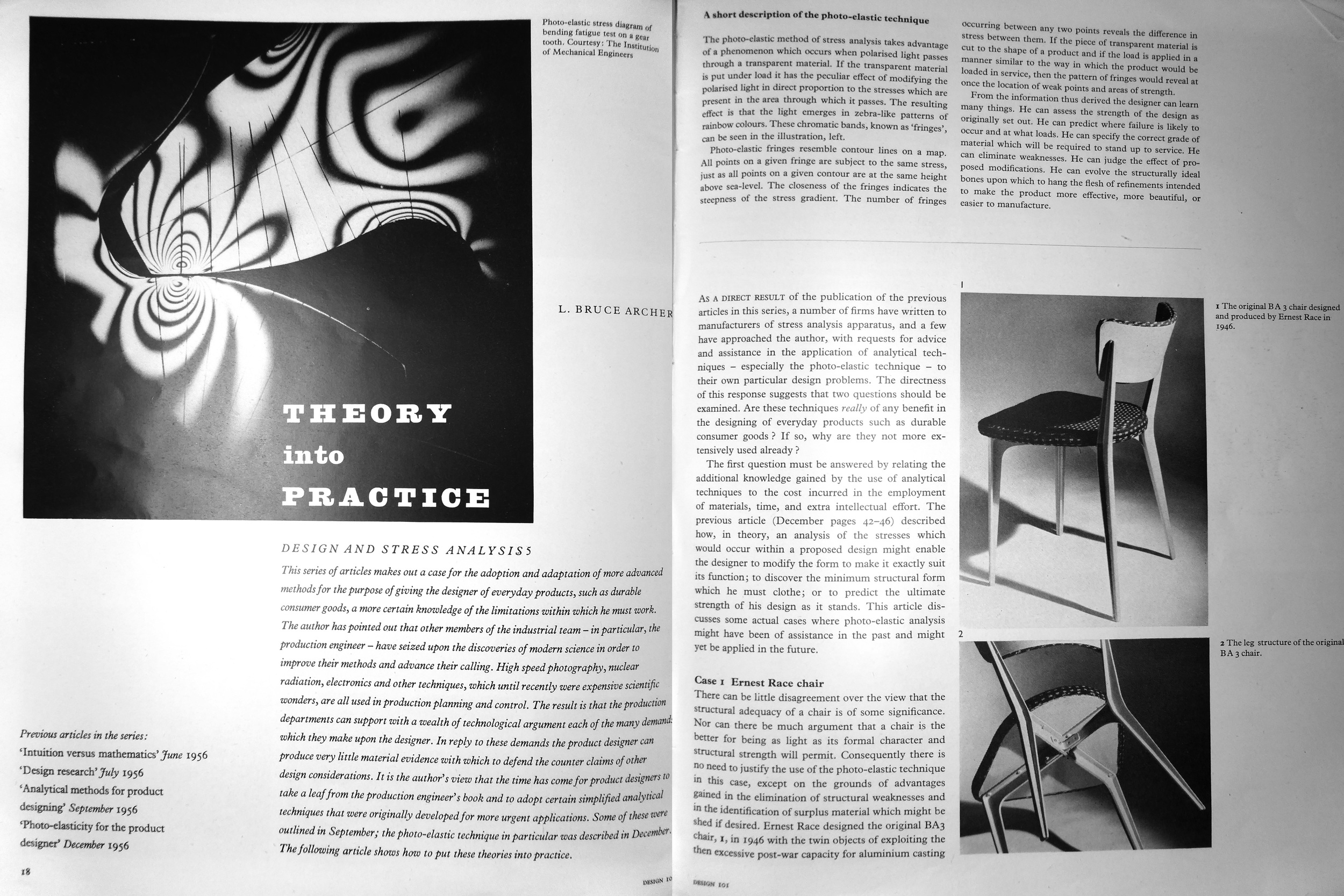


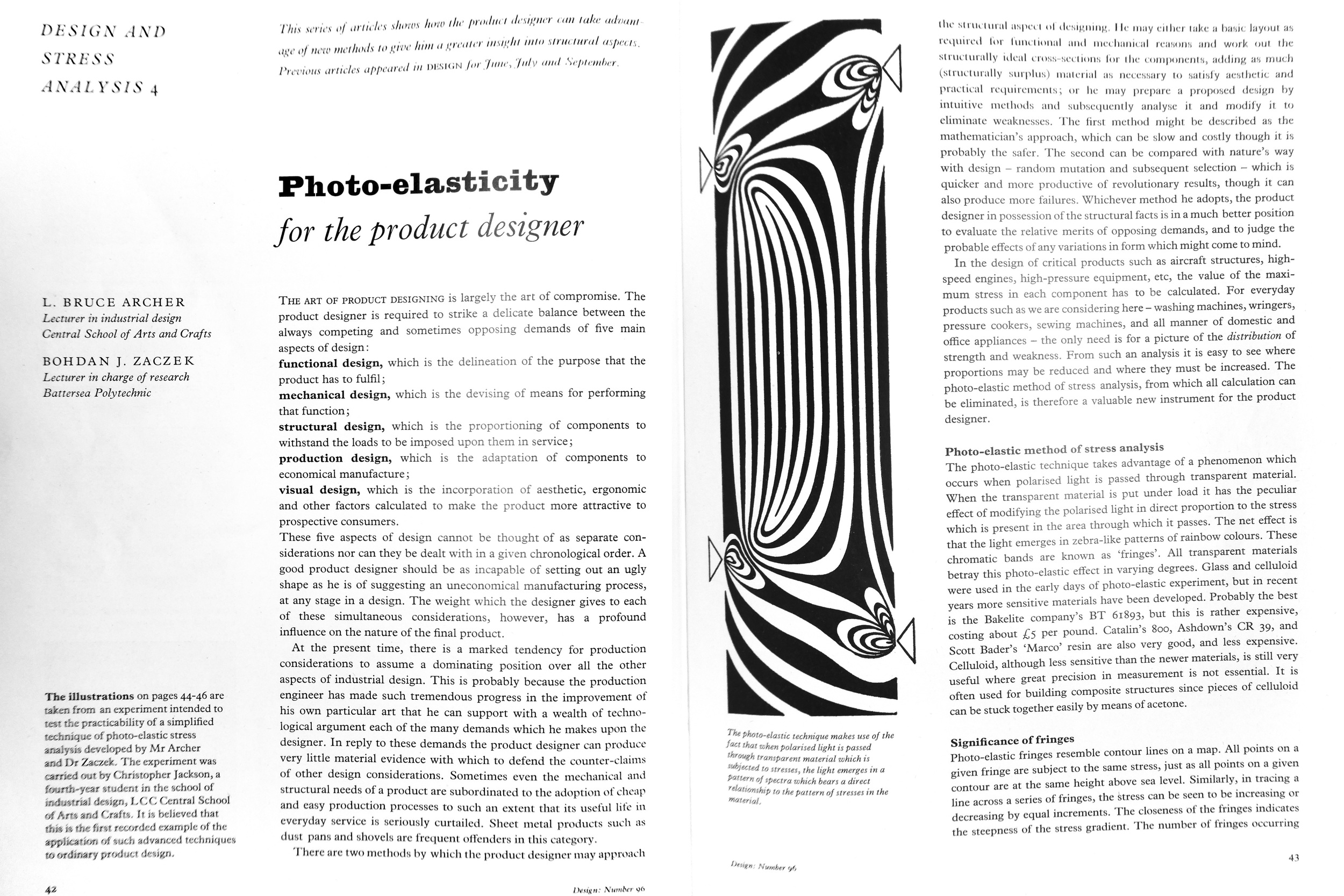
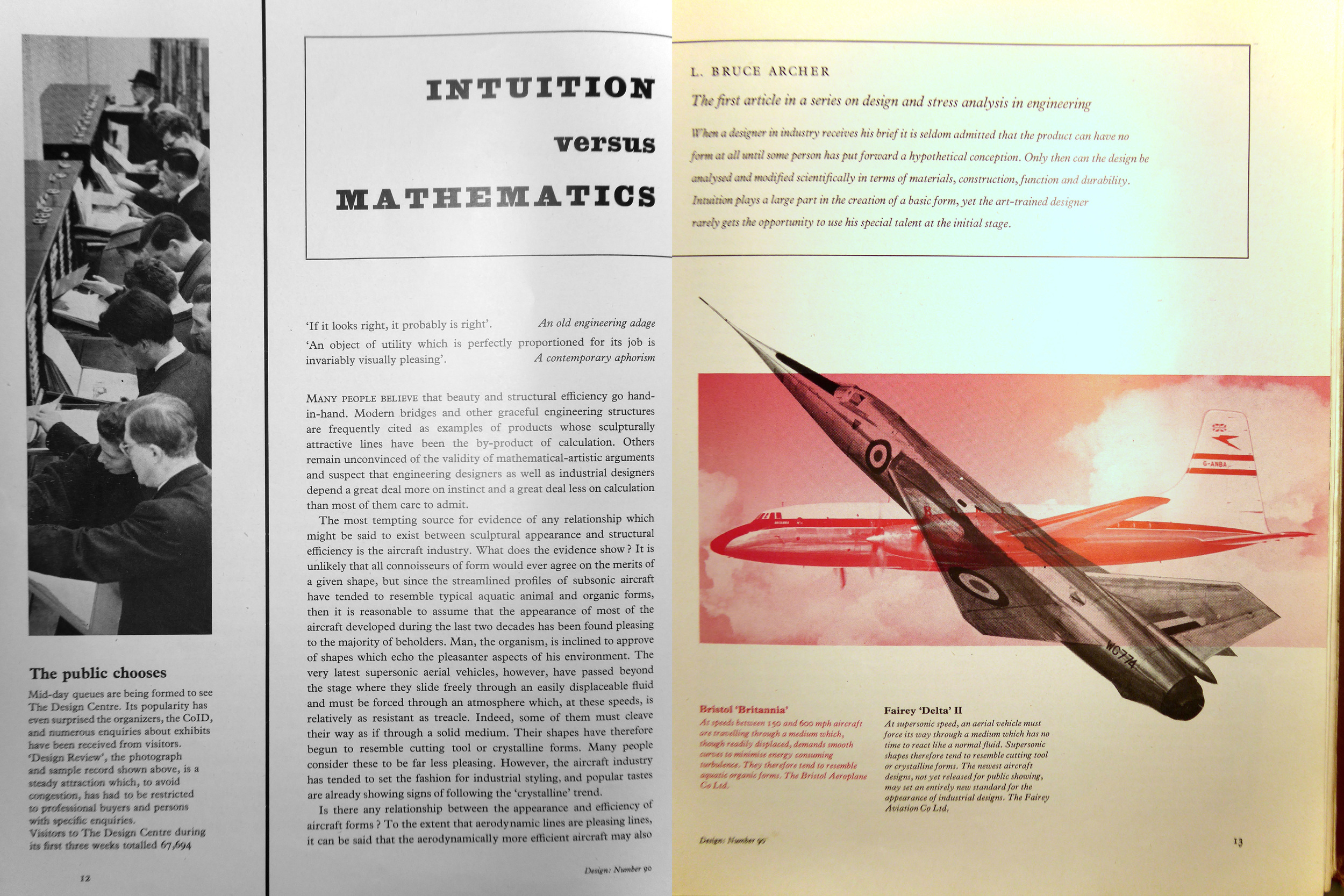
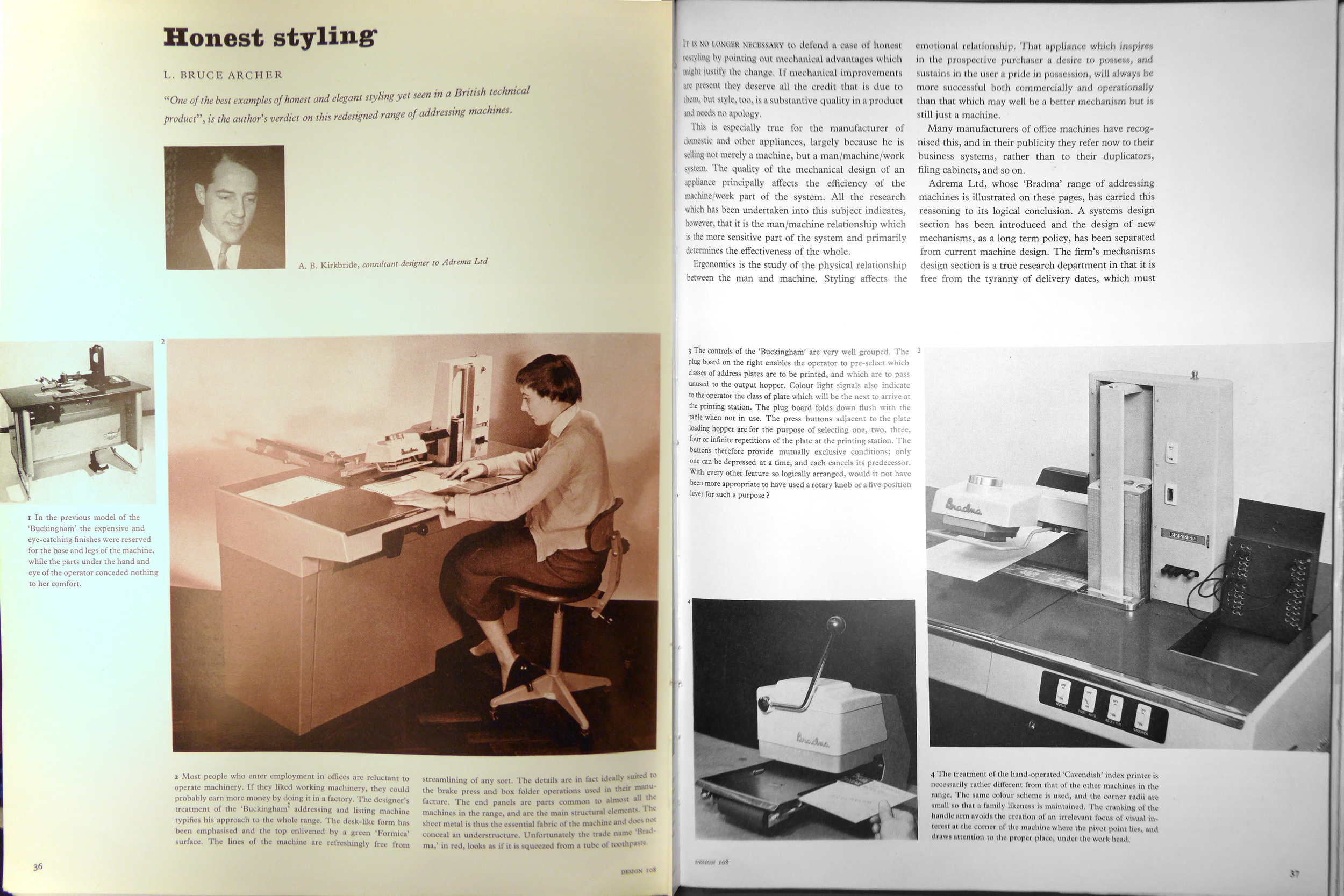

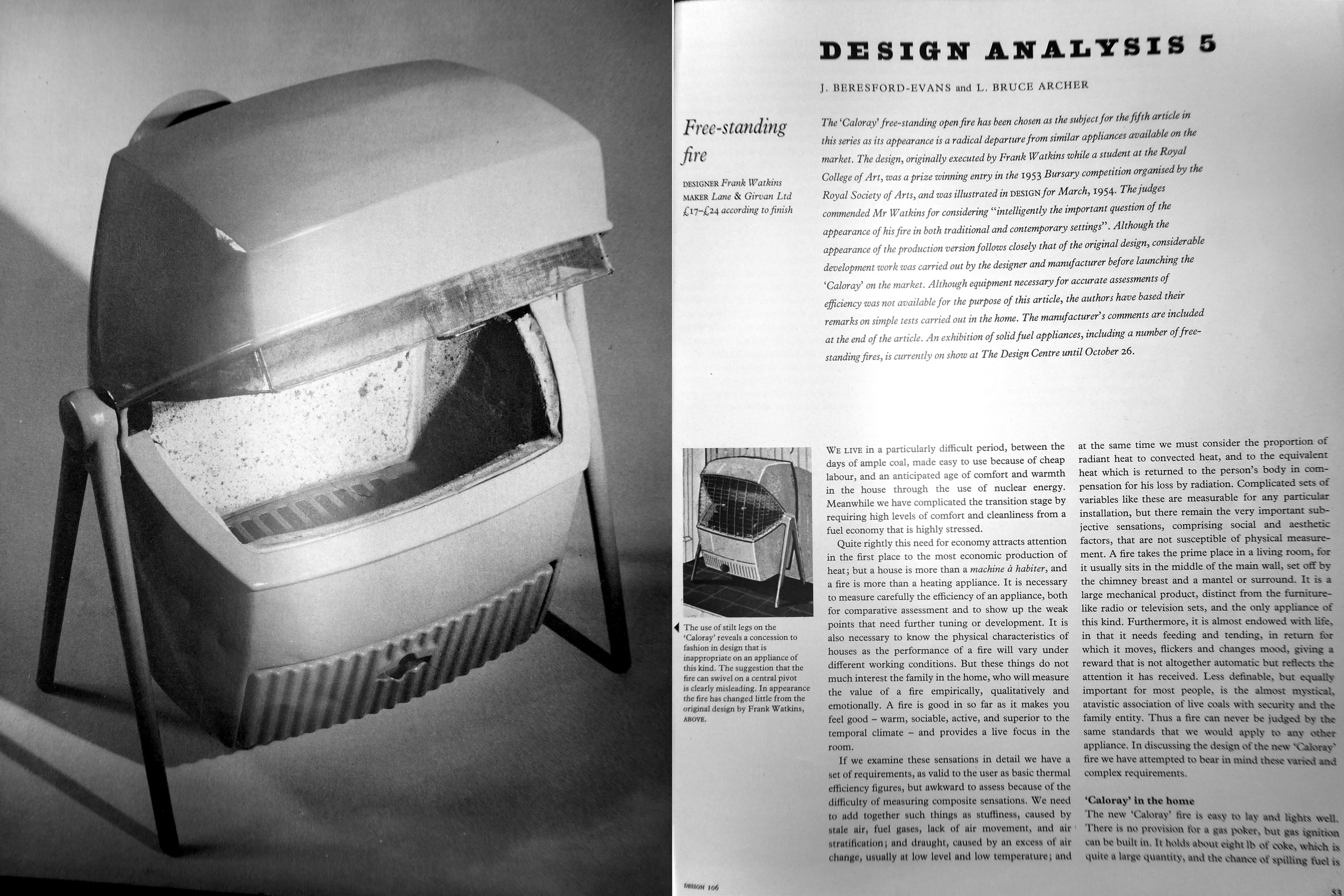
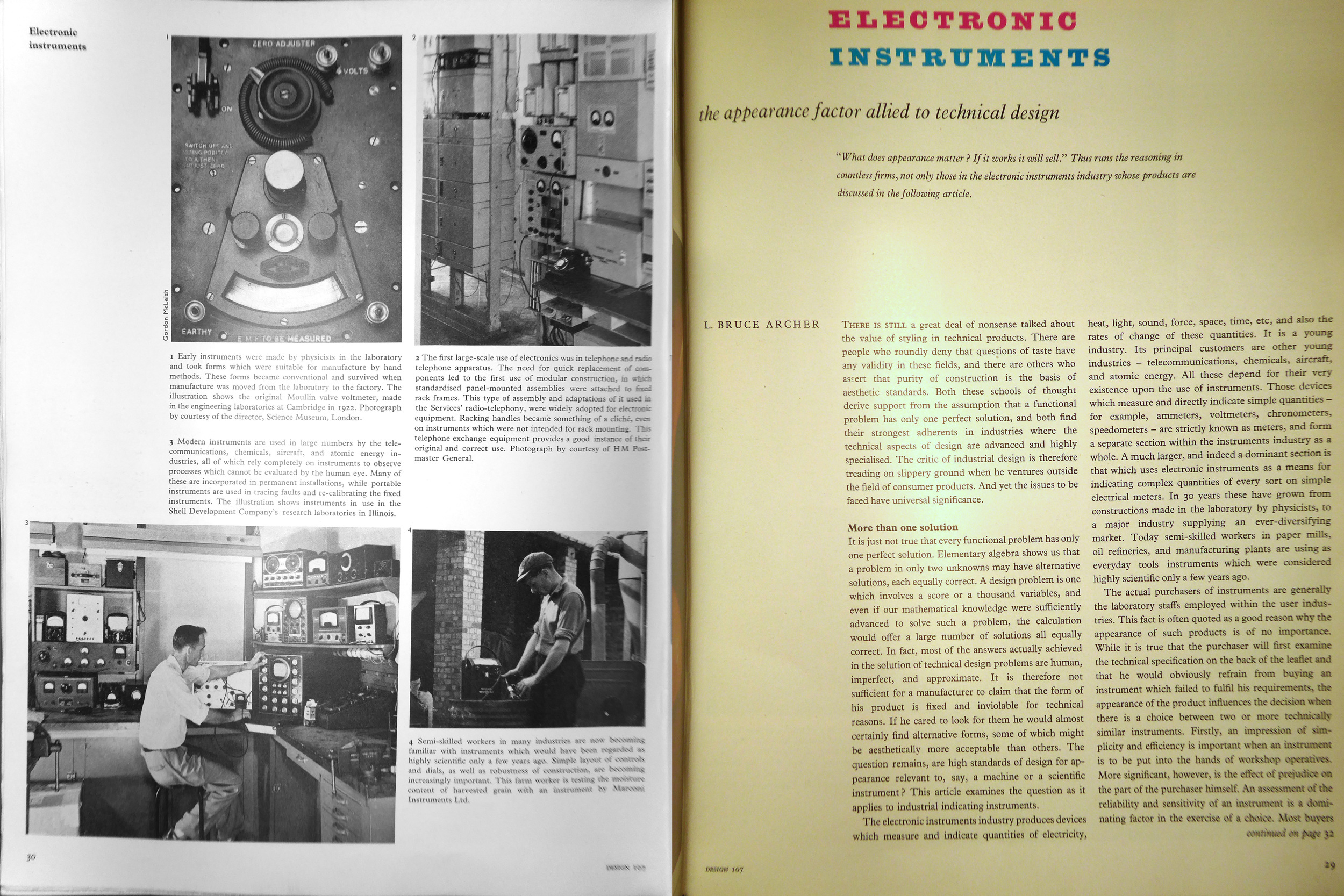
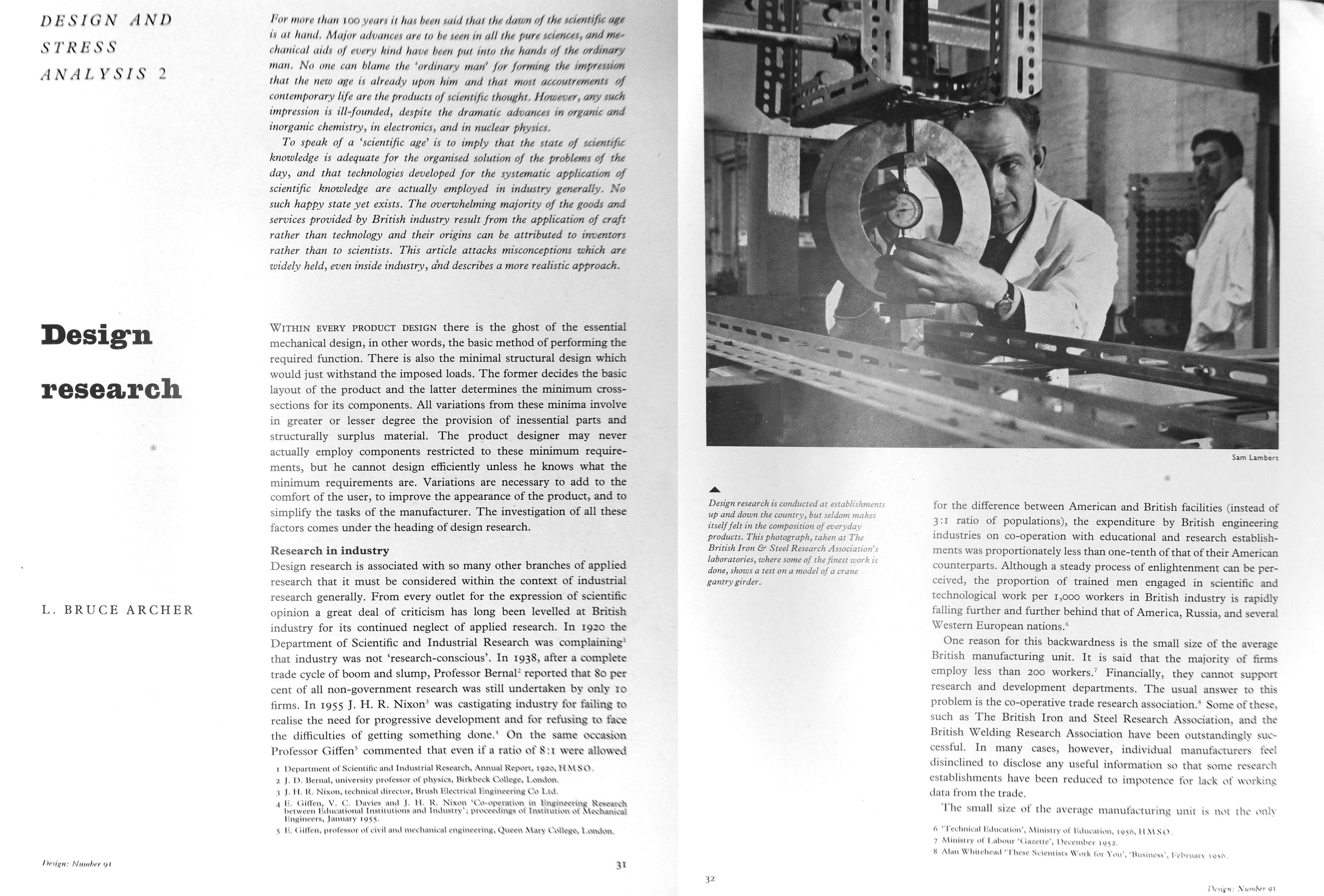

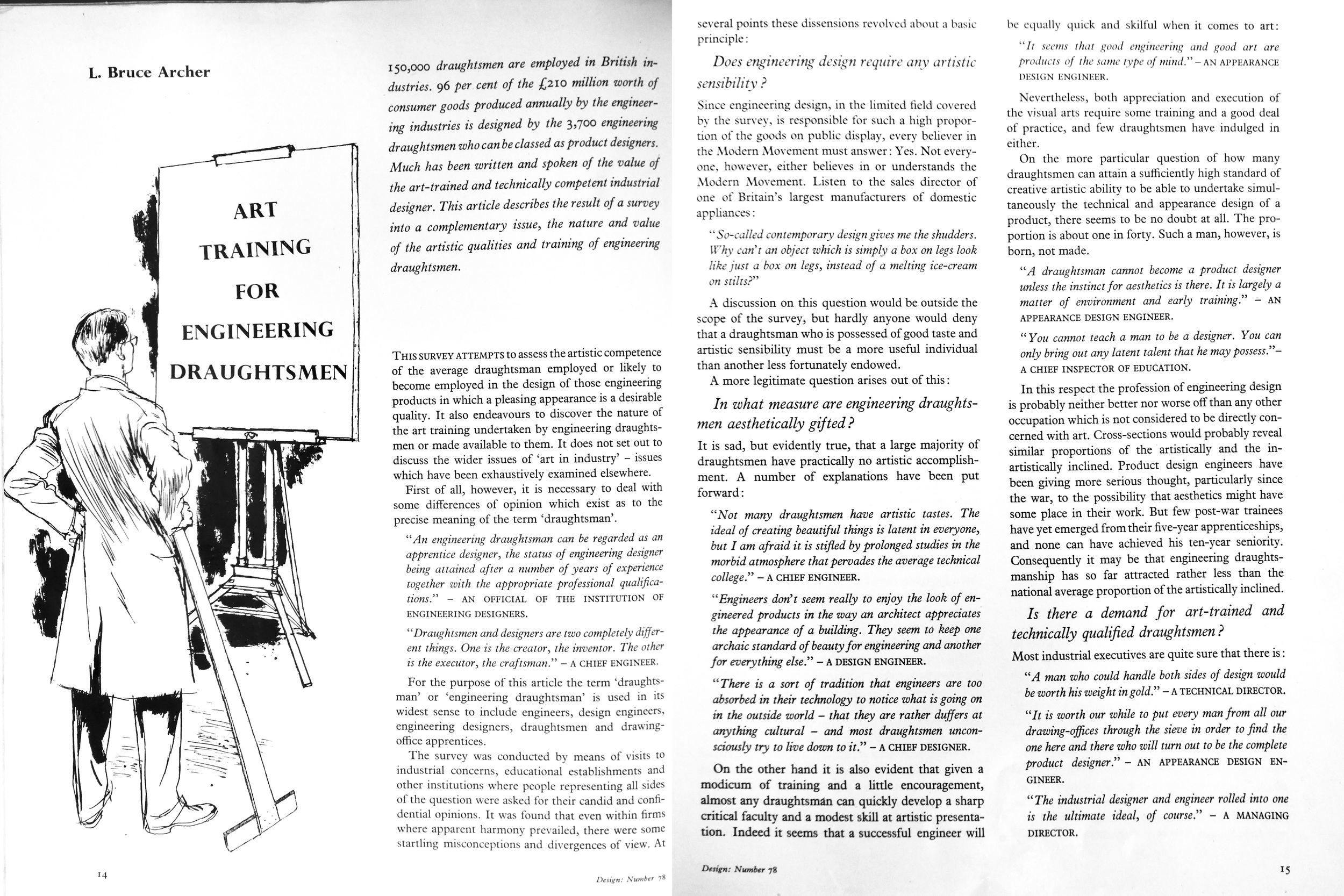
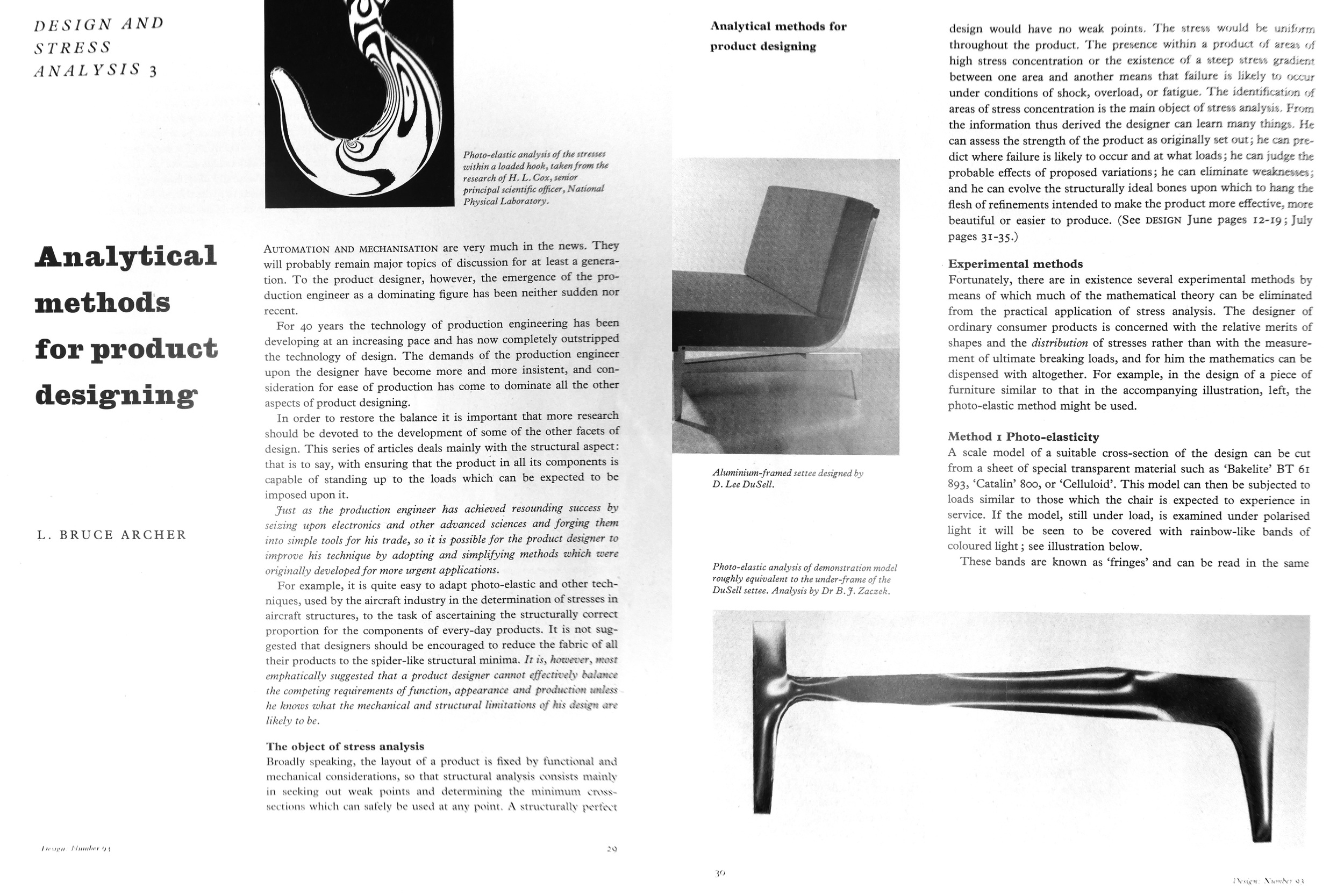
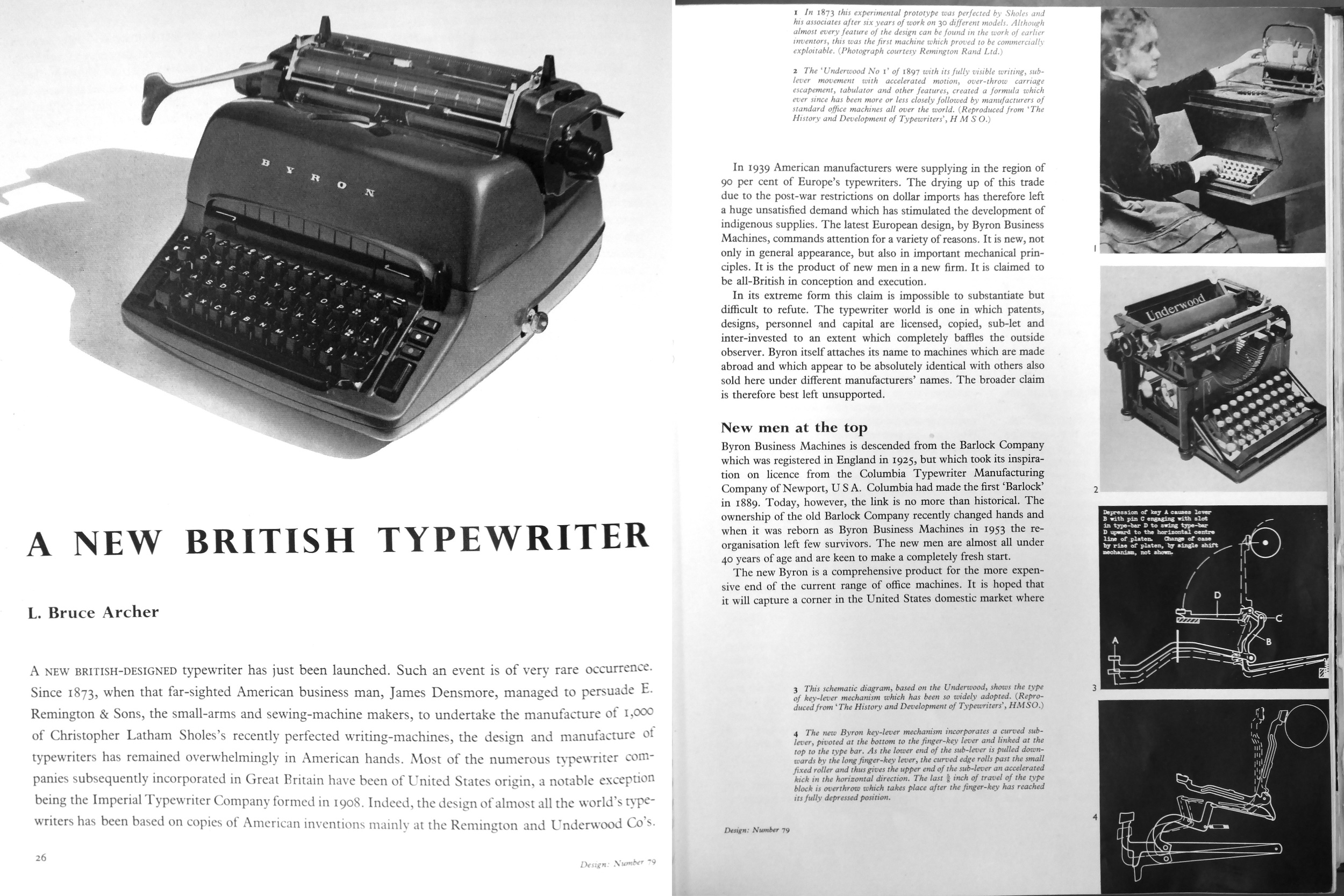
A selection of articles in Design magazine in the 1950s written by Bruce Archer.
The articles are represented by images of the opening double pages, taken from bound volumes in the RCA Library. We hope to make the full articles available at a later stage. These pages from Design are reproduced with the permission of University of Brighton Design Archives.
Archer, Design Magazine, Design Council
The Design Council began as the Council of Industrial Design in 1944 and had a key role in the Britain Can Make It exhibition at the V&A in 1946. It changed its name to the Design Council in 1972. The Council's magazine Design was published from 1949 to 1999.
Before he worked at the RCA, Archer was a frequent author of articles for Design, during the editorship of Michael Farr who took over from the founding editor Alec Davis in 1952. Key ideas emerge that later inform his work at the RCA. His first article (Archer 1954) argues the importance of both creative invention and profound technical knowledge in an industrial designer, a theme reprised a year later (Archer 1955). He then contributed a design analysis of a new typewriter (Archer 1955), highlighting poor British industrial innovation compared with competitors, a topic often revisited.
Four articles from 1956 (Archer 1956) begin a series again arguing against purely technical engineers working by rule of thumb: the industrial designer needs to be informed by both art and science. In the second article of the series, Archer complains about the low proportion of 'trained men engaged in scientific and technological work' compared to other nations (Archer 1956:32). Design Research is envisaged as including the calculation of the bounding space of optimal solutions - later a key part of Archer's thesis.
Archer notes how 'amateurism in management plays a very big part' in Britain's industrial failure (p.33). He is increasingly sanguine about science: 'Herein lies the brightest hope for progress in design research and for the recovery of the art of designing from its present intimidated state' (p.35). The final series article (Archer and Zaczek 1956) calls again for more rigour in designing - from whatever discipline.
Archer's next article (1957) again calls for more science in design, but still does not necessarily require a science of design. A series of articles with J. Beresford-Evans (later a visiting lecturer under Misha Black and a key styling designer with him of diesel locomotives for British Rail (Jackson 2013: 63)) show Beresford-Evans focusing on the aesthetic aspects while Archer subjects cooking pans (Beresford-Evans and Archer 1957), hand axes (Archer and Beresford-Evans 1957), and a free-standing fire (Beresford-Evans and Archer 1957) to a series of tests.
Archer continued writing design analysis articles into the next decade. The 1957 articles emphasise the need to combine subjective and objective evaluation. There is a focus on qualities that matter to people, 'almost atavistic' and 'endowed with life' in the case of the domestic hearth (p.53). In 'Honest Styling' (1957) Archer makes the telling remark that the manufacturer has considered 'not merely a machine, but a man/machine/work system'.
Every article, however much it might seem to focus on a single process or artefact, included wider observations on the nature of design, on industry and society. Archer thought these articles were a reason why Misha Black invited him to work at the RCA in 1961.
The Design Development Board: an idea before its time
Archer was a vital contributor to the work of the Design Council, as a member of Council for ten years and of many of its committees. In 1975, Archer offered a 'Proposal to set up machinery to aid the product development side of national economic recovery'. The proposed Design Development Board anticipates the much later UK Technology Strategy Board, though with more emphasis on design.
In this letter, Archer asks Sir Paul Reilly, Director of the Design Council, to have a word with the Prime Minister (Harold Wilson) or Tony Benn ( Secretary of State for Industry) about his proposal for a Design Development Board. The letter and accompanying 2-page proposal are in the Design Council Archive at University of Brighton. Reproduced here with permission.
Archer's Design Development Board was never adopted, probably because the Design Council thought that it itself already filled that function. Archer's Board however would have had a pro-active role in innovation:
Within the broad national strategy identified by the Design Development Board, and at the level of a whole industry, a particular enterprise or a product type, joint action groups or task forces would be set up, including representatives of government, employers, trade unions and consumer interests in each case, with instructions to engage whatever talent and skills are necessary to conceive, specify, design, develop and produce appropriate goods and services. (Archer 1975)
See ALso
For a discussion of Archer's seven-article series for Design see SYSTEMATIC METHOD: DESIGN MAGAZINE AND A DOCTORATE
articles by Archer in Design in the 1950s
L. Bruce Archer. Design 67, July 1954. Artist Versus Engineer. 13-16
L. Bruce Archer. Design 75, March 1955. Gumboots in the Drawing Office. 35-38.
L. Bruce Archer. Design 78, June 1955. Art Training for Engineering Draughtsmen. 14-18.
L. Bruce Archer. Design 79, July 1955. A New British Typewriter. 26-29.
L. Bruce Archer. Design 85, January 1956. Steel furniture for new markets. 35-38.
L. Bruce Archer. Design 90, June 1956. Intuition versus mathematics. 12-19.
L. Bruce Archer. Design 91, July 1956. Design research [Design and Stress Analysis 2]. 31-35.
L. Bruce Archer. Design 93, October 1956. Analytical methods for product designing [Design and Stress Analysis 3]. 29-33.
L. Bruce Archer and Bohdan J. Zaczek. Design 96, December 1956. Photo-elasticity for the product designer [Design and Stress Analysis 4]. 42-46.
L. Bruce Archer. Design 101, May 1957. Theory into practice. 18-23.
J. Beresford-Evans and L. Bruce Archer. Design 102, June 1957. Design analysis 3 - stainless steel cooking pans. 26-30.
L. Bruce Archer and J. Beresford-Evans. Design 104, August 1957. Design analysis 4 - general purpose axe. 20-25.
J. Beresford-Evans and L. Bruce Archer. Design 106, October 1957. Design analysis 3 – free-standing fire. 52-56.
L. Bruce Archer. Design 107, November 1957. Electronic Instruments. 29-33.
L. Bruce Archer. Design 108, December 1957. Honest Styling. 36-39.
Archer, Bruce. (1975) Proposal to set up machinery to aid the product development side of national economic recovery. A two-page document of 12 numbered paragraphs, Council of Industrial Design folder 3.10.1972, Registry title 'Professor L Bruce Archer [etc.]'
Jackson, Tanya. (2013) British Rail: The Nation’s Railway. The History Press.
Cybernetic Opportunity
Computing and Design
Cybernetic Opportunity
Computing and Design
The screen images are taken from the RCA yearbook of 1976, where they are described as 'computer generated wireline drawings of the area acute to a hospital bed, developed to determine the potential value of three-dimensional sketches to designers and their clients.'
The photo of the RCA building shows the sign for Event One in 1969.
The Department of Design Research pioneered the applications of computing at the RCA and, as we explain in the main article, responded to the widespread enthusiasm for computers as provocations to thought, rather than mere tools, of the 1950s and 60s.
Computing was applied - with mixed success - to the Hospital Bed project, using punched cards on the Atlas computer at Manchester University.
In 1970 the RCA Calendar announced that the Research Unit's 'membership is drawn from a variety of disciplines, ranging from industrial design to computer technology and psychology.'
In 1973 they announced 'permanent lines to the computer system at the Cambridge Computer-Aided Design Centre. The terminal centre houses an interactive graphic display linked to an Elliott 905 satellite computer, as well as a number of teletypes and graphic displays linked directly to the Atlas computer at Cambridge.'
A Landmark Event
Event One was the first exhibition of the Computer Arts Society (CAS). Conceived in 1968 and officially founded in 1969, CAS was the first practitioner-led organisation in Britain created 'to promote the creative use of computers in the arts, and to encourage the interchange of information in this area' (Computer Arts Society c.1969). Staged in March 1969 at the Royal College of Art, Event One included participants from architecture, fine art, computer programming and filmmaking among others, and offered a range of visitor experiences from sculpture and graphics to live performance and workshops. Catherine Mason (2009) suggests that 'Event One heralded the collaborative, cross-disciplinary nature of working which came to signify the early period of media arts in Britain, where interactivity and process were as equally valued as object.'
A Call to Action
In Design magazine in 1968, Patrick Purcell described the 'Cybernetic Opportunity' for computing in design. He pointed out the growth in adventurousness and flexibility in designing that computing ought to make possible, but also demanded that designers seize and control these opportunities.
Besides getting designers to reorganise and exploit the opportunities offered by computer-aided design, there is also a need for the trained designer who can collaborate with the computer scientist in developing new techniques and in validating prototype computer-aided design programs. To do this effectively, the designer must have well developed insights into computer science and technology. So the problem is essentially an educational one, and the solution lies in the new postgraduate courses being established for graduate designers. ...
... If designers do not make the effort, they should not expect the computer industry to do it for them. Nor should they complain if they lose the ability to communicate with the other members of the design and production team. (Patrick Purcell 1968).
George Mallen wrote in an obituary for Purcell in 2007:
He had early recognised the potential importance of computing and computer graphics to the art and design world and used his position as Senior Research Fellow in the Design Research Unit at the Royal College of Art with great flair to bridge the two cultures gap. He was one of that rare breed, a conduit for ideas and a selfless enabler of action. Sensitive to the needs of creative individuals and the institutional challenges of channeling that creativity he built a substantial portfolio of Science Research Council funded projects, no mean feat, at the RCA. I had the good fortune to work with him on these projects throughout the 1970s. (Mallen 2007).
On a lighter note, he also recalled:
Patrick's invaluable contribution to CAS was as enabler of the Society's inaugural exhibition, Event One, at the RCA in 1969. He was the interface for both the RCA and Imperial College. Heroically Patrick persuaded Prof Bill Elliot at IC [Imperial College] to loan, and the RCA to accept for a weekend, a PDP7 computer which had to be loaded onto a truck at Imperial College, driven 500 yards to the RCA, unloaded and installed in the Event One exhibition hall. I cherish the memory of Patrick, as always elegant of waistcoat, patrician of demeanour, marshalling the truck driver up the very narrow Jay Mews to the College back entrance. I suspect this was the first computer to penetrate the RCA.
not a Tool like any other
The mid twentieth century saw the proliferation of new ideas and interest in the inner workings of the brain and body, for example in neural networks and cybernetics, as well as advances in areas such as Operations (or Operational) Research (OR). Dramatic advances in thinking as well as technology emerged from World War II generating new discourses across a diverse range of disciplines, influencing pioneers of the use of computing technology in design such as Archer and his colleagues. They continued to pursue new theories and practice throughout their careers.
The adventurous, sometimes perhaps confused, spirit of the early days produced a variety of possible models for computing’s relationship to design (Gristwood and Boyd Davis 2014). The following summarises some of the key points of our 2014 paper, with updates and revisions.
Computing as a model for systematic designing
Operations, or Operational, Research (OR) emerged during World War II as a form of systematic decision-making using science-based mathematical and statistical approaches (Miller and Starr, 1960: 104), focusing on the relation between humans and systems or environments (Ackoff, 1961, p.6). Applied to design, OR emphasised sequential processes such as gathering data, and weighting it before proceeding with the design, in contrast to the perceived excess of intuition and tradition in standard design practice. It was his interest in systematic enquiry that led Archer to computing, as he saw its logic as a way of generating 'effective systematic methods for solving design problems' (Archer, 1963, p.1). He also saw ways of thinking about computing as 'valuable indicators of the sort of logic which might work even without a computer' (ibid).
The influence of cybernetics
While OR emerged from the management of man-machine processes, cybernetics originated as much in the feedback and control mechanisms of war machinery as in human contexts. Wiener’s 1948 idea (Wiener 1961) attracted interest from diverse disciplines. In design, the influence of cybernetics involved a particular emphasis on feedback and auto-reconfiguring, supporting a model where design does not follow research, but interacts with it. Figures such as Beer, Pask and Ashby in Britain were particularly influential on researchers such as Archer – who cited all three in the bibliography to his thesis (Archer, 1968) – and George Mallen, discussed below. In a series of works over several years, Glanville (eg. 2007) continued to pursue the relationship between cybernetics and design.
Reflexive computational models
If the use of OR or cybernetics harnessed computationally-inspired methods to improve design, the reflexive approach to computing asked the opposite question: what can we learn about designing by modelling it computationally? There are clear signs of such an approach in Archer’s work: he claimed only to undertake major design projects like the hospital bed in order to augment his understanding of design (C Frayling, pers. comm. to S. Boyd Davis. 10 June, 2013). Ashby’s Design for a Brain (1960) exemplifies similar reflexive thinking within cybernetics.
Qualitative computing
Archer (1972) discusses two complementary uses of computing in a short but important paper, ostensibly about architecture but with relevance to all design, concerned with what he terms the quantitative and qualitative.
The main point of the paper was to address this key area as one where computers were not being used – 'the patterns of goals and values of the people concerned' and 'the relations between the attributes to which people attach value, and the objectives which they are trying to pursue' (op. cit. p.4). It concludes with an eager appeal for computer systems to be designed and used to support the qualitative, humanistic, ethical practices that architects and designers pride themselves on: he saw 'no reason why computer models should not be built for the handling of qualitative considerations.' (p.3)
Contextual computing
Contextual computing aimed to use information technology to provide knowledge relevant to the designer at the point of action. John Lansdown, who worked at the Department of Design Research from 1983 to 1986 and had often encouraged its computing activities prior to that, assumed that 'we cannot design anything without proper information and knowledge' and suggested that design failures do not necessarily amount to bad designing, but bad working practices (1989:5). The computer was suggested as a facilitator to improve the 'designer's information environment'. With the computer acting as a source of relevant information, the designer would have all the necessary knowledge throughout the process of designing.
Lansdown was originally an architect who began investigating the potential of OR and mathematics in architecture in 1960, which subsequently led him to computing as it became more available. He was a founder with George Mallen of System Simulation Limited, in 1977, a “private research and development company which was originally set up to further the research and computing aspirations of the architectural practice” (Lansdown, 1989). He innovated throughout his career with a diverse range of interests including CAD, Artificial Intelligence, and computer choreography as well as writing regular columns for the Computer Bulletin, mostly under the title Not Only Computing - Also Art, from 1974-1992. Like Archer, he was influential through serving on important bodies, including the British Computer Society Council (1980-83), and from the early 1970s to the 1990s had influential roles in professional bodies where he was credited with creating a “world leading strategy for developing Computer Aided Architectural Design in UK Universities” (CompArt Database of Digital Art, n.d). He was as interested in art and performance as he was in architecture and design. He was a founder member of the Computer Arts Society (CAS) along with George Mallen and Allan Sutcliffe, and sought to promote a cross-disciplinary understanding of computers.
Educating the designer: simulation
A landmark of early computing for design was Ecogame, developed by a team under George Mallen, by request of the British Equipment Trade Association, for the Computer ’70 trade exhibition (Mallen, 2008:194 ). This aimed, not to relieve the designer of hand work, but to illuminate the mind. A computer-managed simulation with output in the form of slide-projected images on the interior of a physical dome, it enabled the user to explore what-if scenarios with a given set of ecological resources.
Mallen graduated in physics and was originally an aeronautical engineer at Farnborough; he worked part time in Archer's department from 1970, and with Lansdown co-founded System Simulation in 1977 (where he recently retired as director of research). Like many of his contemporaries Mallen disregarded discipline boundaries; while Ecogame was initially seen by many as an artwork (Edmonds and Franco 2010), and the idea conceived at a meeting of the Computer Art Society (Mallen, 2008:194), a version was commissioned for the First European Management Forum in Davos in 1971 (Lambert, 2011). As Lansdown (1988) remarked 'The ground-breaking Ecogame exhibit at Olympia in 1970 showed how computer art could change our way of thinking about environmental problems (and, incidentally, about computing too)'. Mallen commented in retrospect that 'it was very high risk but those of us involved were hopelessly optimistic and totally committed, which are key factors in an innovation' (Mallen, 2008:194).
Dialogical computing
The influential book Soft Computing: Art and Design (Reffin Smith, 1985) set computing in a broad intellectual context. The 'softness' of the title is reflected in the author’s emphasis on the qualitative and it is worth recalling that he too was situated in Archer’s department at the RCA as a research fellow, and college tutor from 1979-1984, principally to educate the college’s own students in computing.
Reffin Smith remarks that 'we ought sometimes to consider the use of computers to handle representations, and we ought to be aware of what's going on when we do that.' (p.102). It is notable that the word 'representations' does not limit the discussion to the visual or even the sensory; it may just as well refer to ideas perhaps expressed in language. An apparently trivial example of computer use offered by Reffin Smith is a 52-line program in the simple computer language BASIC (p.57-8). The program invites the user to name an entity, for example 'chair', and to assign six descriptive attributes to it. The user must then provide six alternatives to each attribute, 36 in all. The program responds with a new description of the original entity using six attributes chosen at random from the alternative sets the user just provided. In terms of design thinking, this is no more than the mechanisation of a creativity prompting scheme, less sophisticated computationally even than ELIZA (Weizenbaum, 1966) of twenty years earlier, but the point is to provoke reflection. Like many of his contemporaries, Reffin Smith was interested in the nature of designing, the nature of computing, and the potential relations between them.
Computers as tools
One of the most obvious applications of computational machinery has been to relieve humans of tedious, error-prone, repetitive tasks, an approach with origins in pre-computer devices such as the Jacquard loom and Tull’s seed drill.
Archer discusses such uses of computing in the paper on the qualitative discussed above (Archer 1972). He assesses claims that 'the computer could free the architect from burdensome preoccupation with (largely quantitative) chores and thus permit him to spend more of his time and energy on the handling of the (mainly qualitative) broader issues' (p.1). Archer expresses strong reservations, based on his examination of computing in engineering design, as to whether such freeing does in fact occur. Perhaps more sanguine than Archer, Lansdown thought that by using the computer to do easily what might be difficult to do by hand, 'the effect on the creative process can be profound' (1985, p.19).
There is no doubt that the computer has subsequently augmented or replaced many craft operations, usually on an assumption that (1) time will be saved and (2) the saved time will be spent on more rewarding aspects of designing. This notion of the computer as 'just a tool', one that is no more important intellectually than a trowel, an airbrush or a scalpel, but is rather a prosthetic extension of the hand, is arguably the dominant one of our time.
The categories of early design computing discussed above, however, are predominantly concerned with the designer’s mind. They emerged from an optimistic tradition in relation to computing where the machine augments mental capability, exemplified by Bush’s As We May Think (1945), Engelbart’s Augmenting Human Intellect (1962), Nelson’s Literary Machines (1980) and Berners-Lee’s Information Management: a proposal (1989). These key texts are not primarily about easing hand-work. If computers here are tools, they are tools for the mind.
Dissenting voices
In addition to his disenchantment with Design Methods, Christopher Alexander was emphatic in his condemnation of computing:
People who are messing around with computers have obviously become interested in some kind of toy. They have very definitely lost the motivation for making better buildings. (Alexander 1971)
Ackoff, Russell L. (1961) Progress in Operations Research. Volume 1. New York: John Wiley and Sons.
Alexander, Christopher (1971) State of the Art in Design Methodology: Interview with C. Alexander. DMG [Design Methods Group] Newsletter 5(3). 3-7.
Archer, L. Bruce (1963) 'Systematic methods – friend or foe?' Lecture to Architectural Association School of Architecture, Thursday 26 September 1963. Unpublished lecture notes, Bruce Archer Archive, Royal College of Art, London.
Archer, L. Bruce. (1968) The structure of design processes. Doctoral thesis, Royal College of Art, London, 1968. British Library Shelfmark: Document Supply DRT 484530. Available on Ethos.
Archer, L.Bruce (1972) Computers, design theory and the handling of the qualitative Proceedings of the International Conference on Computers in Architecture, University of York, 20-22 September 1972. Read this paper online.
Ashby, W Ross (1960) Design for a Brain: the origin of adaptive behaviour. London: Chapman and Hall.
Berners-Lee, Tim (1989) Information Management: A Proposal. Geneva: CERN. http://www.w3.org/History/1989/proposal.html (accessed 14 June 2016).
Boyd Davis, Stephen and Gristwood, Simone. (2016 - in press) Computing, Design, Art: Reflections on an Innovative Moment in History. In: Proceedings of the Third International Conference on the History and Philosophy of Computing (HaPoC 2015), Pisa, Italy, 8-11 Oct 2015. Springer.
Bush, Vannevar (1945) As We May Think. The Atlantic Monthly, July 1945. http://www.theatlantic.com/magazine/archive/1945/07/as-we-may-think/303881/ (accessed 14 June 2016).
Computer Arts Society. (c1969) Computer Arts Society: Aims, promotion leaflet drafted by Alan Mayne (undated c.1969). See the leaflet on the CACHe website.
Edmonds, Ernest and Franco, Francesca (2010, February 3) Art of Conversation. Symposium CAT 2010: Ideas before their time : Connecting the past and present in computer art. British Computer Society, London. 24-31.
Engelbart, Douglas C. (1962). Augmenting Human Intellect: A Conceptual Framework. (SRI Summary Report AFOSR-3223. SRI Project No. 3578). http://www.dougengelbart.org/pubs/augment-3906.html (accessed 14 June 2016).
Glanville, Ranulph (2007) Try again. Fail again. Fail better: the cybernetics in design and the design in cybernetics. Kybernetes 36 (9/10). 1173-1206.
Gristwood, Simone and Boyd Davis, Stephen. (2014) The Reappearing Computer: the past and future of computing in design research. In: Proceedings of DRS 2014: Design’s Big Debates. Conference of the Design Research Society, Umeå, 16-19 June 2014. http://drs2014.org/en/publications/ (accessed 14 June 2016). 618-632.
Lambert, Nick (2011) Chair’s Letter, Page: the Bulletin of the Computer Arts Society (Spring, 2011). 1.
Lansdown, R. John (1985) 'Computing in the Creative Professions' John Lansdown Archive, Middlesex University, JLA/1/1/17 Box 1
Lansdown, R. John (1988) Graphics, Design and Artificial Intelligence. In: Earnshaw (Ed.) Theoretical Foundations of Computer Graphics and CAD. Berlin, Springer.
Lansdown, R. John (1989) The designer's information environment: some tools for design knowledge manipulation, Civil Engineering Systems 6(1-2). 5-10.
Mallen, George (2007) Patrick Purcell (1929 - 2007) Leonardo Electronic Almanac 2007. http://leoalmanac.org/resources/luminaries/ppurcell.asp (accessed 14 June 2016).
Mallen, George (2008) Bridging Computing in the Arts and Software Development. In: P Brown, C Gere, N Lambert and C Mason (Eds.) White Heat, Cold Logic. British Computer Art 1960-1980. Cambridge, Massachusetts, MIT Press. 191-202.
Mason, Catherine (2009) The Fortieth Anniversary of Event One at the Royal College of Art" Proceedings of the 2009 international conference on Electronic Visualisation and the Arts, British Computer Society, 2009. http://www.bcs.org/upload/pdf/ewic_ev09_s5paper1.pdf (accessed 14 June 2016). 117-128.
Miller, David W. and Starr, Martin K. (1960). Executive Decisions And Operations Research. Englewood Cliffs, NJ: Prentice Hall.
Nelson, Ted (1980) Literary Machines. Sausalito CA: Mindful Press.
Purcell, Patrick (1968) Cybernetic Opportunity. Design 238 . 61-63.
Reffin Smith, Brian (1985) Soft Computing: Art and Design. Wokingham UK: Addison-Wesley.
Weizenbaum, Joseph (1966), ELIZA: A Computer Program For the Study of Natural Language Communication Between Man And Machine, Communications of the ACM 9(1).
Wiener, Norbert (1961) Cybernetics, or Control and Communication in the Animal and the Machine, 2nd edition, Cambridge, MA: M.I.T. Press.
Systematic Method
DeSign Magazine and a Doctorate
Systematic Method
DeSign Magazine and a Doctorate
Archer's series of articles for Design magazine in the 1960s, Systematic Method for Designers, was reprinted by the Design Council as an offprint due to demand, and translated into other languages. Systematic Method formed the basis of Archer's 1968 doctoral thesis The Structure of Design Processes.
Pages from Systematic Method are reproduced here with the permission of the Design Archive at the University of Brighton.
Bruce Archer published a series of Articles in Design magazine in the 1960s, reflecting his thinking on the multiple factors in design and the need to approach them in a methodical way. This was under the third editorship of Design, that of John E Blake.
As we discuss here, Archer and his contemporaries were heavily influenced by the scientific practices embedded in Operational Research, Organisation and Methods, and computing.
The original Design articles comprising Systematic Method, published during 1963-64, were:
One: Aesthetics and logic
Systematic methods of problem solving are becoming increasingly necessary as an aid to the designer. In this article, the first of a new series, the author sets out the theoretical background to one particular approach which he has developed - subsequent articles will describe the method and illustrate examples (Archer 1963a).
Two: Design and system
This article continues the analysis of the act of designing begun in the first of the series (DESIGN 172/46-49), and here concentrates on that creative element in the process which typifies a human rather than a mechanical act (Archer 1963b).
Three: Getting the brief
The article describes the first stage of the design method, and provides a check list and an example of the method in use (Archer 1963c).
Four: Examining the evidence
The author continues his explanation of a logical approach to designing and discusses the theory and practice of reconciling solutions to sub-problems (Archer 1963d).
Five: The creative leap
The author describes the moment when the process of designing breaks away from a step-by-step method and can only be continued by an act of the designer's imagination (Archer 1964a).
Six: The donkey work
The previous articles in this series have analysed the mental processes by which a designer conceives the basic idea for a solution to his problem. This article describes how this basic idea is realised (Archer 1964b).
Seven: The final steps
In the concluding article of the series, the author describes how, once having obtained a solution to his design problem, the designer should communicate the solution to all those concerned (Archer 1964c).
The approach of 'reconciling solutions to sub-problems' (article 4) is characteristic of Archer's methods. His approach to a complex problem was almost always to reduce it to component, soluble, sub-problems. He also adopted this approach when lecturing, which some students apparently found very dull! Looking at the systematic method, it is easy to feel the force of Archer's remark that 'the logic by which computers work, and the clarity and fullness of expression which is necessary to prepare a real-world problem for computing, are valuable indicators of the sort of logic which might work even without a computer' (Archer 1963e).
Appendix One of 'Systematic Methods', in the Design offprint from 1965, offered a 'Check List for Product Designers'. It extended over 14 pages (16-29). Douglas Tomkin, a research in the RCA Department of Design Research later reminisced:
I vividly recall the first day I met Bruce. It was early 1969 and I was there for a job interview. Pauline, Bruce's secretary,
ushered me into his office. I was seriously nervous. As a 23 year old Aussie fresh off the boat, I had read of the hospital bed project in the colonies and been impressed. More over I had just spent the last 15 minutes studying what appeared the definitive design process in the form of a chart stretching the length of the corridor. The man I was about to see was obviously the God of Design. (CoCreaThink 2005, emphasis added).
The principal difference between the 'Systematic Method' series and Archer's doctoral thesis, The Structure of Design Processes (Archer 1968) is that the articles omit many of the mathematical formulae that appear in the thesis. Archer or the editor Blake must have realised that these would alienate and perplex many readers.
Archer celebrating the award of his Doctorate on the roof of the Royal College of Art, probably in 1968. From the Agnew Archive, Royal College of Art, London.
Systematic Methods in the Firing Line
The systematic approach to design methods has been discussed by Cross (1993; 2007), Glanville (1999), Dorst (2003), Bayazit (2004), Margolin (2010), Pavitt (2012) and many others.
Two early figures to rebel against the systematic methods movement were John Chris Jones and Christopher Alexander. Jones complained, in an article for Design the year after Systematic Method appeared, of 'substantial but not always very practical publications,' 'both vague and dogmatic, [with] little reference to the work of practising designers' (Jones 1966). He may have been referring to Archer.
Jones said later about Design Methods:
Rationality, originally seen as the means to open up the intuition to aspects of life outside the designer's experience, became, almost overnight, a toolkit of rigid methods that obliged designers and planners to act like machines, deaf to every human cry and incapable of laughter. (Jones 1980:173).
Alexander famously said in 1971, when asked what areas future work in design methodology should centre on:
I would say forget it, forget the whole thing. Period. (Alexander 1971).
Archer's own view on systematic method
Later, Archer came to regret some aspects of the Systematic Method. He felt that he had 'wasted a lot of time trying to bend the methods of operational research and management techniques to design purposes' (Archer 1979). He now offered a dramatically different approach: humanities, science and design were equal points of a triad of disciplines. Archer announced that 'there exists an under-recognised but definable third area of human knowing, additional to numeracy and literacy' (1978: foreword).
We discuss the development of Archer's thinking before, during and after the Systematic Method period in our paper for DRS 2016 (Boyd Davis and Gristwood 2016).
See Also
For Archer's diagram of the triad of disciplines see THE DRS AND THE DDR: COLLABORATIONS AND CONNECTIONS
For Archer's earlier articles in Design leading up to Systematic Method, see INDUSTRY AND POLICY: DESIGN RESEARCH AND THE DESIGN COUNCIL
Alexander, Christopher. (1971) 'State of the Art in Design Methodology.' Alexander interviewed by Max Jacobson. DMG [Design Methods Group] Newsletter 5(3) (March 1971): 3-7.
Archer, L. Bruce. 1963a. Systematic method for designers: Part one: Aesthetics and logic. Design 172. April 1963. 46-49.
Archer, L. Bruce. 1963b. Systematic method for designers: Part two: Design and system. Design 174. June 1963. 70-74.
Archer, L. Bruce. 1963c. Systematic method for designers: Part three: getting the brief. Design 176. August 1963. 52-57.
Archer, L. Bruce. 1963d. Systematic method for designers: Part four: Examining the evidence. Design 179. November 1963. 68-72.
Archer, L. Bruce. 1963e. Lecture to Architectural Association School of Architecture. Unpublished typewritten notes. L Bruce Archer Archive, Royal College of Art, London.
Archer, L. Bruce. 1964a. Systematic method for designers: Part five : the creative leap. Design 181. January 1964. 50-52.
Archer, L. Bruce. 1964b. Systematic method for designers: Part six: The donkey work. Design 185. May 1964. 60-63.
Archer, L. Bruce. 1964c. Systematic method for designers: Part seven: The final steps. Design 188. August 1964. 56-59.
Archer, L. Bruce. 1968. The structure of design processes. Doctoral thesis, Royal College of Art, London, 1968. British Library Shelfmark: Document Supply DRT 484530. Available on Ethos.
Archer, L. Bruce. 1978. Time for a Revolution in Art and Design Education. RCA Papers No. 6. Royal College of Art, London.
Archer, L. Bruce. 1979. Whatever became of Design Methodology? Design Studies 1(1). July 1979. 17-20.
Bayazit, Nigan. 2004. Investigating Design: A Review of Forty Years of Design Research. Design Issues 20(1). 16-29.
Boyd Davis, Stephen and Gristwood, Simone. 2016. The Structure of Design Processes: Ideal and Reality in Bruce Archer’s 1968 Doctoral Thesis. Proceedings of DRS 2016, Design Research Society 50th Anniversary Conference. Brighton, UK, 27-30 June 2016.
CoCreaThink. 2005. CoCreaThink Design Community. A set of informal reminiscences of Bruce Archer on the occasion of his death. http://thinkdesign.cgu.edu.tw/c2t/pop_printer_friendly.asp?TOPIC_ID=1151. Accessed 6 May 2016.
Cross, Nigel. 1993. A History of Design Methodology. In M. J. de Vries et aL (eds.), Design Methodology and Relationships with Science. Kluwer Academic Publishers. 15-27.
Cross, Nigel. 2007. Editorial: Forty Years of Design Research. Design Studies 28(1). 1-4.
Dorst, C.H. (Kees). 2003. The problem of design problems. In: E. Edmonds & N.G. Cross (Eds.), Expertise in Design, Design Thinking Research Symposium 6. Sydney, Australia: Creativity and Cognition Studios Press.
Glanville, Ranulph. 1999. Researching Design and Designing Research. Design Issues 15(2). 80-91.
Jones, John Christopher. (1963) 'A Method of Systematic Design.' In: Jones, Christopher J. and D.G. Thornley (eds.) Conference on Design Methods. Oxford: Pergamon Press. 53-73.
Jones, John Christopher. 1966. Design methods compared 1: Strategies. Design 212. 32-35.
Jones, John Christopher. (1980) '… in the dimension of Time: thoughts about the context of designing' Design Studies 1(3). 172-176.
Margolin, Victor. 2010. Design research: Towards a history. In Proc. Design and Complexity - Design Research Society Conference, July 7-9, 2010 at School of Industrial Design, Université de Montréal, Montreal, Canada.
Pavitt, Jane. 2012. Input-Output: Design Research and Systems Thinking. In: McCarthy, F. (ed.) The Perfect Place to Grow: 175 years of the Royal College of Art. 129-139


